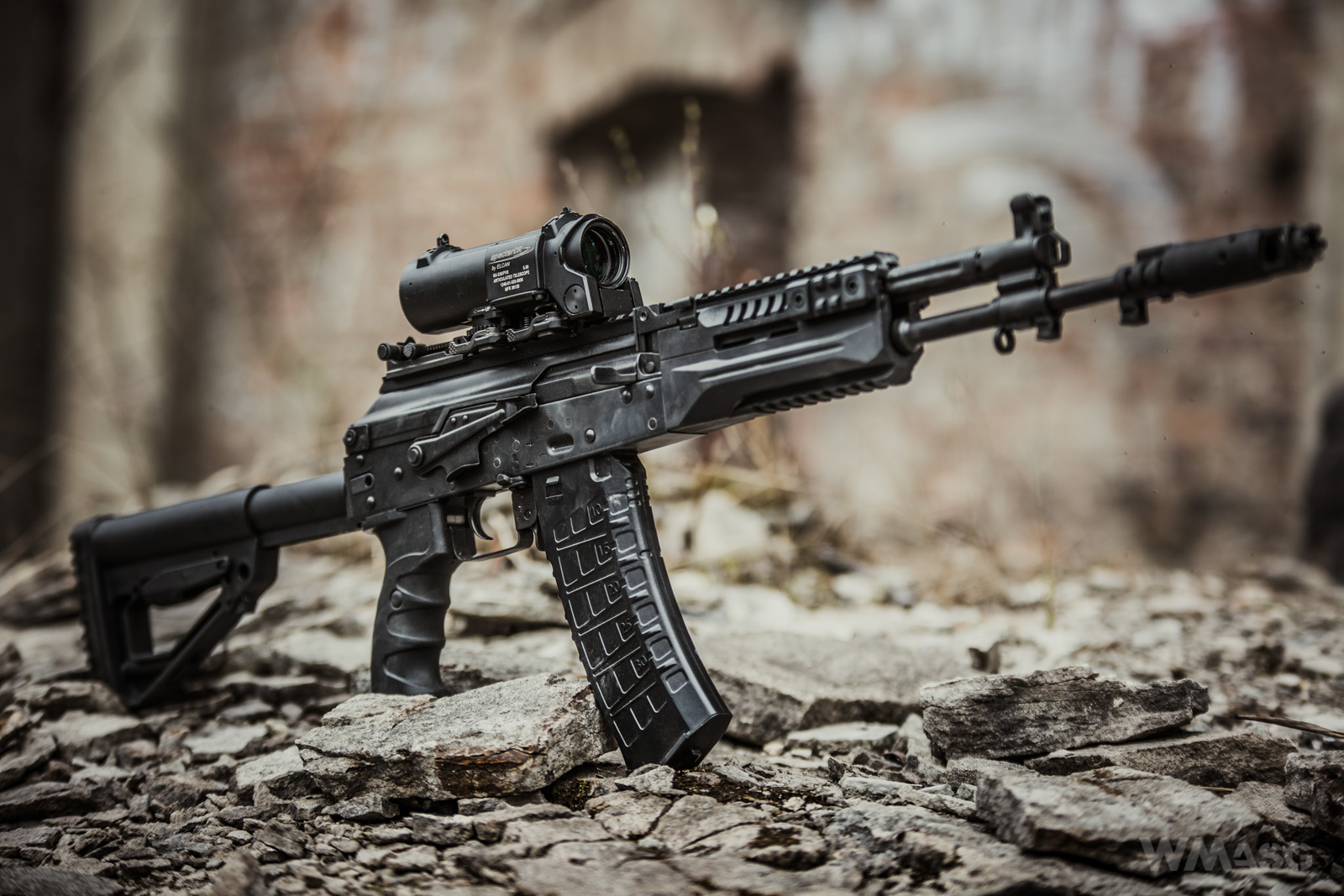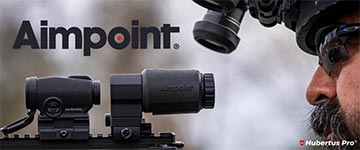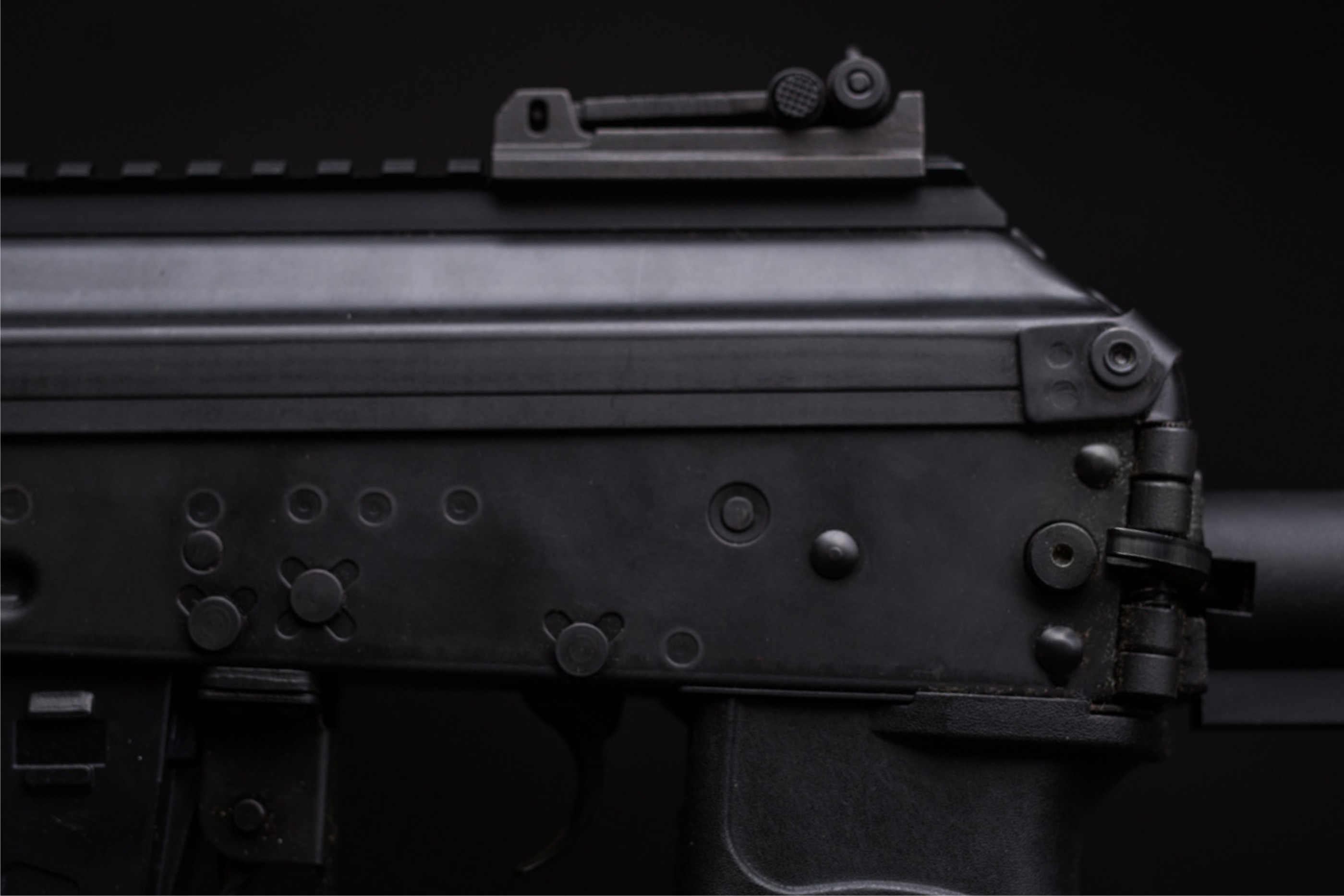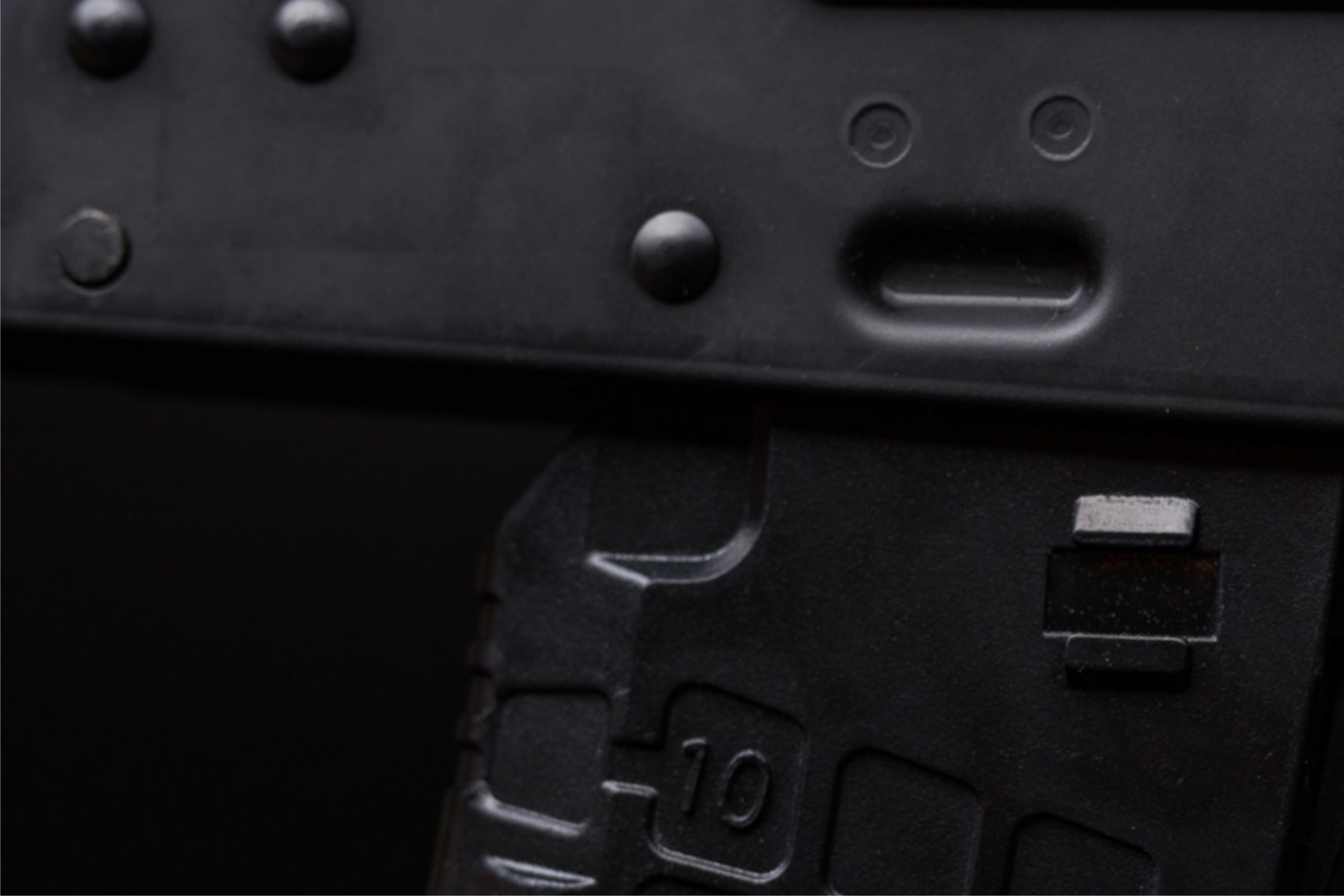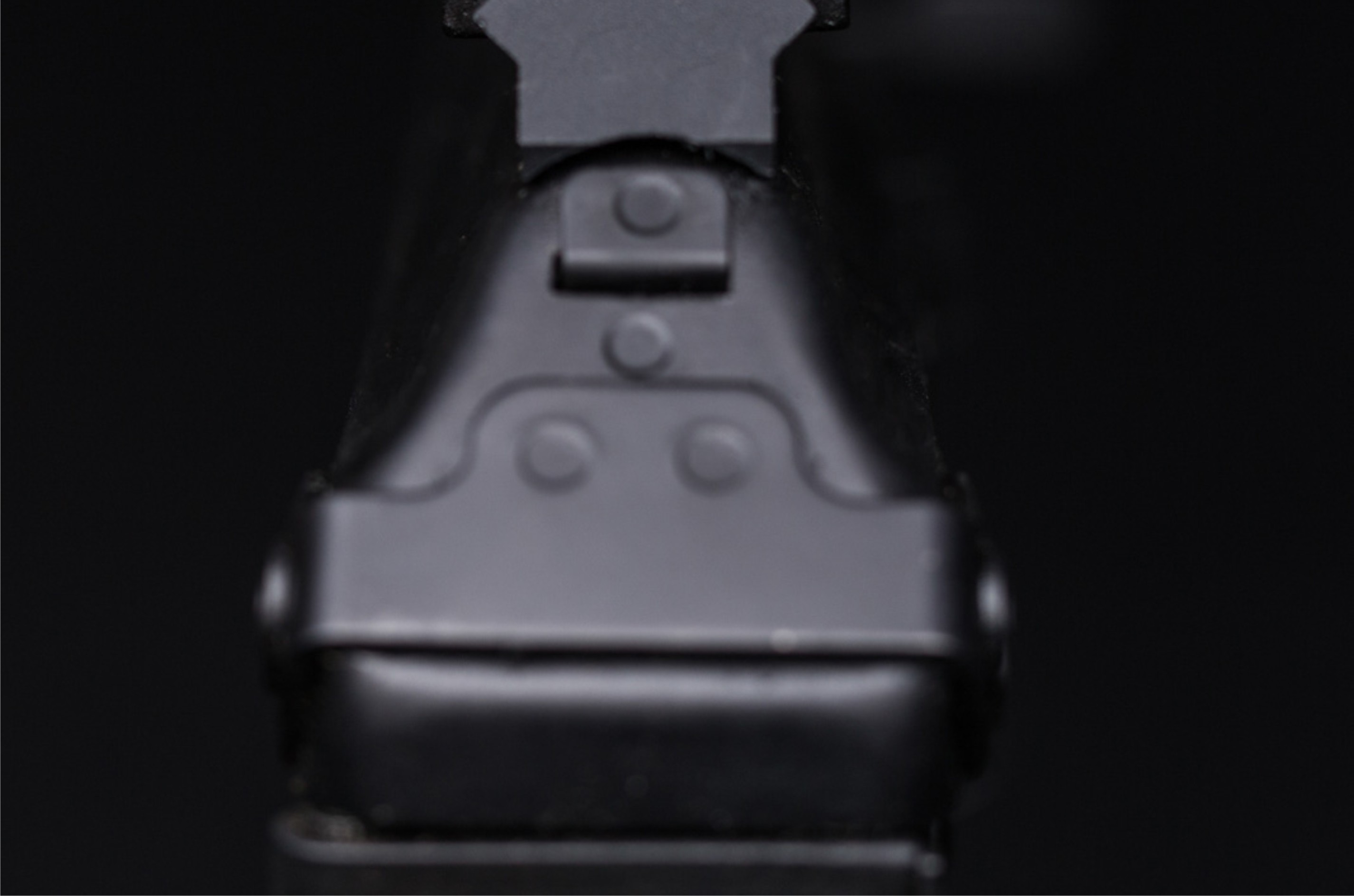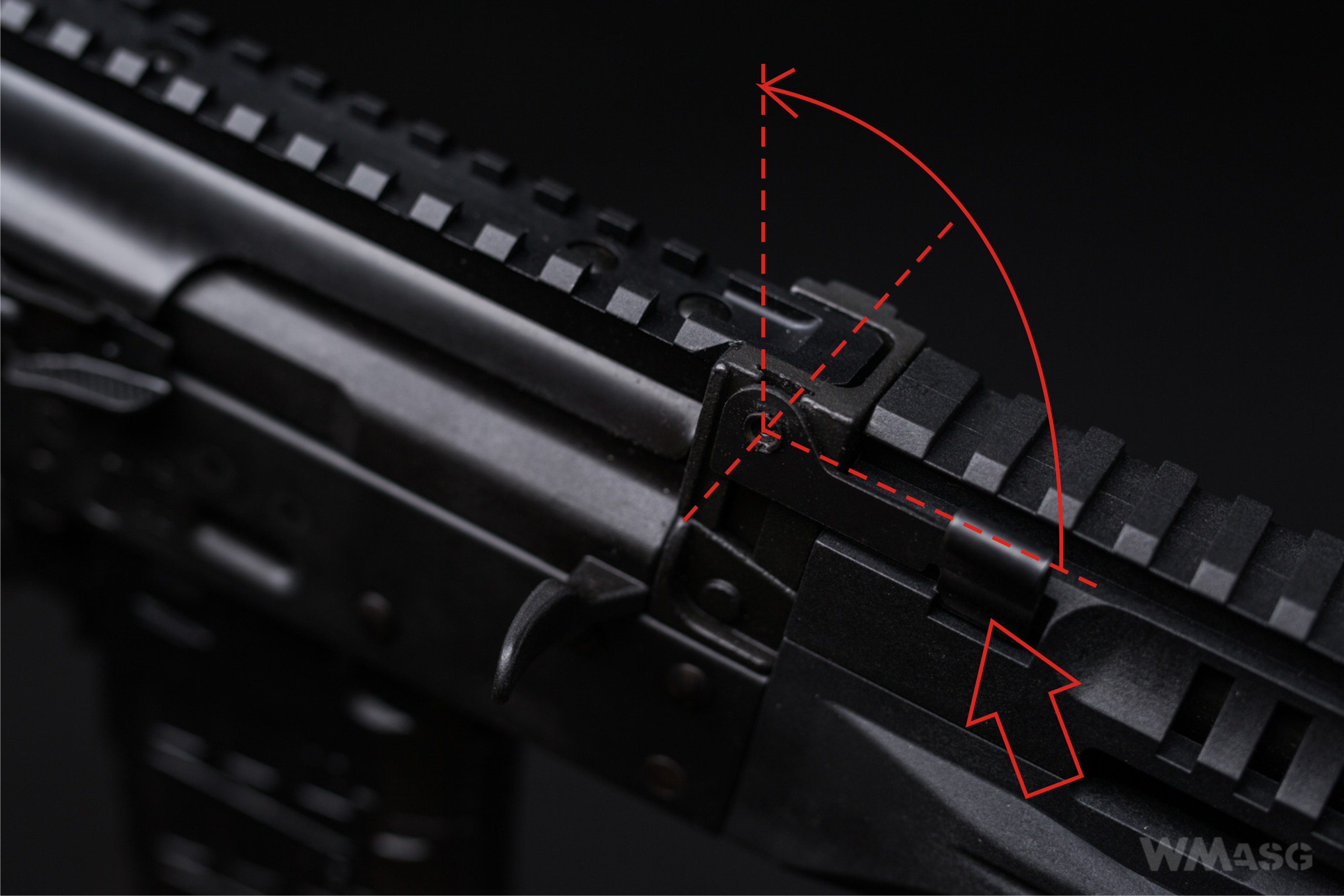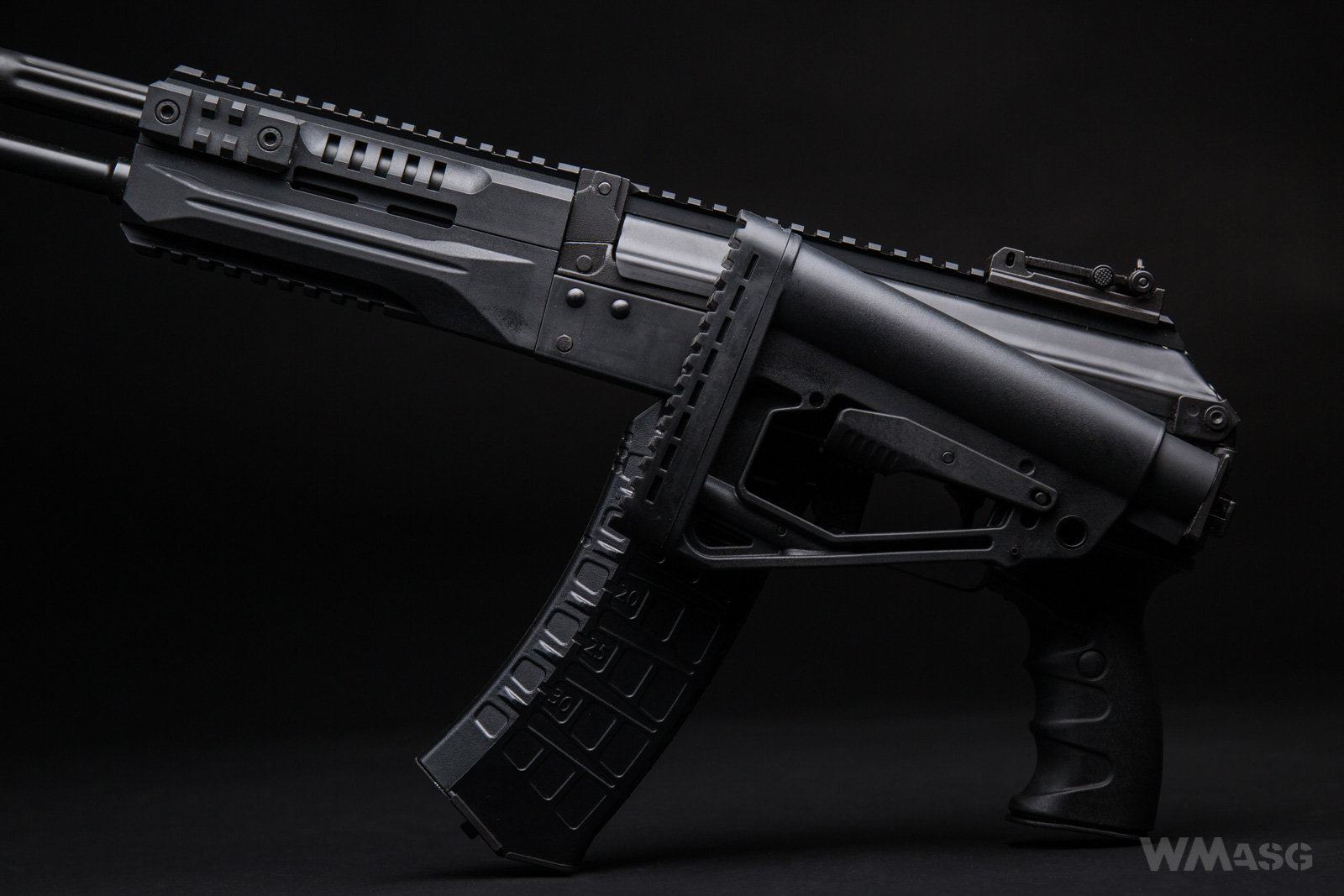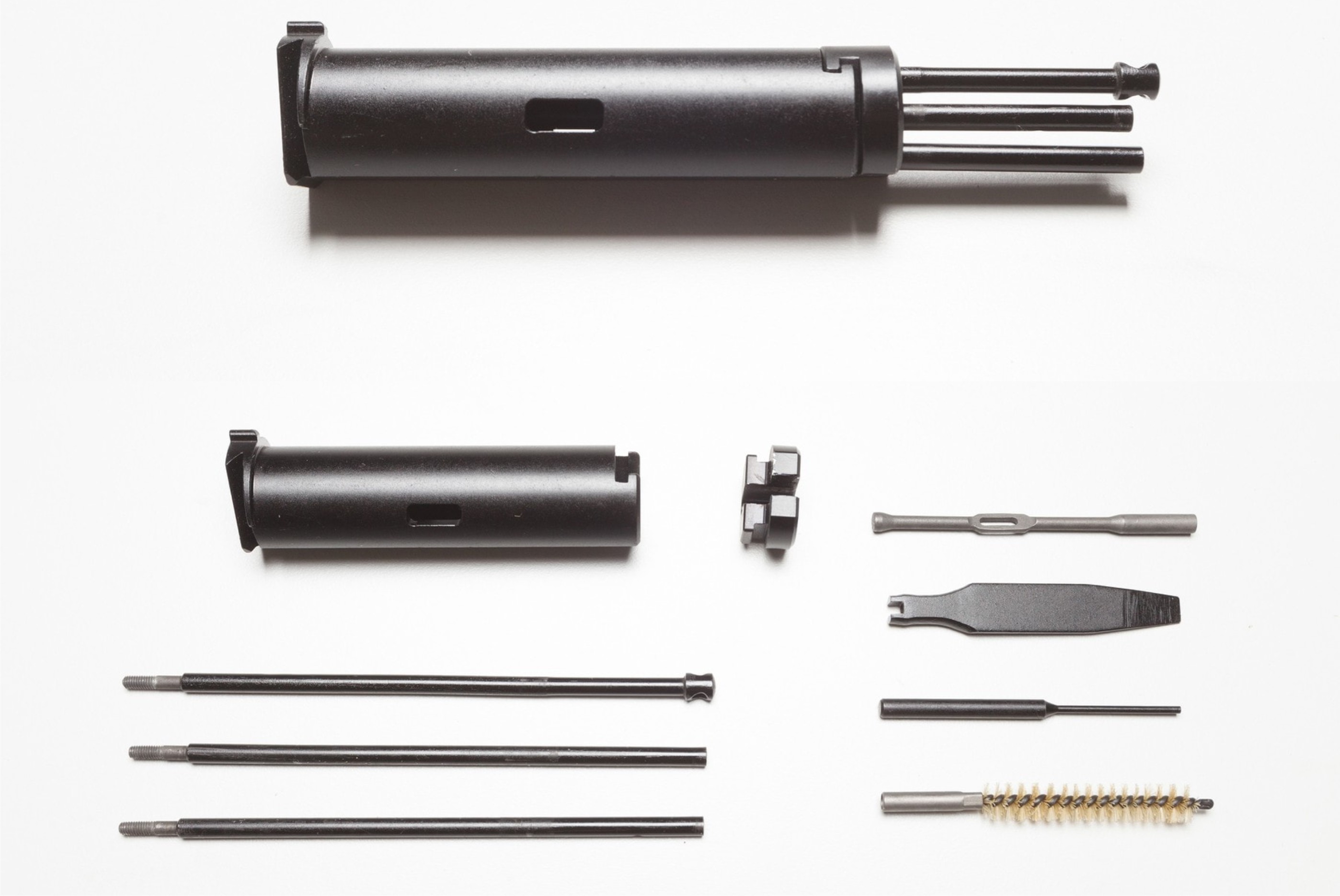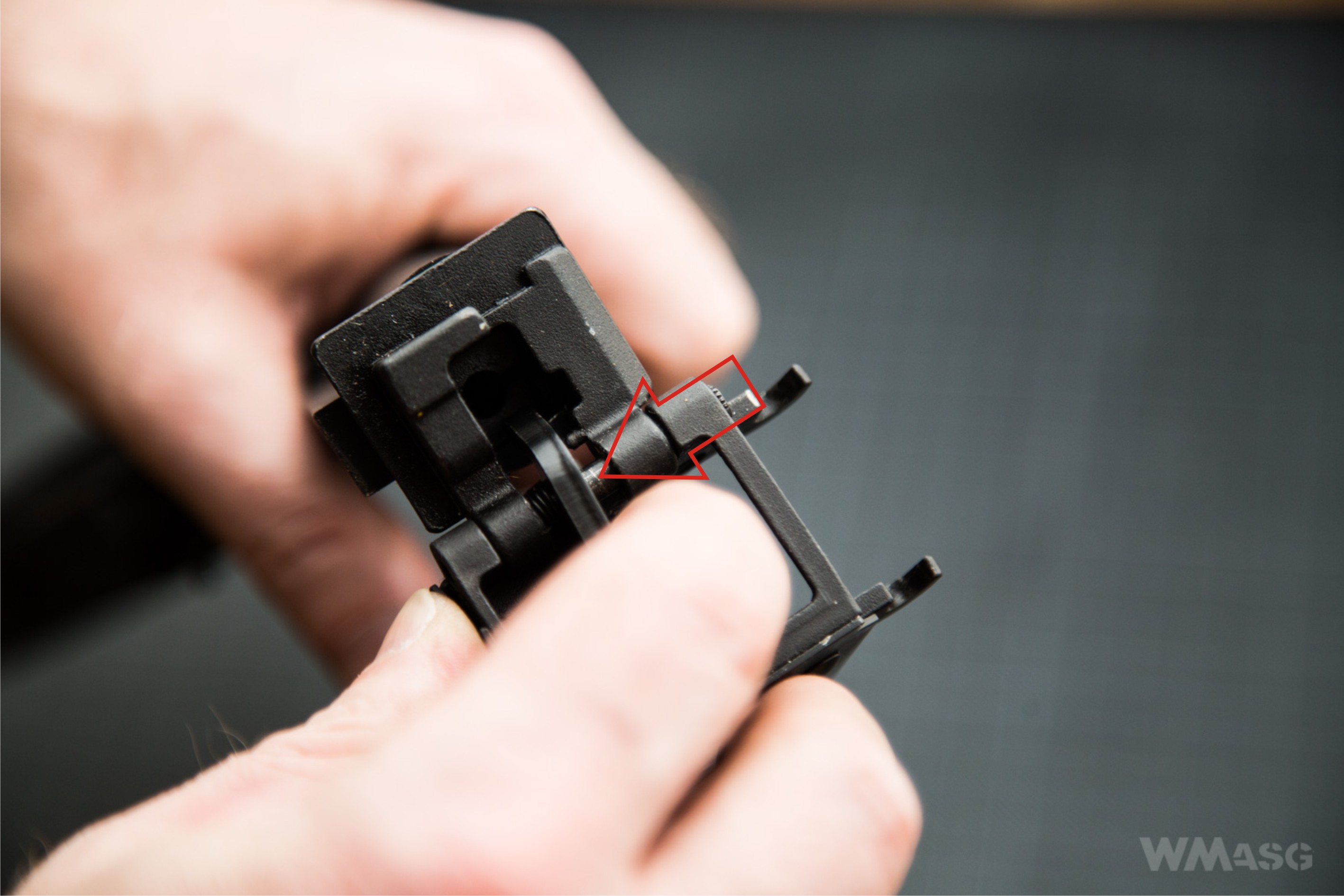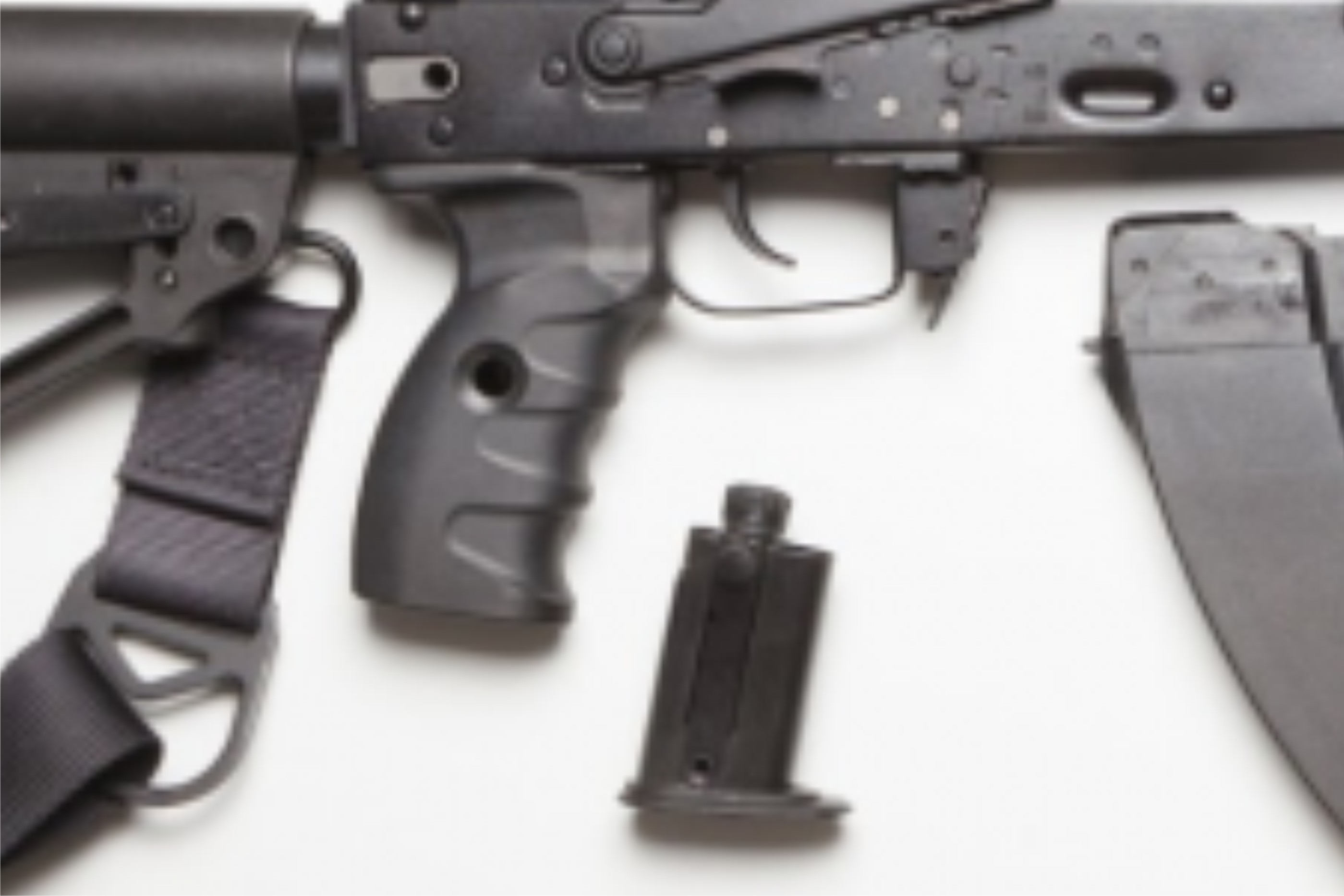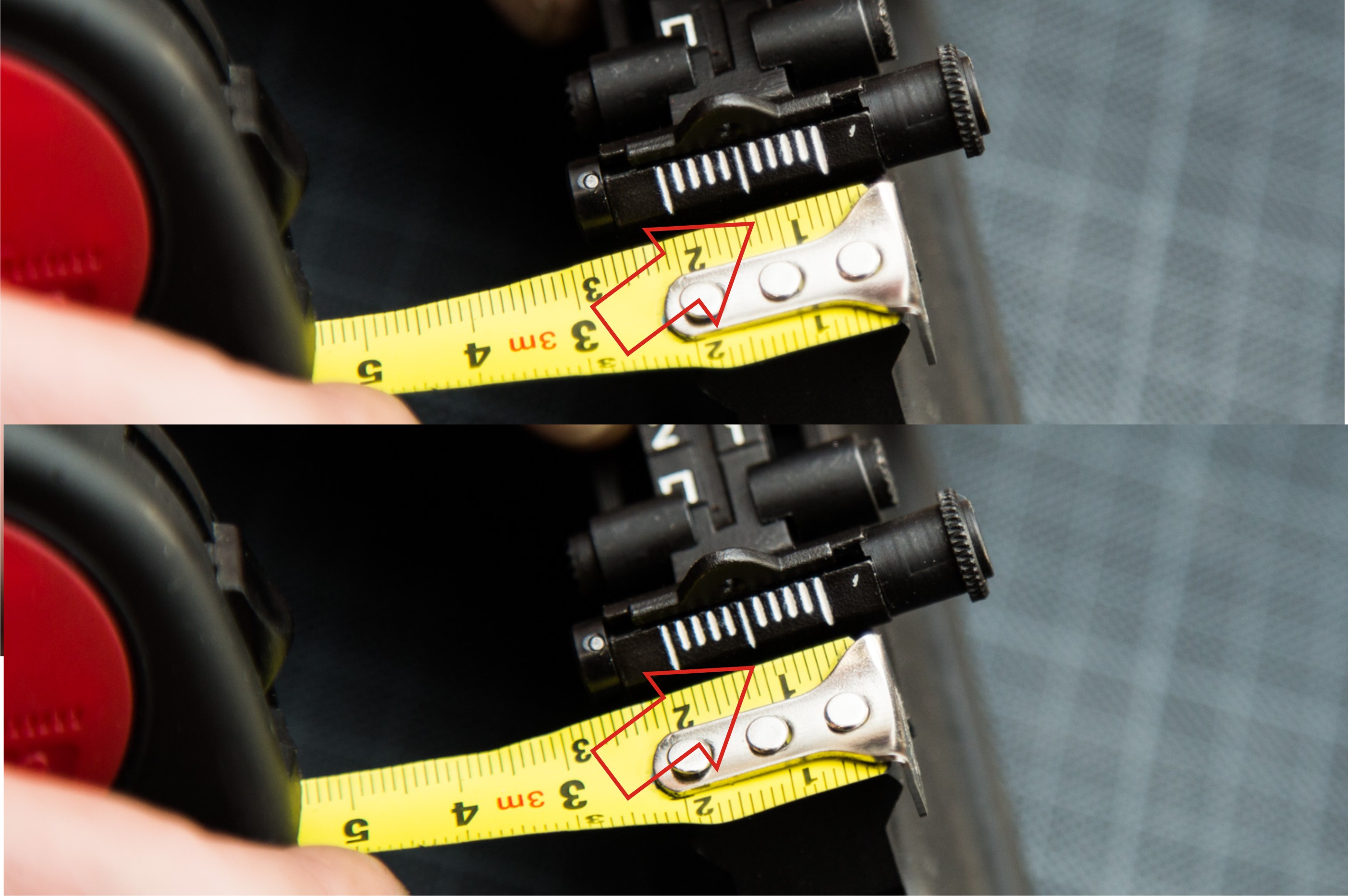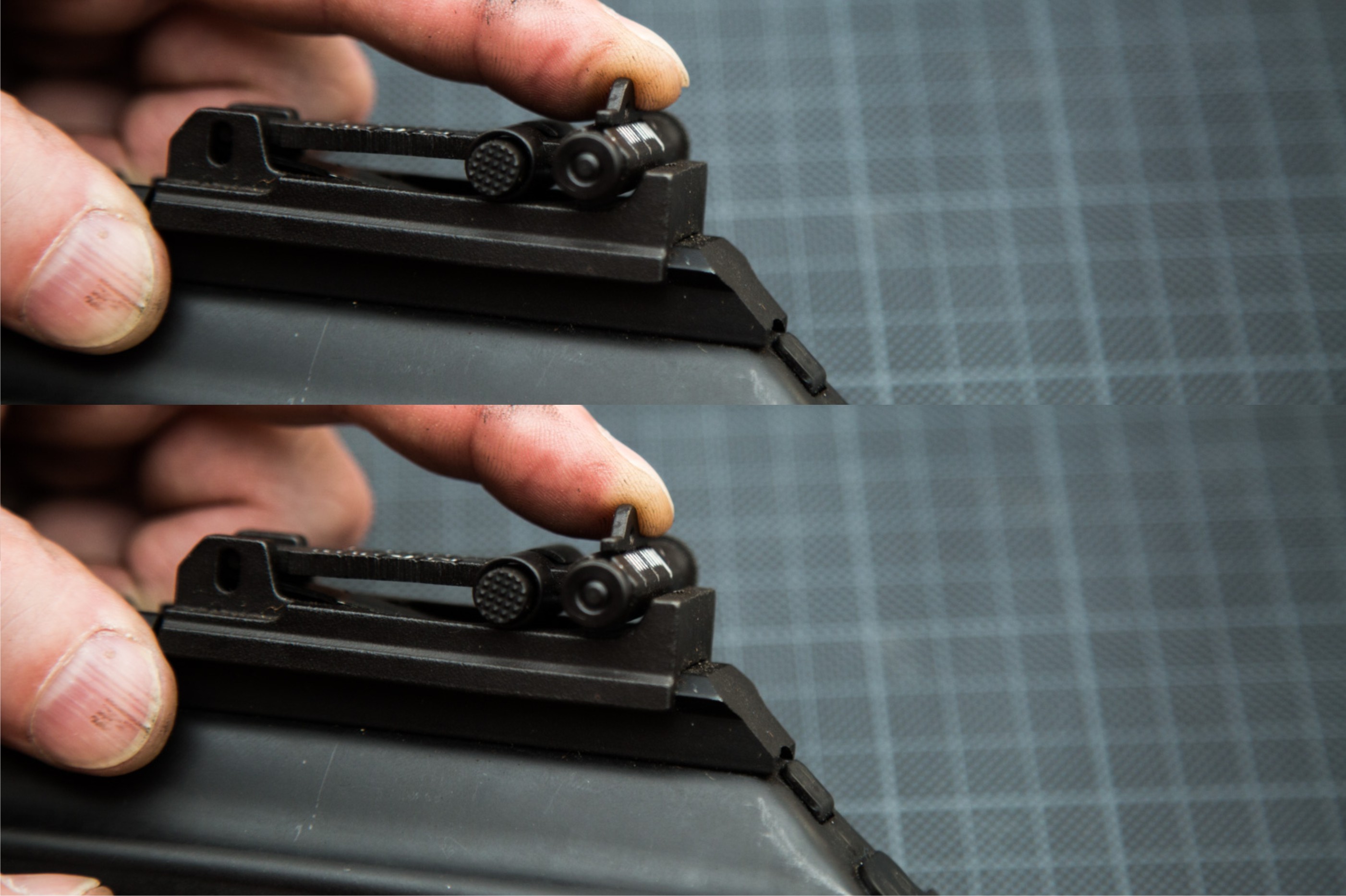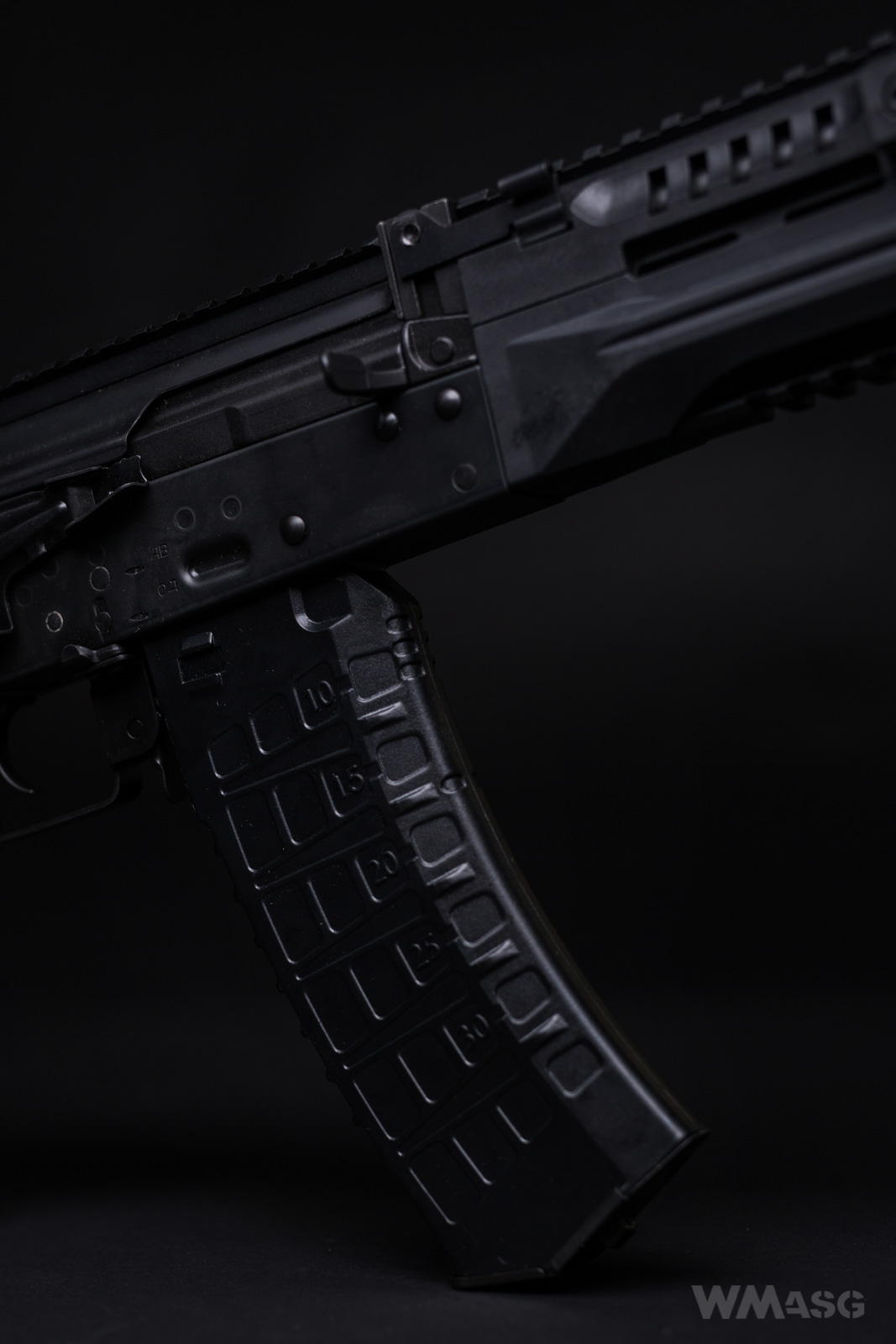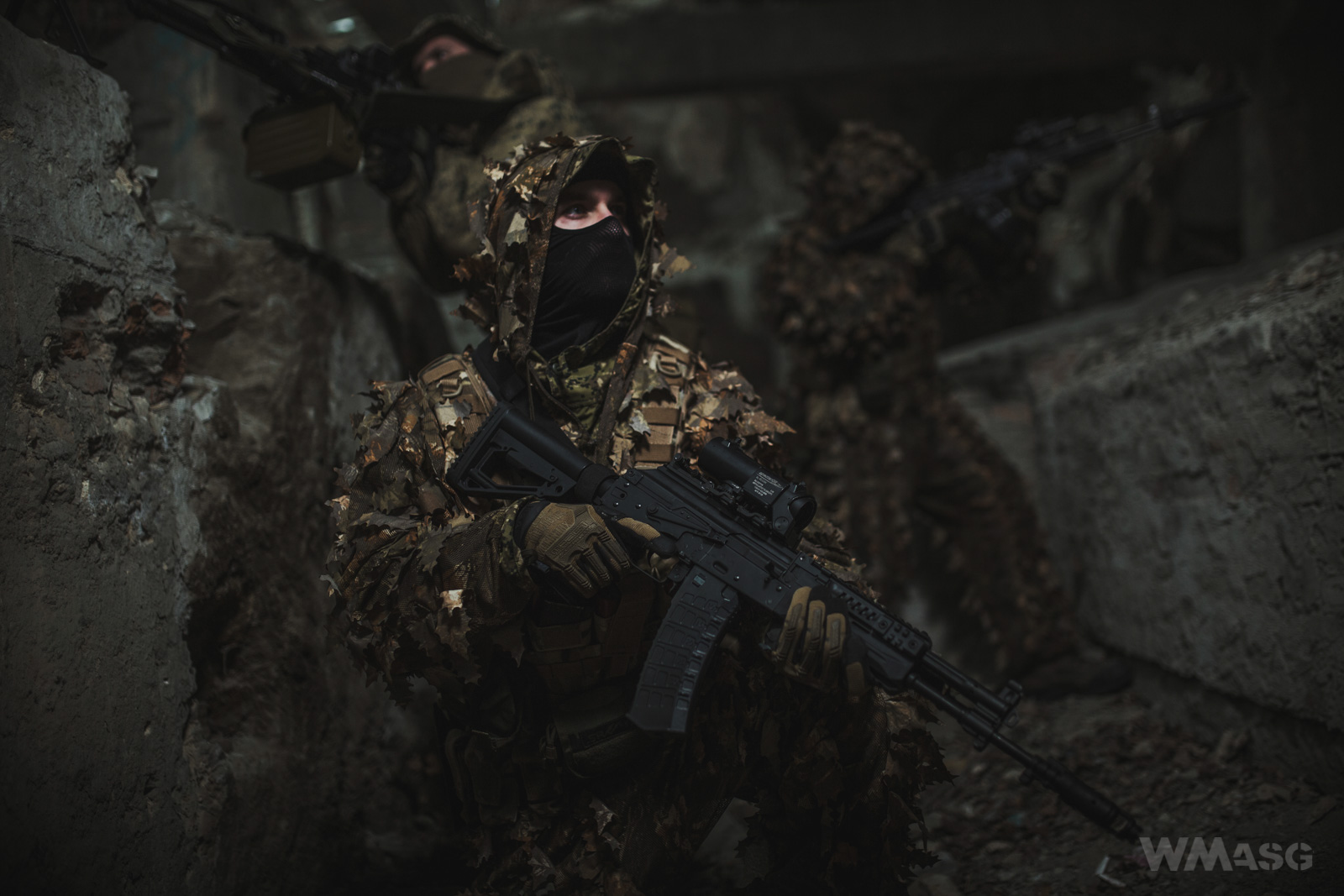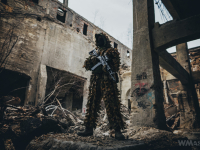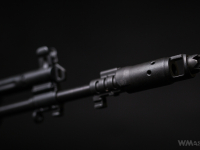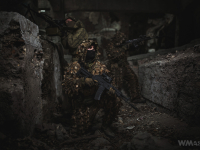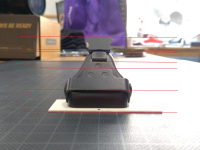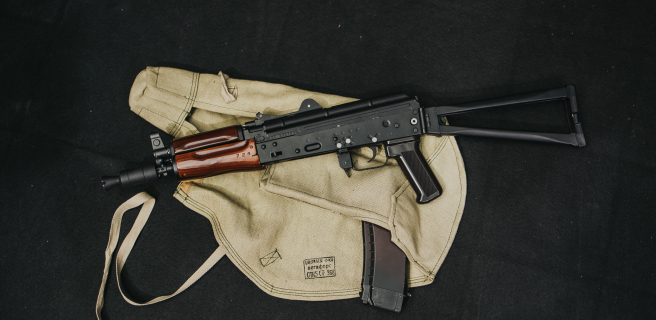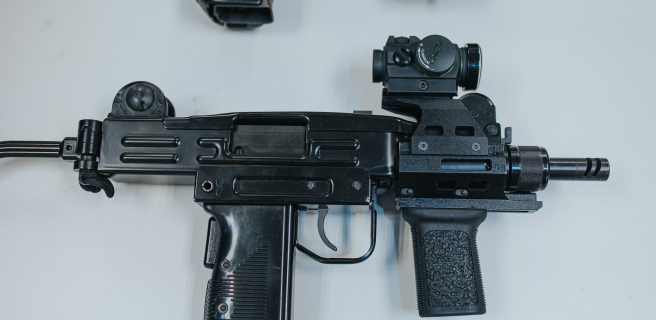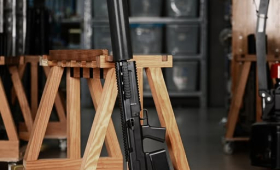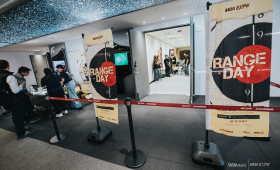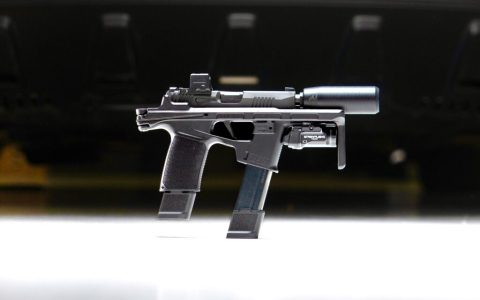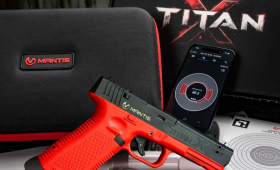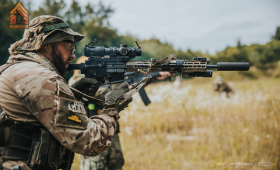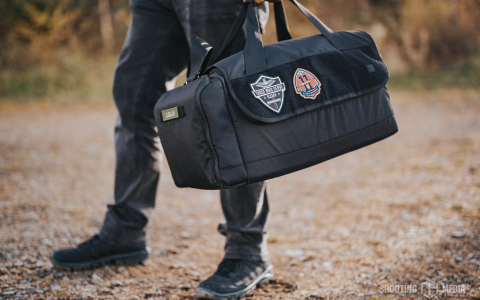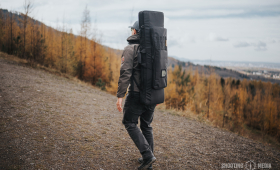I do not remember a such second situation on the airsoft market. Only a year ago, on 29 January 2018, the Russian Ministry of Defense officially approved the AK-12 for use. On 20 December 2018, the Kalashnikov Group delivered the first batch of 2,500 carbines to the warehouses of the ministry. And in March 2019, at the IWA fair held between 8-11 March, LCT has presented the LCK-12 replica. And we been examining it in our editorial office for the past several days.
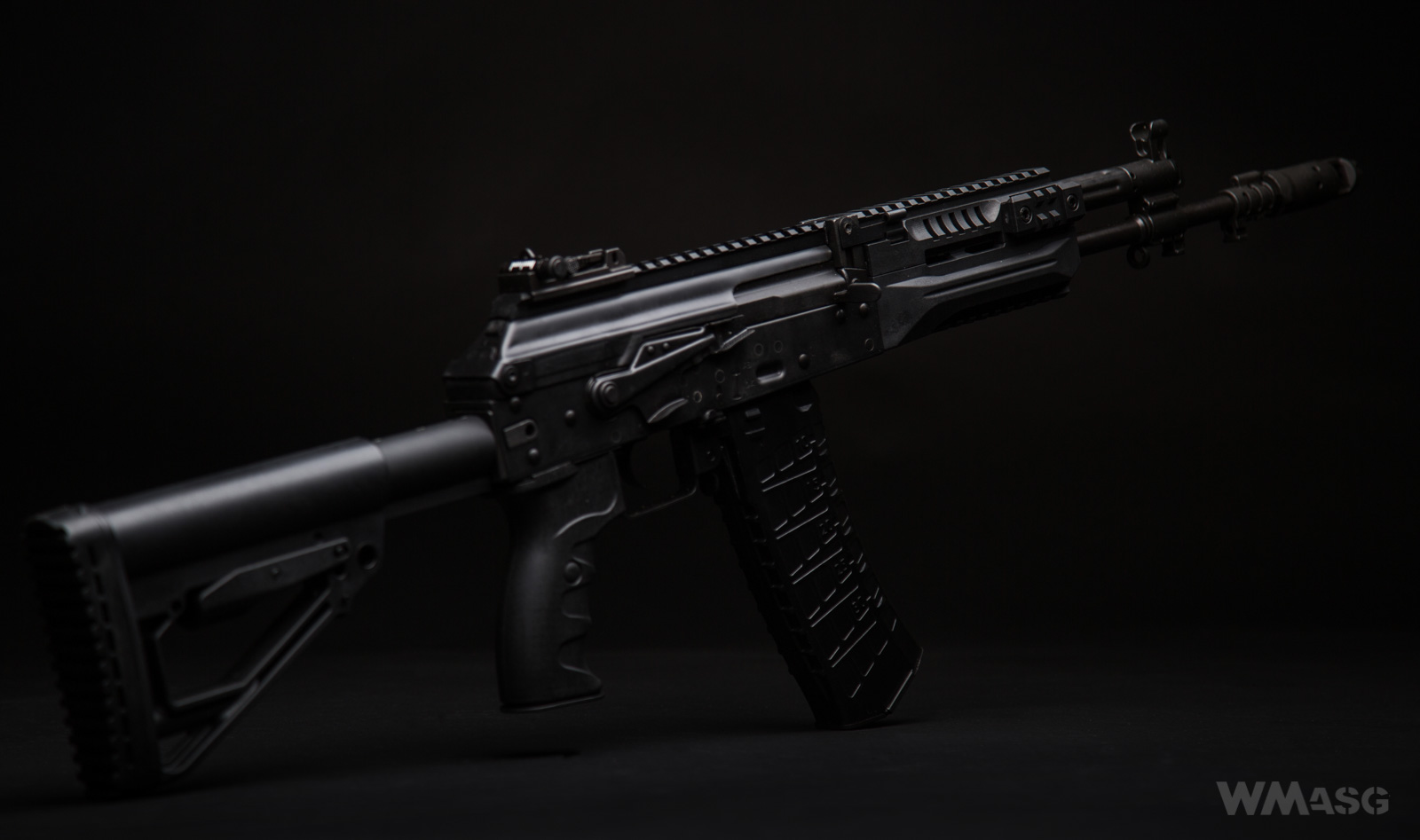
By the way, here is an interesting fact. The day after the first rifles were delivered to the Russian warehouses, photos and video emerged on the Internet, showing content that you can below:

The photos were taken on 18 January 2019 in Doha - the capital city of Qatar during a military parade organized on the occasion of a local holiday. This is interesting as that was before the AK-12 has been delivered to the Russian armed forces. Two of the military units seen in the photos were armed with AK-12-like carbines. Of course, you can not learn too much from those photos. In fact, nothing more than the fact that it is most likely the AK-12, but with the rear sight disassembled or moved somewhere which, on carbines presented by the Russians, is placed in the rear part of rail running on top of the receiver cover of the carbine. Apart from the fact how was it was possible that the Arabs miraculously got their hands on the AK-12 earlier than the Russians, I wonder if they took off the the rear sight completely, or whether they moved them to the place where earlier AK versions had it. Just why would they have to shorten the aiming line, since its extension is one of the advantages of the AK-12 is beyond me. Incidentally, this was the idea of the Finns, who modified their AKs (Valmet M62 from 1962), used later by Israelis in the Galil (accepted for service in 1972).
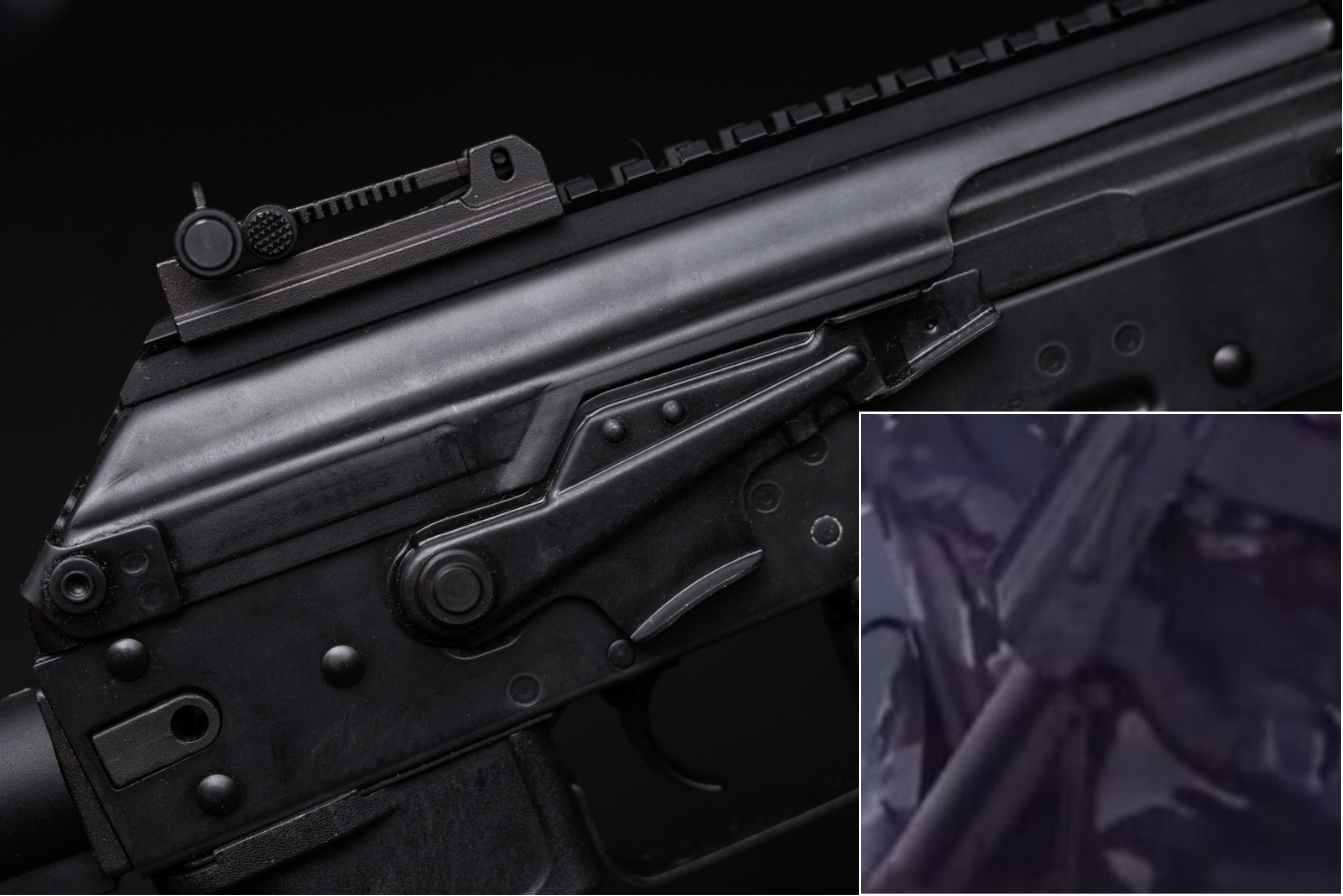
Enough of that. Lets get back to the replica.
Basic parameters:
- total length (folded/unfolded buttstock): 685/945 mm;
- length of the inner barrel: 435 mm;
- mass (without the battery and with an empty magazine): 3800 g;
- power supply: stick battery placed under the receiver cover;
- magazine capacity: mid-cap holding 130 BBs;
- muzzle velocity (using 0.2 g BBs): about 390 fps.
Parameters of the real carbine:
- overall length: 690 -940 mm;
- barrel length: 415 mm;
- mass with an empty magazine: 3500 g;
- magazine capacity: 30 rounds.
The set is very modest. In addition to the replica and the magazine, we only receive an individual copy a carbines card with a factory muzzle velocity measurement, a bilingual "pictorial" instructions manual and a folded LCT products' catalog. It is worth noting that on the shorter side of the box two replicas marked as LCK-12 and LCK-15 with a "checkbox" were shown next to each. Both the AK-12 and the AK-15 version will be available for purchase. In the original, they differ in the ammunition to which they are chambered for (the AK-12 used the 5.45x39 mm round, the AK-15 the 7.62x39 mm round). The photo below shows the real carbines, the AK-12 is at the top.

Source: www.kalashnikov.media
In our airsoft reality it is exactly the same carbine (100% identical replica) differing only with the type of magazine supplied with the set. In other words, whether the LCT employee will check the AK-12 or the AK-15 in the checkbox, is decided by the type of magazine that he.she puts in the box. Thus, at least in theory, depending on your needs, you can use it as the AK-12 (you must have a set of 5.45x39 mm type magazines) or the AK-15 (with appropriate magazines). The additional good news is that the replica accepts magazines made by other manufacturers.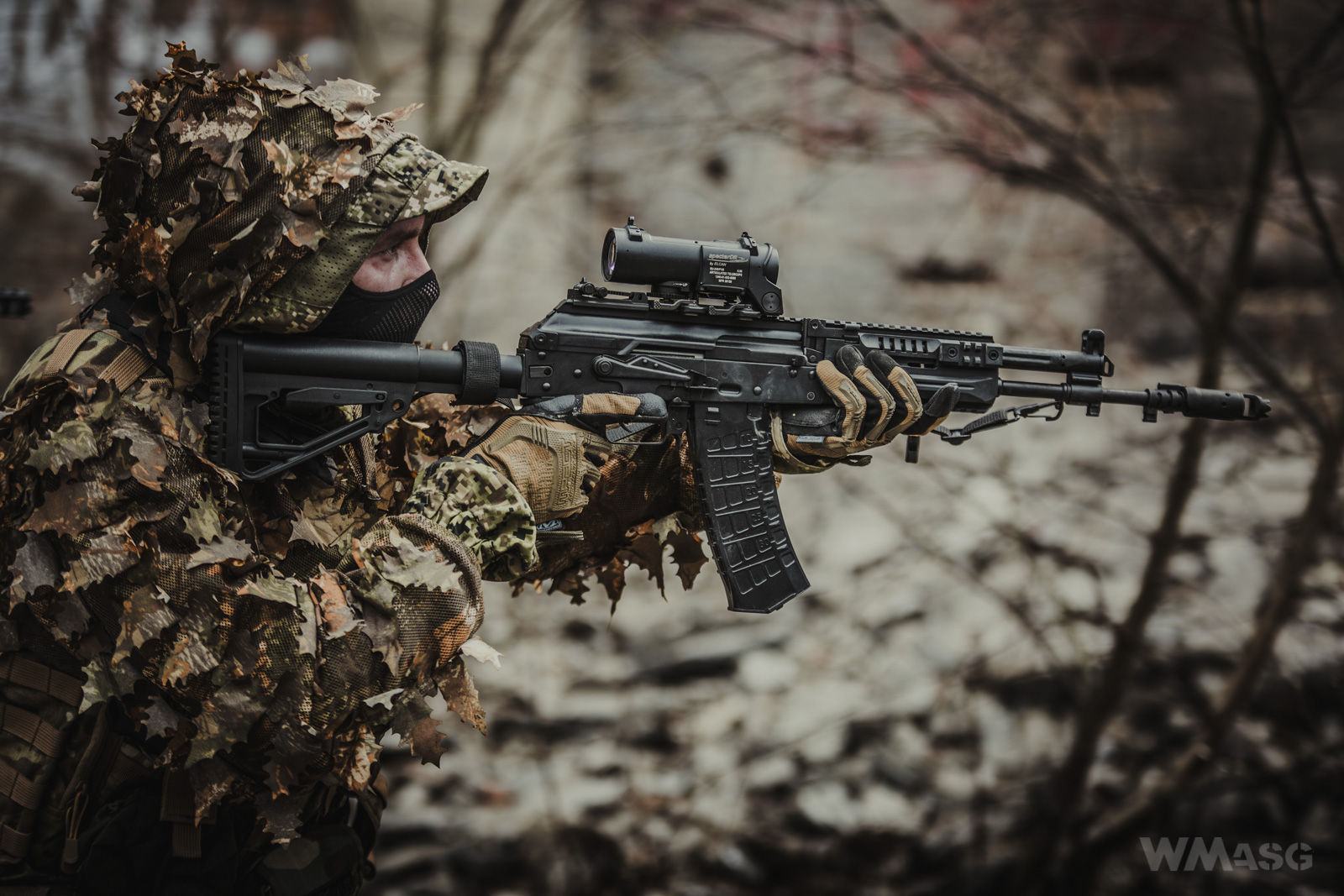
First impression
For someone who does not like AKs as a principle, the replica will not make a great impression. It ill be just another AK (as if other ARs were not just another AR). I respect the AKs. And I like them. For me, this AK-12 is amazing. Steel, oxidation, steel, oxidation, hard polymer. After taking into my hands, the impression does not go away. The weight does its job (the replicas slightly heavier on the barrel side). Then it comes to ergonomics, the AK-12 is still lacking, although the possibility of adjusting the length of the buttstock certainly a good thing. But, once again. this is a Kalashnikov carbine.
Of course, I could not compare the replica with the real carbine. Nevertheless, by looking and taking the replica in my hands I have the impression that it is very "believable".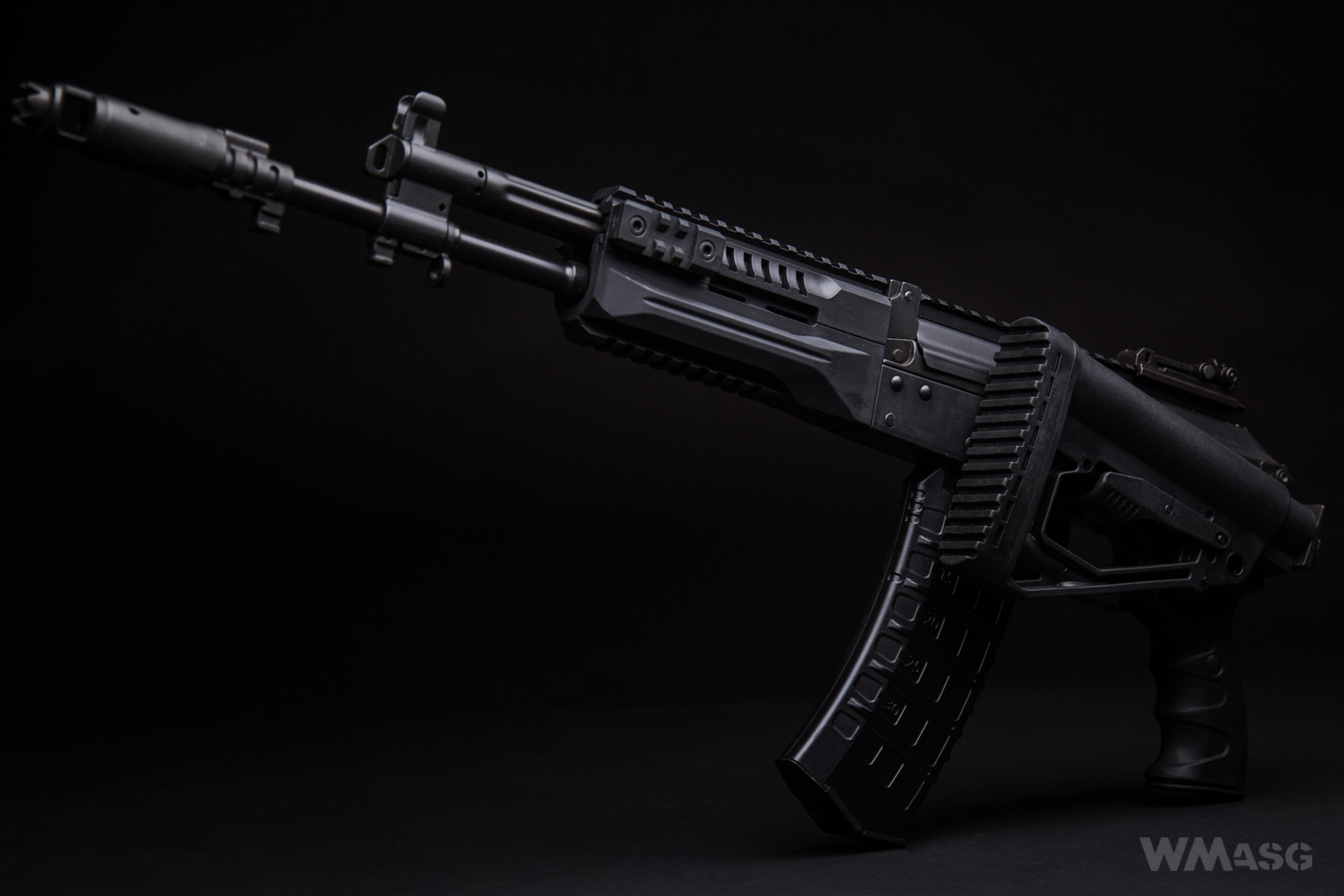
Shooting it also does bring any surprises. It is still a replica of an AK. There are no inventions or controversial solutions in therms of airsoft technology. It is used in the same manner that I've been used to for many years. And it can not be otherwise, because the Russians themselves, after many years of attempts, have come full circle and the final AK-12 is basically a modernized AK-74M. Is that good? I do not feel competent to comment on the choices and decisions of Russian weapons specialists. I think they know what they are doing.
As an old "razvan", I noticed one more thing. While vigorously shaking the replica made two independent sounds (ringing).The first was obvious as it was the front attachment of the carrying sling. It easy to get rid off. The second one surprised me a bit, but about that in a moment.
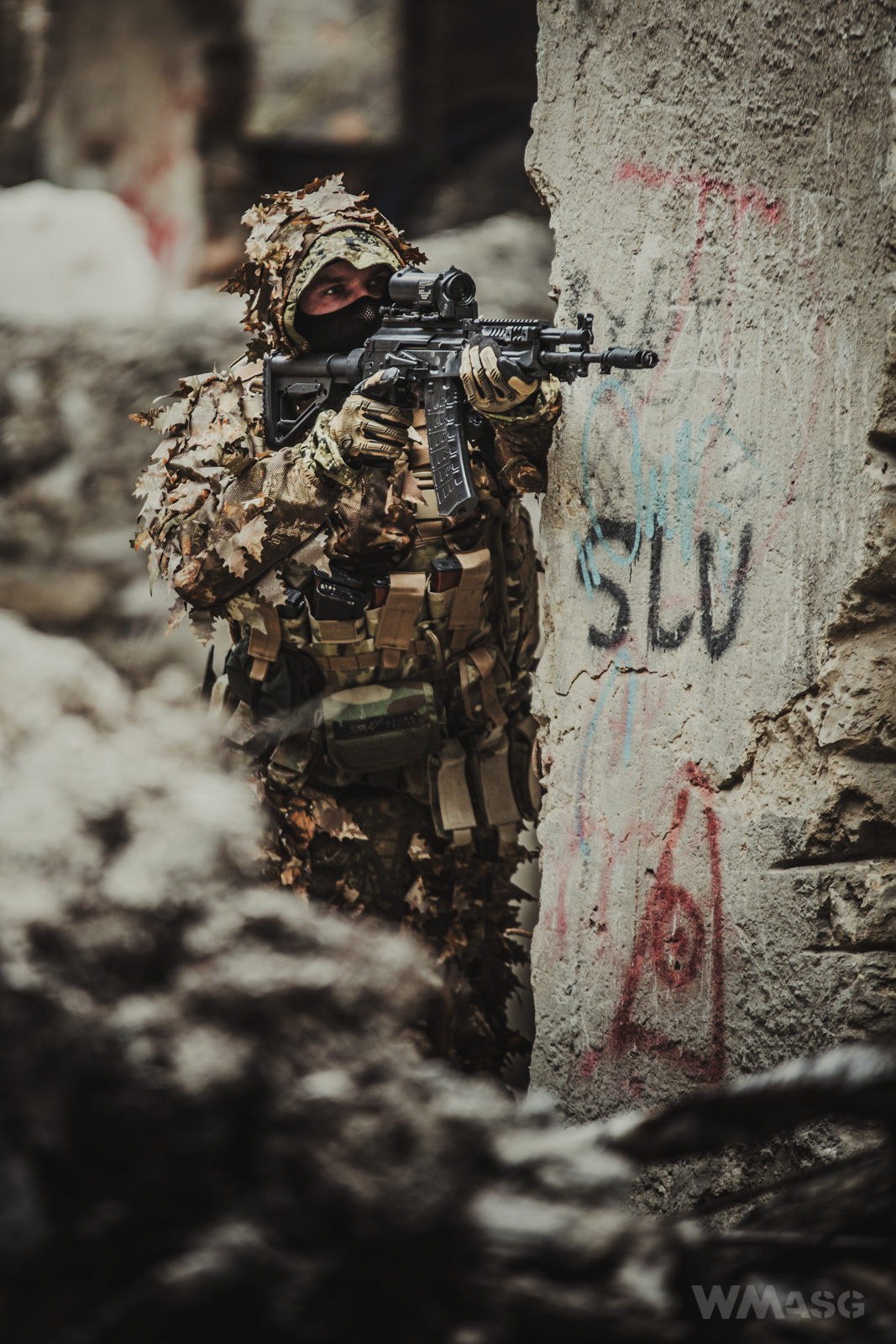
External design
The flash hider
Starting from the front. The flash hider is somewhat reminiscent of the one used in the AK-74, but only slightly. The mounting method is fundamentally different. There is no thread here. After pressing the locking pin, you turn the hider by a quarter of a turn (to unlock it) and slide towards off barrel. As there is no thread you cannot used airsoft silencers. Until, of course, LCT launches a dedicated silencer for the replica. By the way, the fit is very tight, you have to really put a lot of effort to take it off.
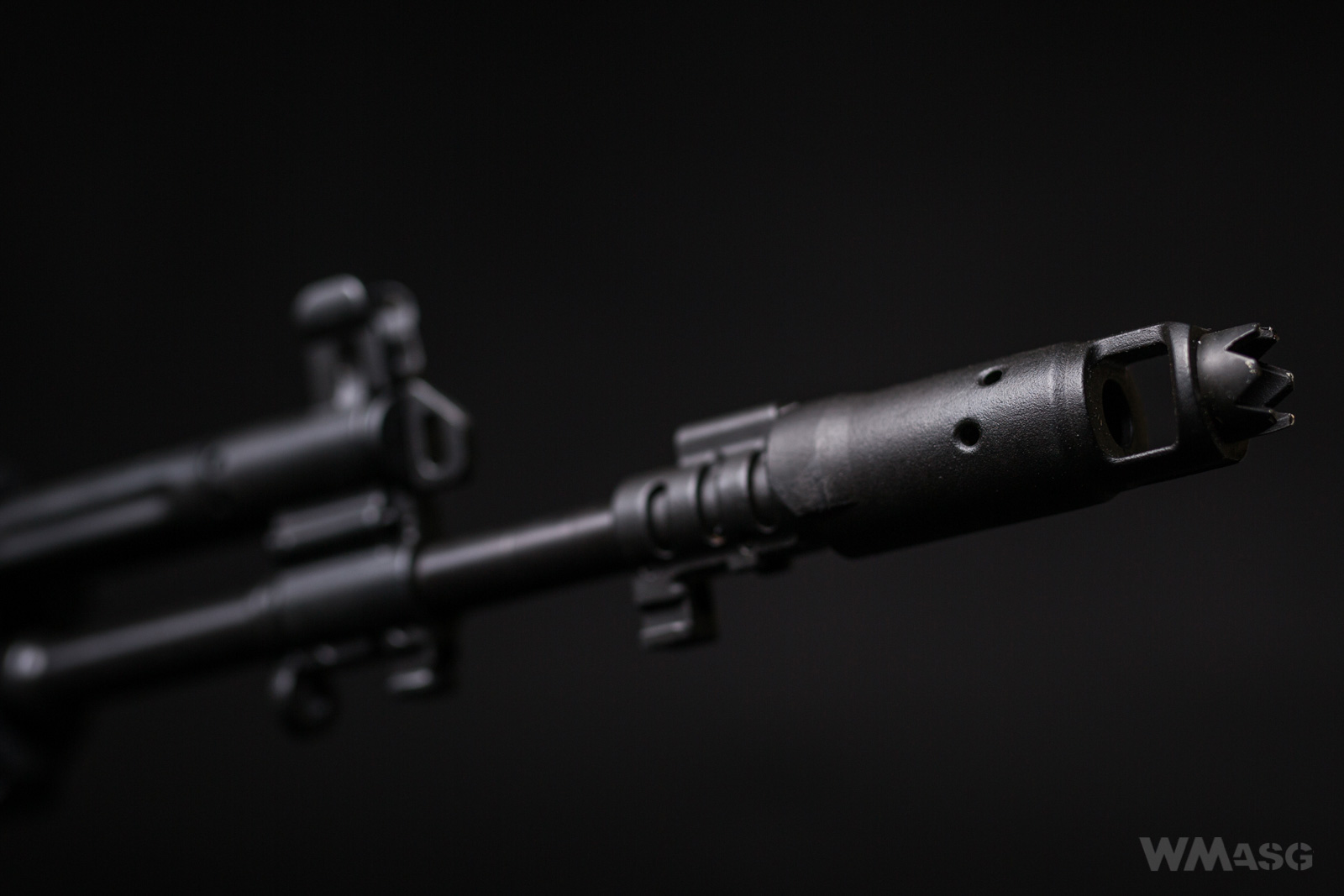
The arrows indicate the parts that must be interlocked.
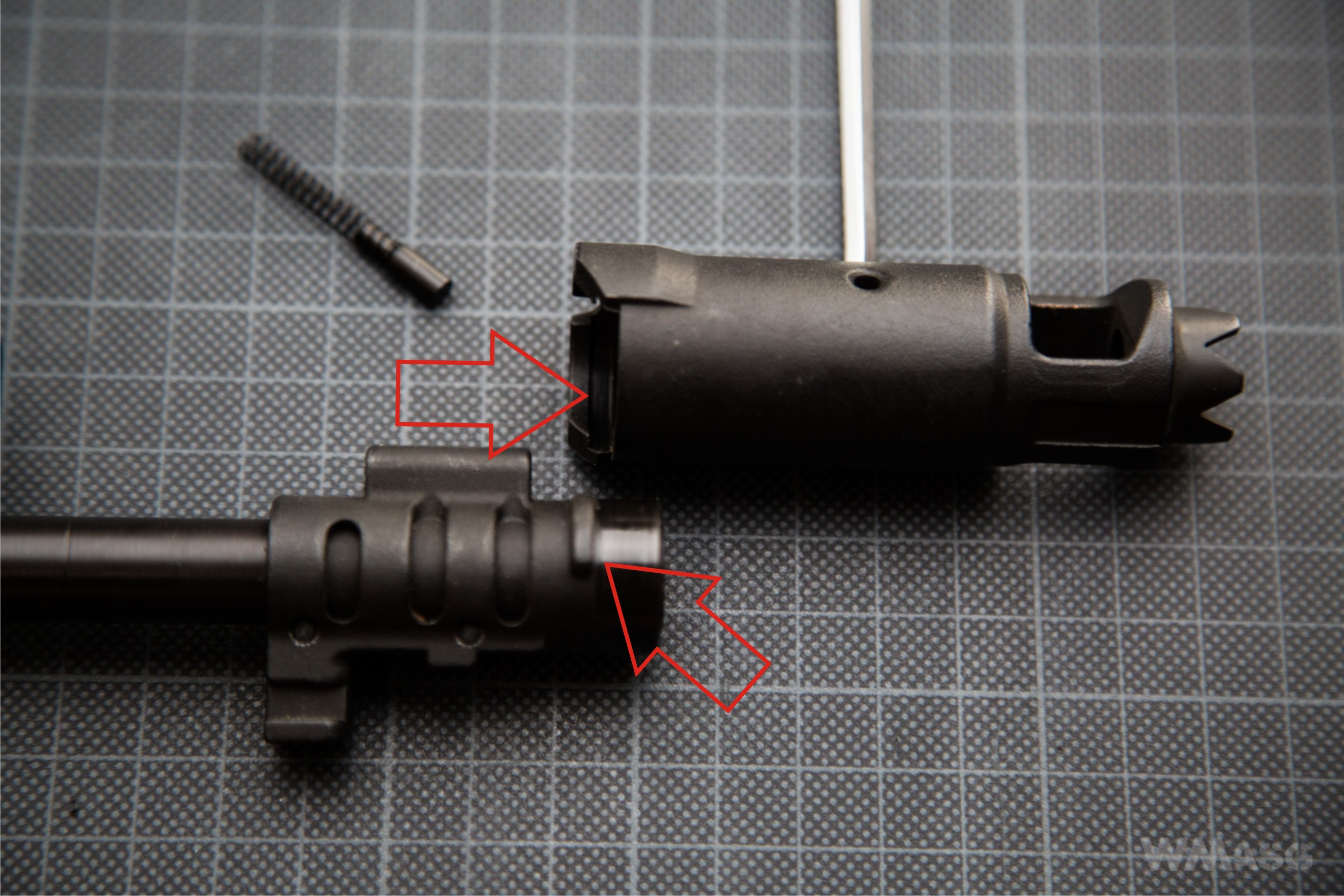
Here is the locking protrusion from a different perspective (the inner barrel has been take out):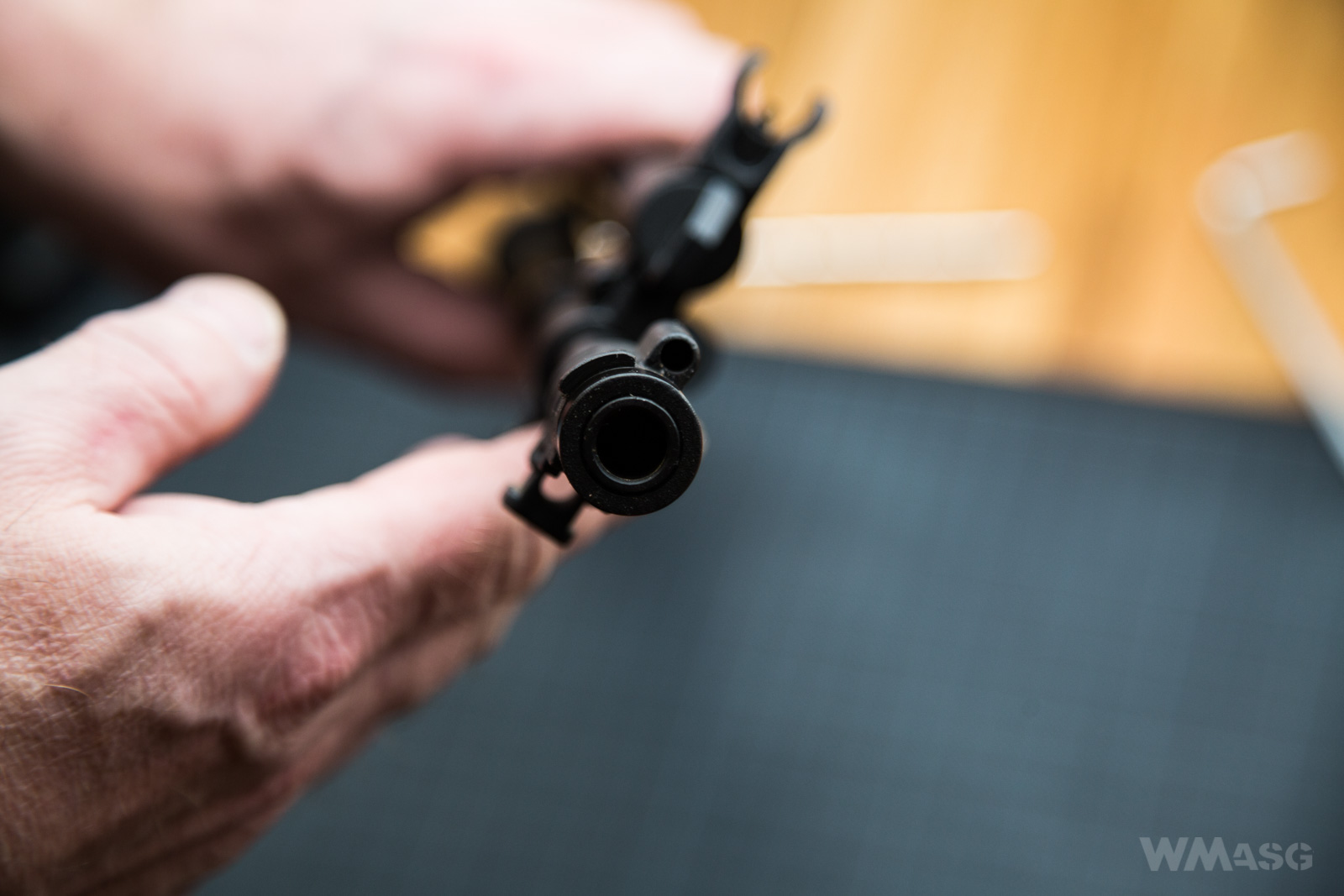
The gas block
Like all the parts at the end of the barrel, everything here is made of steel. The yellow arrow indicates the carrying sling attachment point that rotates around the barrel. The red arrow, contrary the appearances, is not a gas block regulator, but an bottom of a gas pipe plug that can be opened. I will explain. The AK-12, unlike the earlier versions, has a permanently attached gas tube and it cannot be disassembled in field conditions. It was therefore necessary to equip it with a hole for cleaning and maintenance. The part indicated by the red arrow is closing this hole.
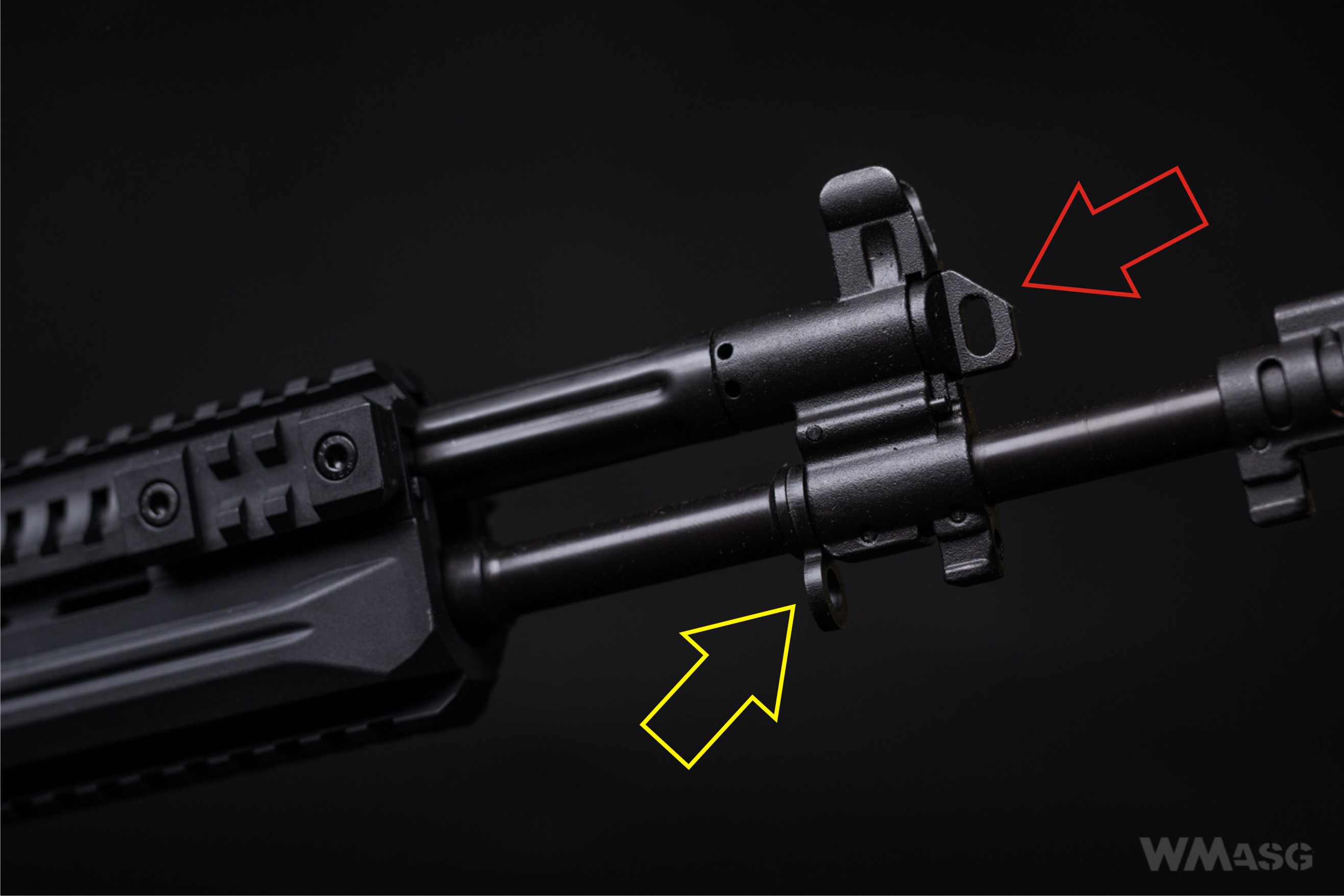
The red arrow below indicates a typical pin with a spring that is locking the plug in place. To disassemble it you have to press the pin, turn it by a quarter of a turn and than remove it.
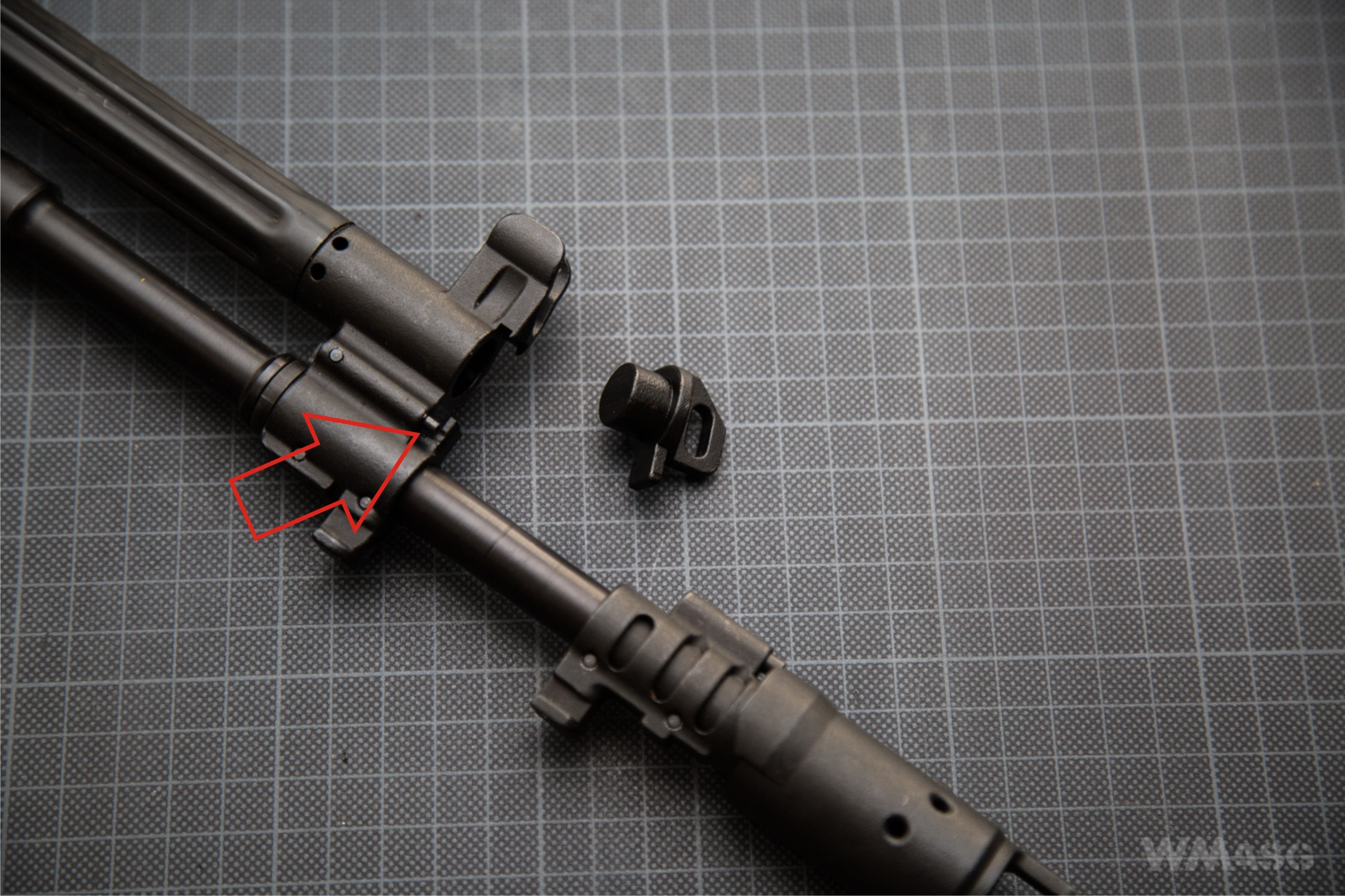
The lower and the upper handguard
Both parts are made of very hard plastic reinforced with microfibers. It looks so good that I would not be surprised by the military origin of this material. Bottom of the lower handguard is formed into one long Picatinny rail. Similarly with the upper handguard where the upper part of it is just a rail. The short side rails are detachable, but they can not be mounted elsewhere.
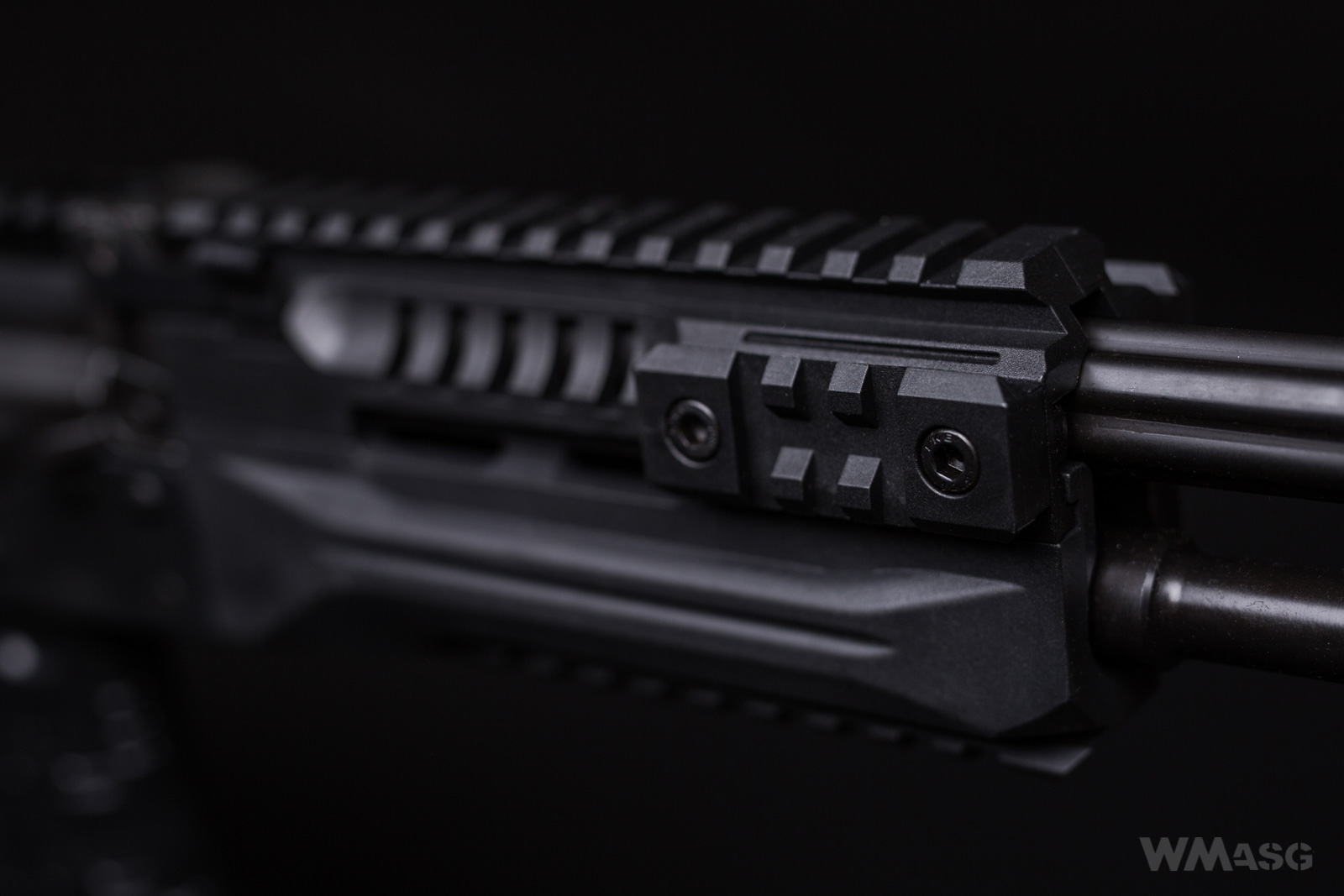

The mounting method of the lower and upper handguard on the carbine is completely different from those used so far. First of all, the AK-12 does not have a locking bolt for the lower and upper handguard. Secondly, the those parts, which are joined together, form a single part, which is attached to the carbine as a monolith. Thirdly, the whole is mounted with an additional pin that is a new addition to the AK-12.
It is done in the following manner. First the lower and upper handguard: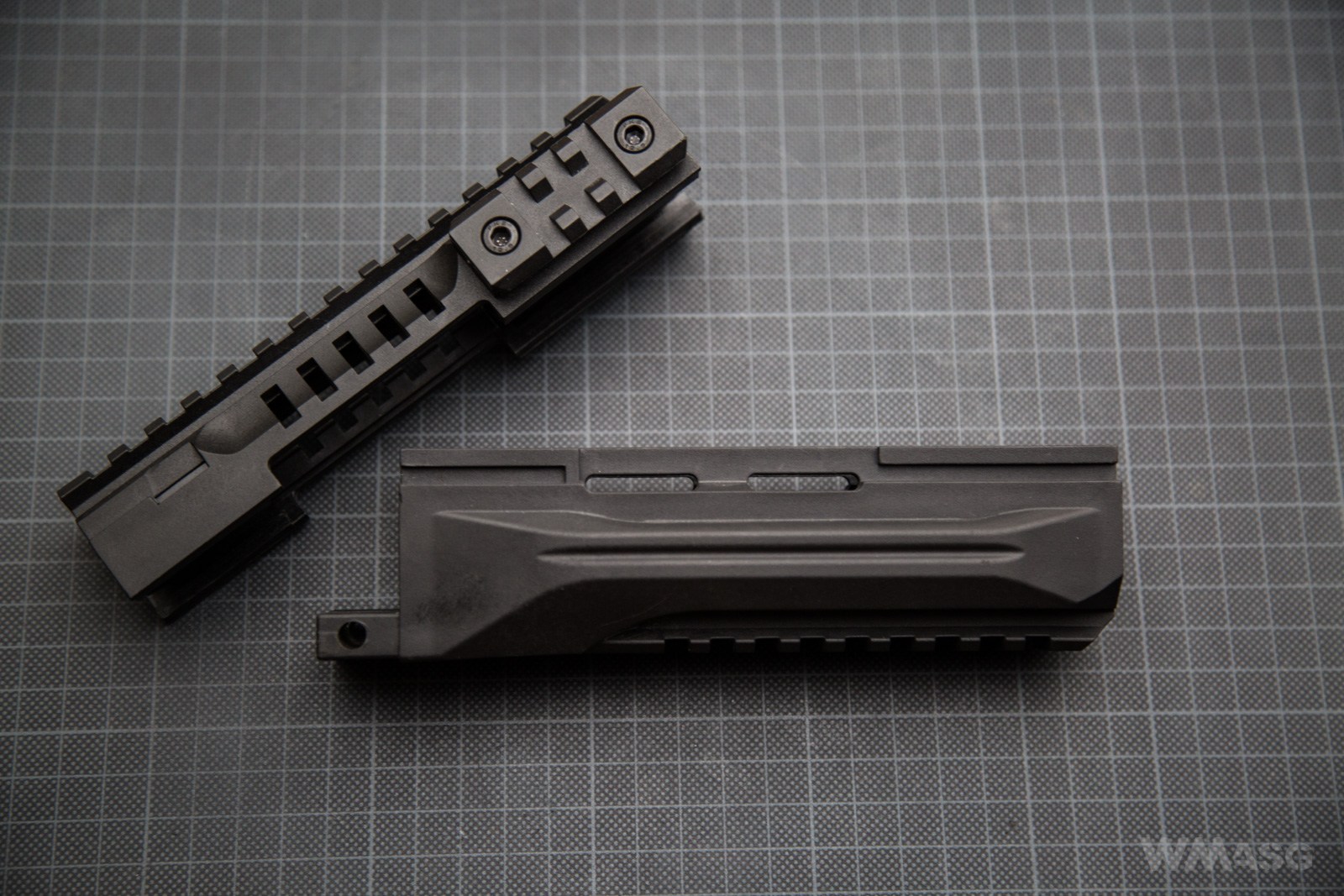
The method of connecting both parts is as follows. We put the upper handguard on top of the middle section of the lower handguard and it forward. Of course, it should be done on the barrel of the carbine as the assembled parts will not pass through the flash hider and the gas block with the front sight base atached.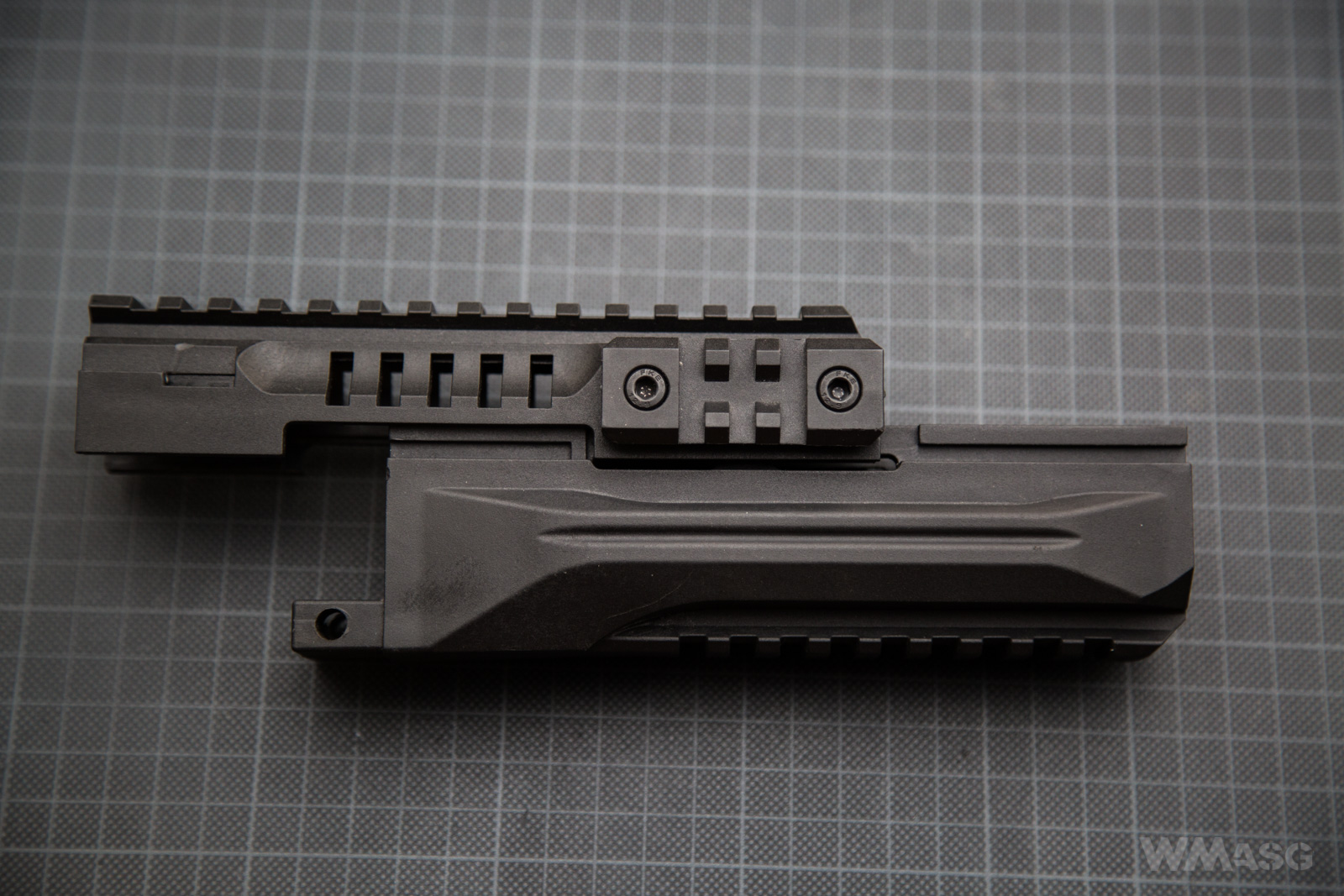
The assembled part. At the bottom left the hole for the mounting pin is visible.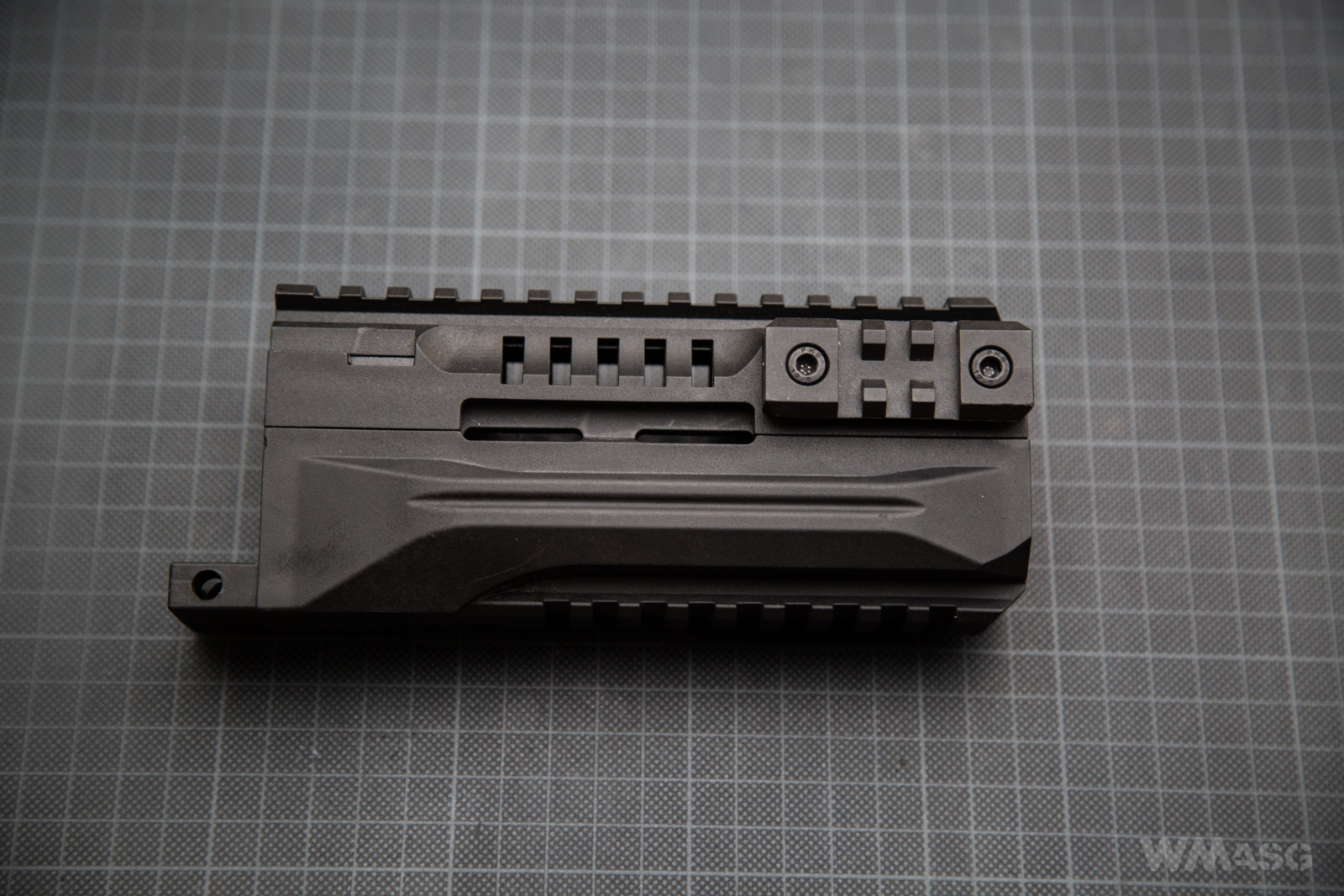
The red arrow indicates the location of pinning the lower handguard in the receiver. A bit higher, one of the few compromise simplifications that the LCT used. The pin that holds the barrel in the real carbine is a dummy in the replica.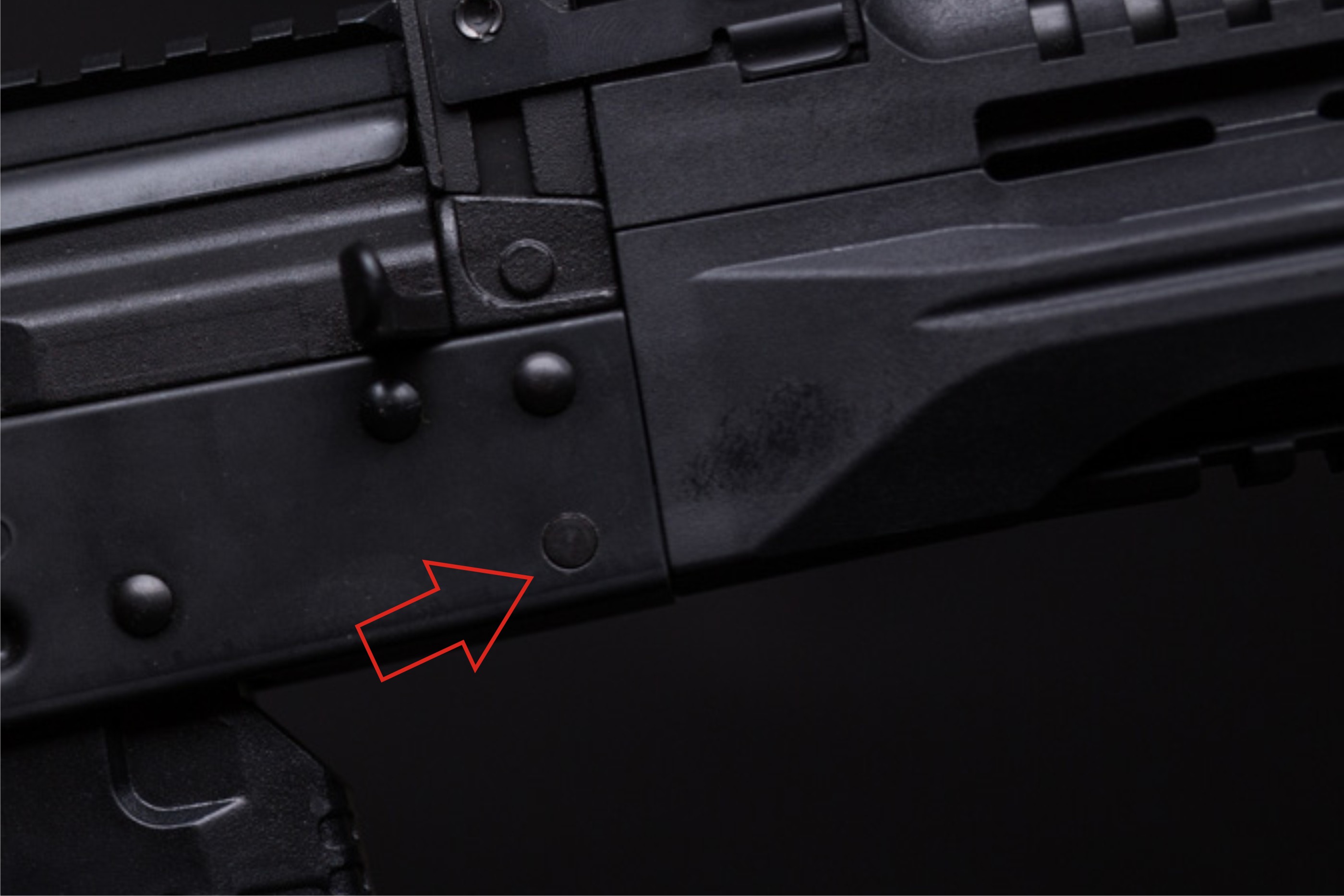 The receiver
The receiver
Right side of the receiver. In the place of the former gas tube retaining pin the AK-12 has a different one, used to lock receiver cover.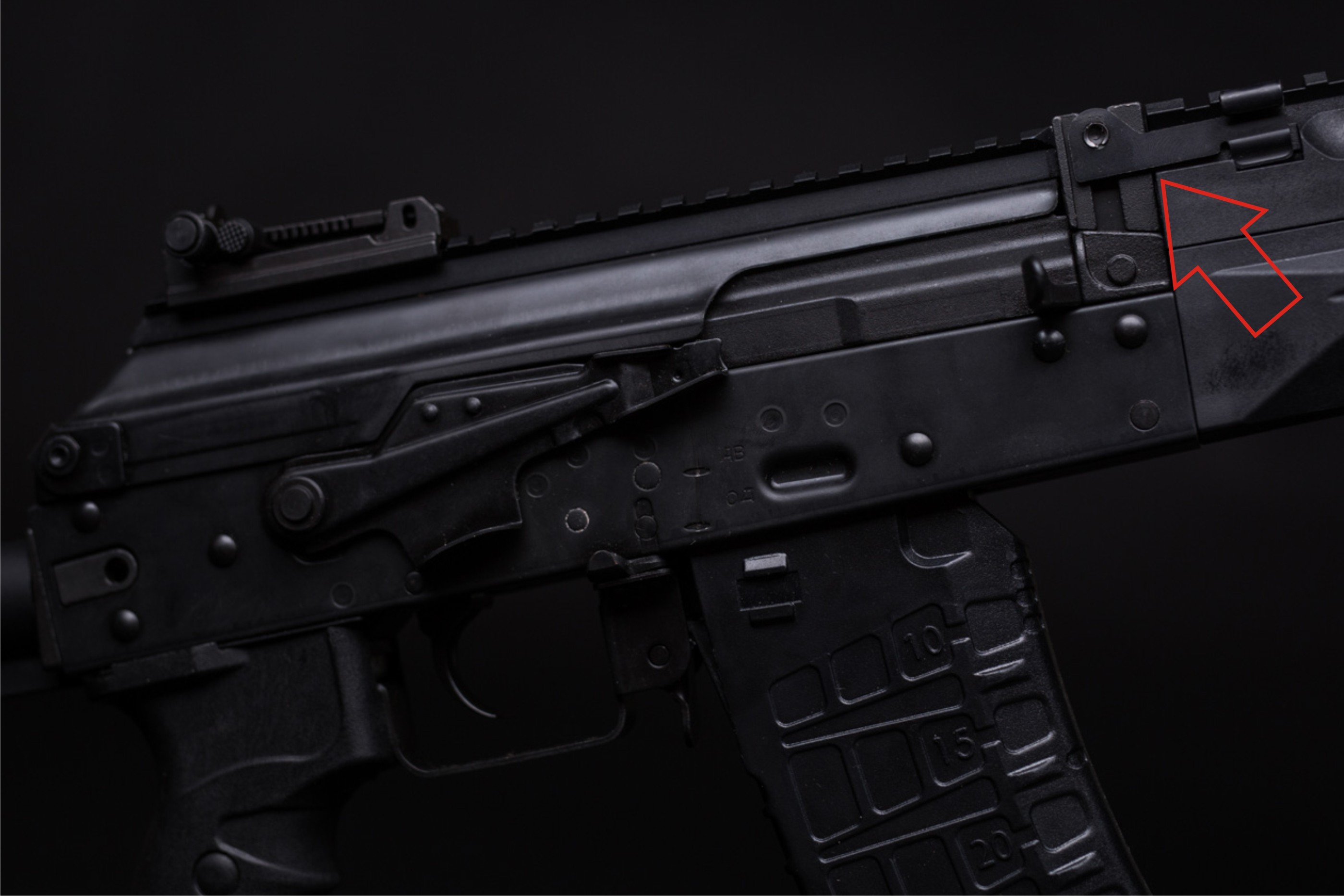 The safety selector lever is equipped with a "shelf" to facilitate operation. In practice, the lever moves with great resistance. It's hard to move it with your finger, especially downwards.
The safety selector lever is equipped with a "shelf" to facilitate operation. In practice, the lever moves with great resistance. It's hard to move it with your finger, especially downwards.
On the miniature, the same part in the real carbine. The safety selector lever has four settings: safe/full-auto/three round bust/single fire (red arrow). The replica does not shoot with the three round bust mode and thus has only three settings, standard for earlier AK versions (safe/full-auto/single fire). This is a disappointment.
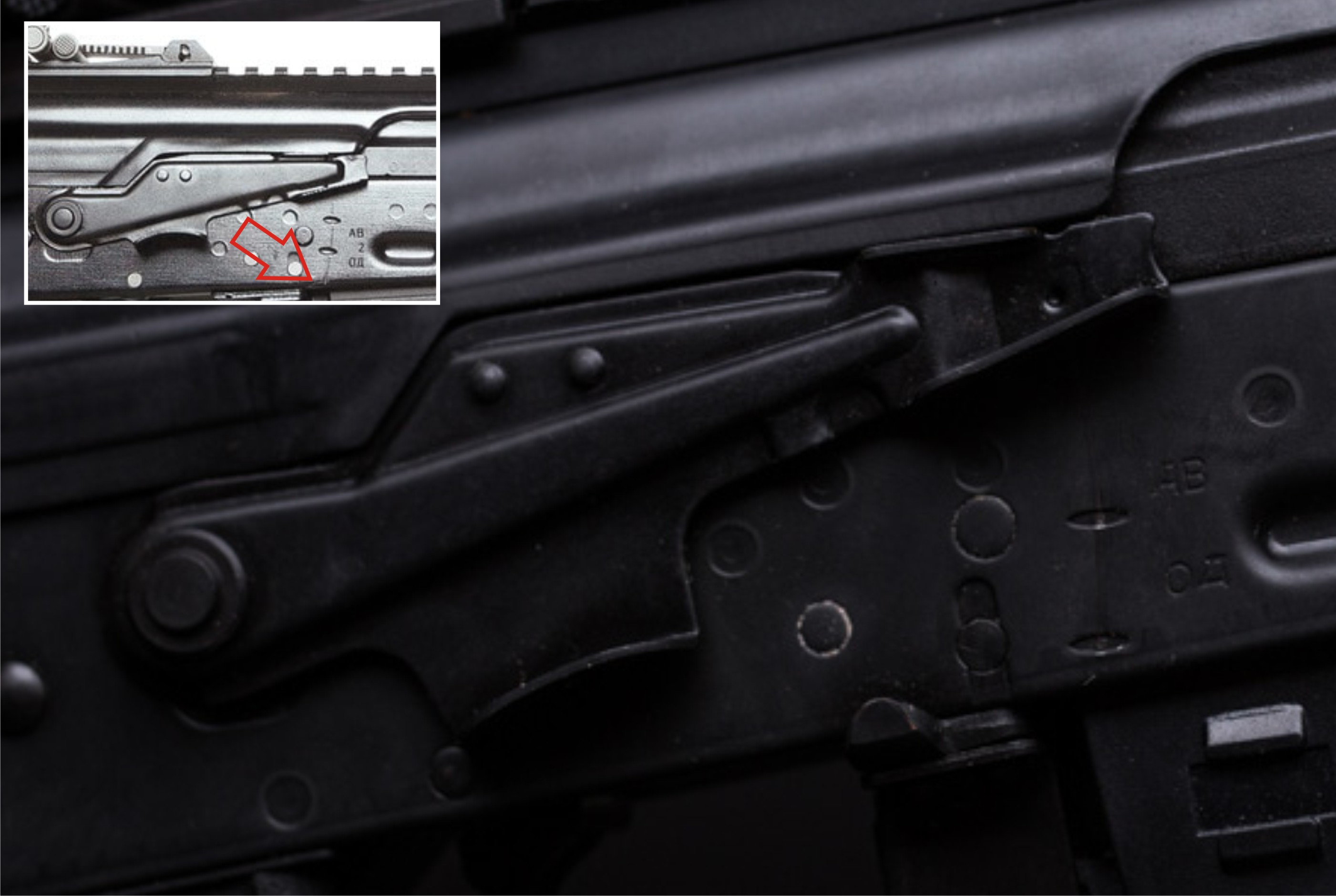
The other side of the receiver. It looks ordinary. A round button for folding the buttstock is visible. You can also see that the AK-12 does not have a typical receiver cover latch.
The AK-12 does not have the "claw" that locks a folded buttstock on the side as in the AK-74S, AK-74M or AKS-74U carbines. Locking of the buttstock has been solved in a different way. I do not know how it works in the original carbine but the solution used in the replica is an average one in my opinion, but I think it can be improved on my own.
The receiver cover
The receiver cover is another distinctive feature of the AK-12. First of all, it has a permanently riveted Picatinny rail. Secondly, due to the transfer of the rear sight assembly (iron and optical) directly to the cover, the method of mounting it has been changed. Until now, the receiver cover was held in place with a rear latch and wobbled to a lesser or greater extent. Now it is firmly secured to the receiver.
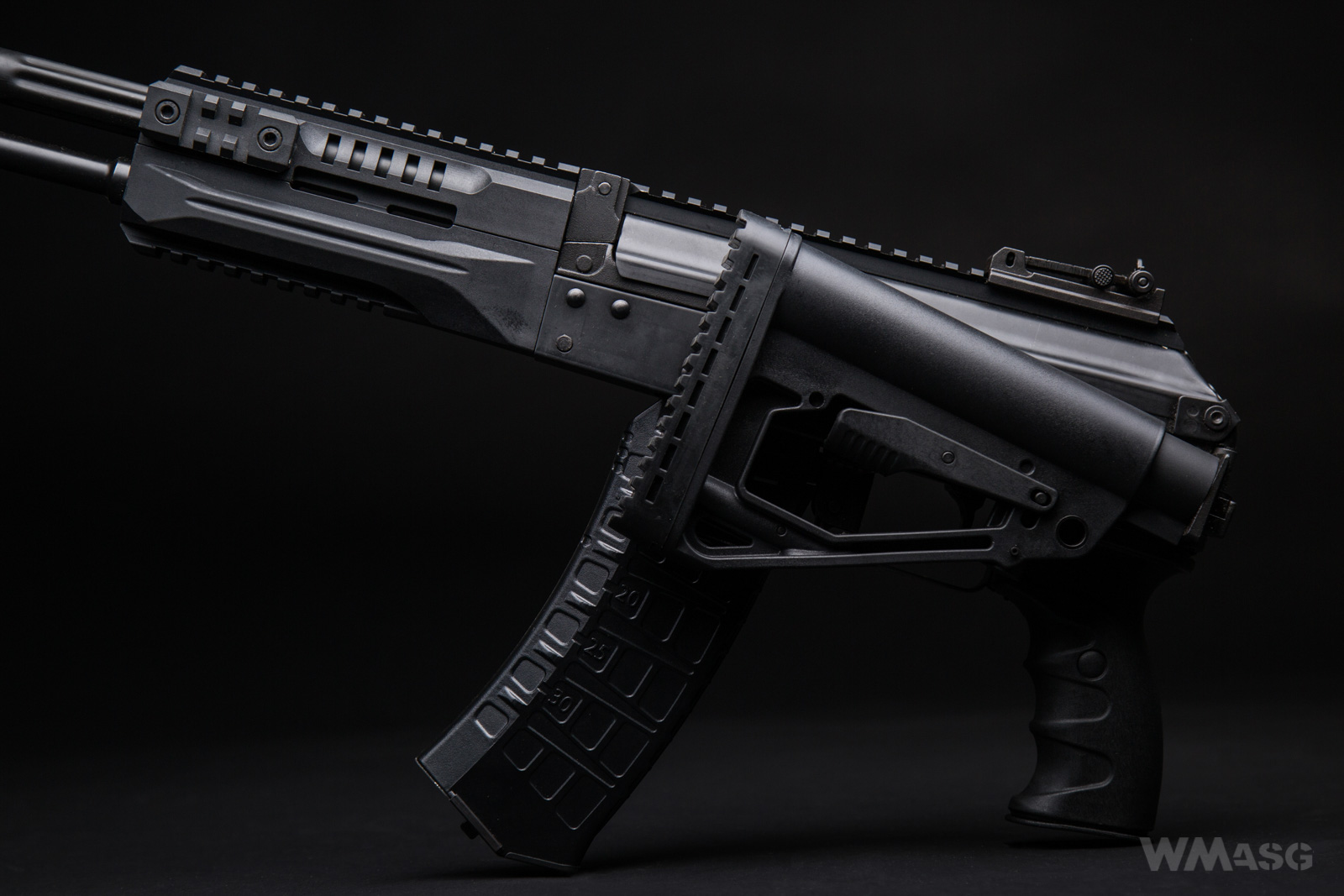
The method of removing the cover will be discussed in a moment, because the compartment for a stick type battery is provided under it. Meanwhile, the view of the connection between the receiver cover rail and the rail on top of the upper handguard. It is not perfectly aligned, but it is off by less than 1 millimeter.
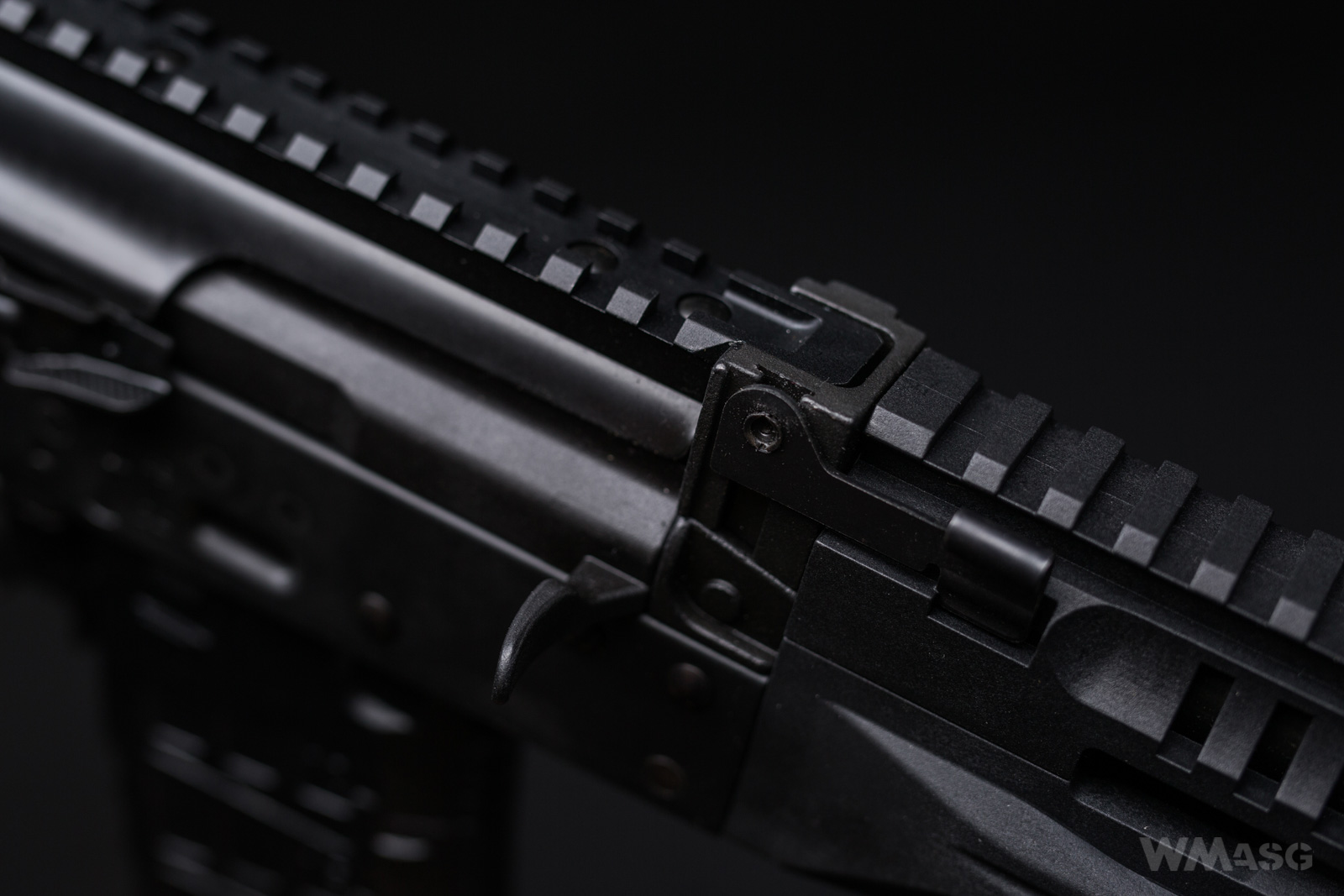
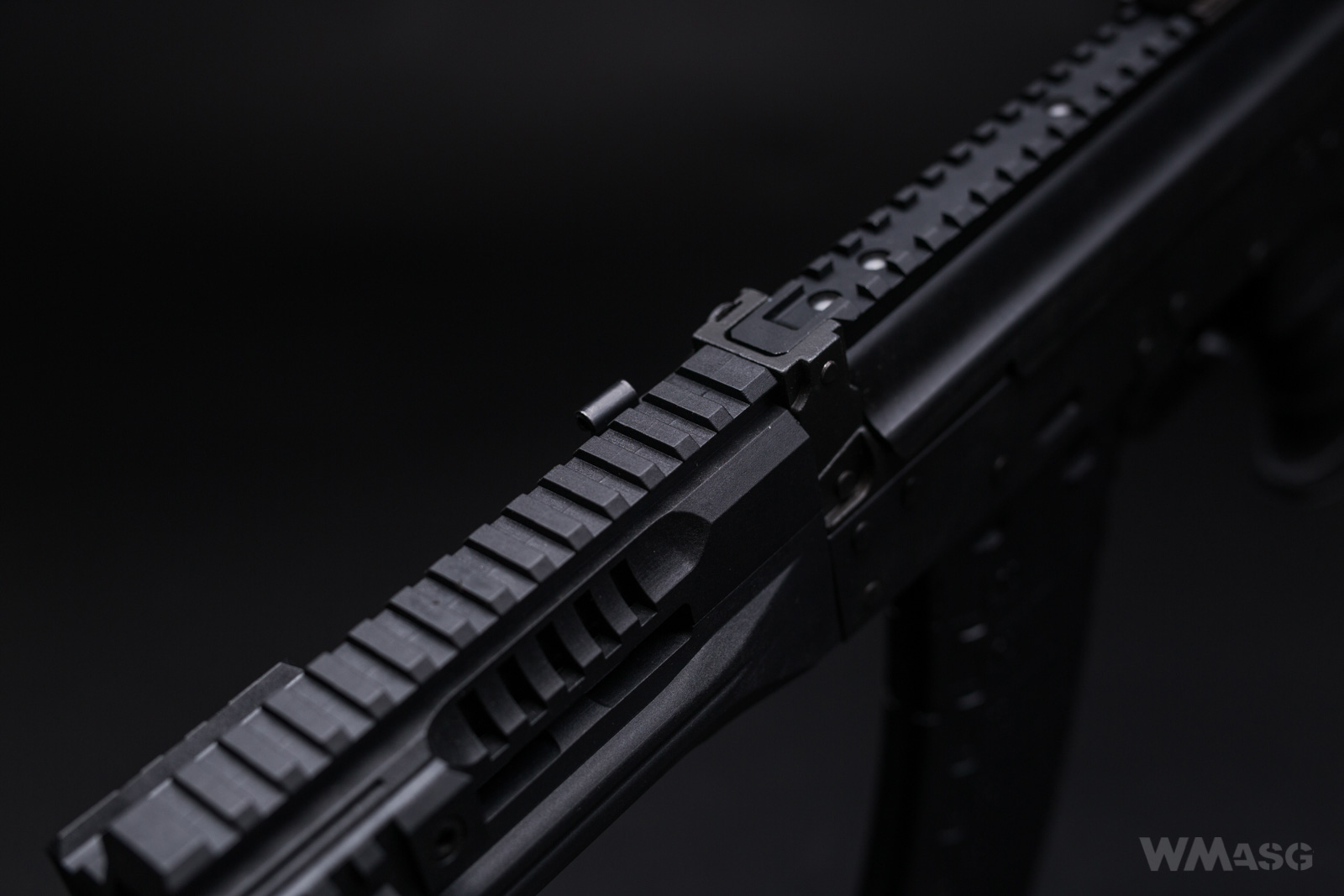
And a view from the back showing the place where the receiver cover latch used to be.
Removal of the receiver cover (to install a battery, for example).
Step 1 - raise the locking lever, in the way shown below, and then completely remove it from the socket.
Step 2 - pull the receiver cover towards the buttstock until it is completely detached from the replica.
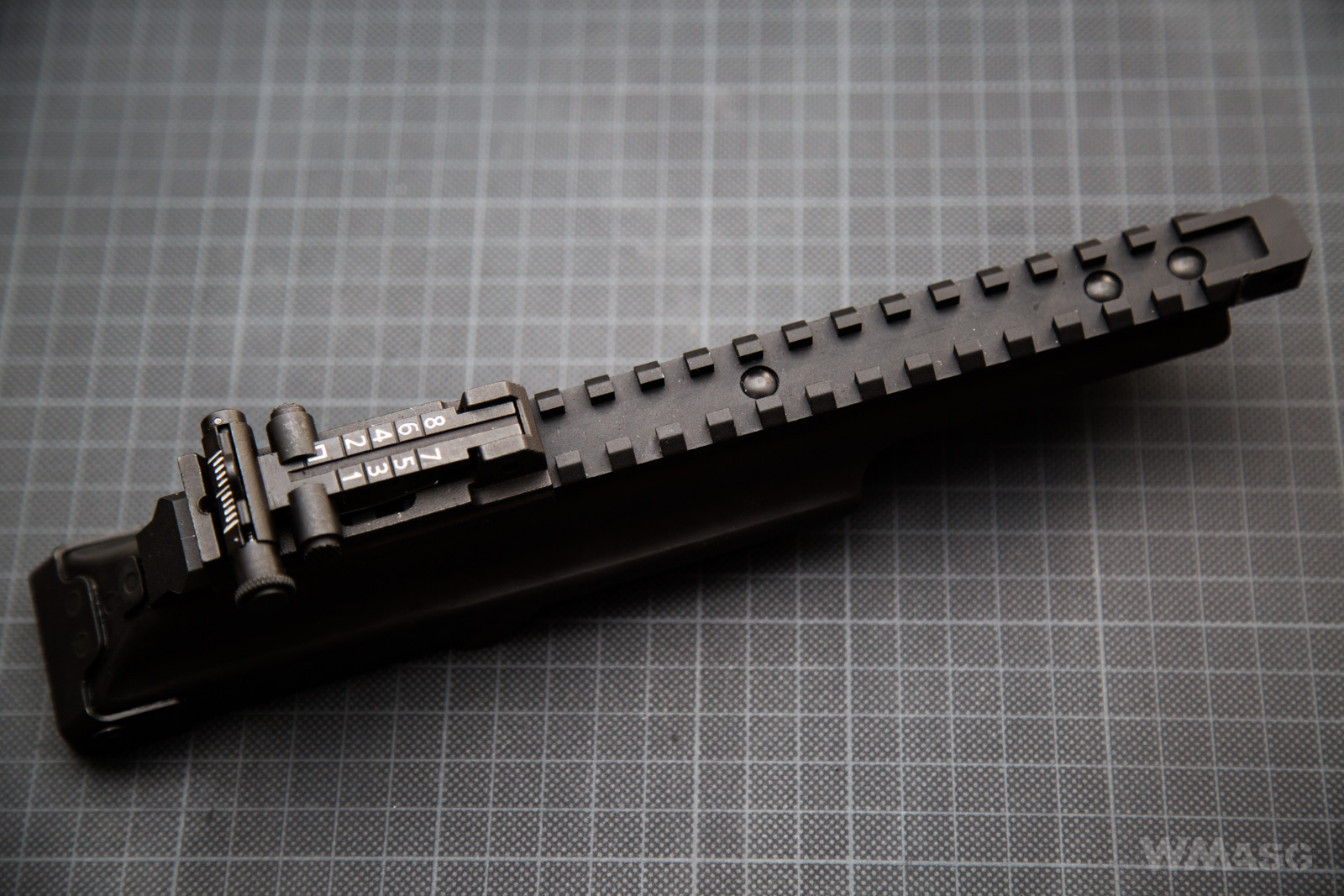
The part through which the locking pin passes through.
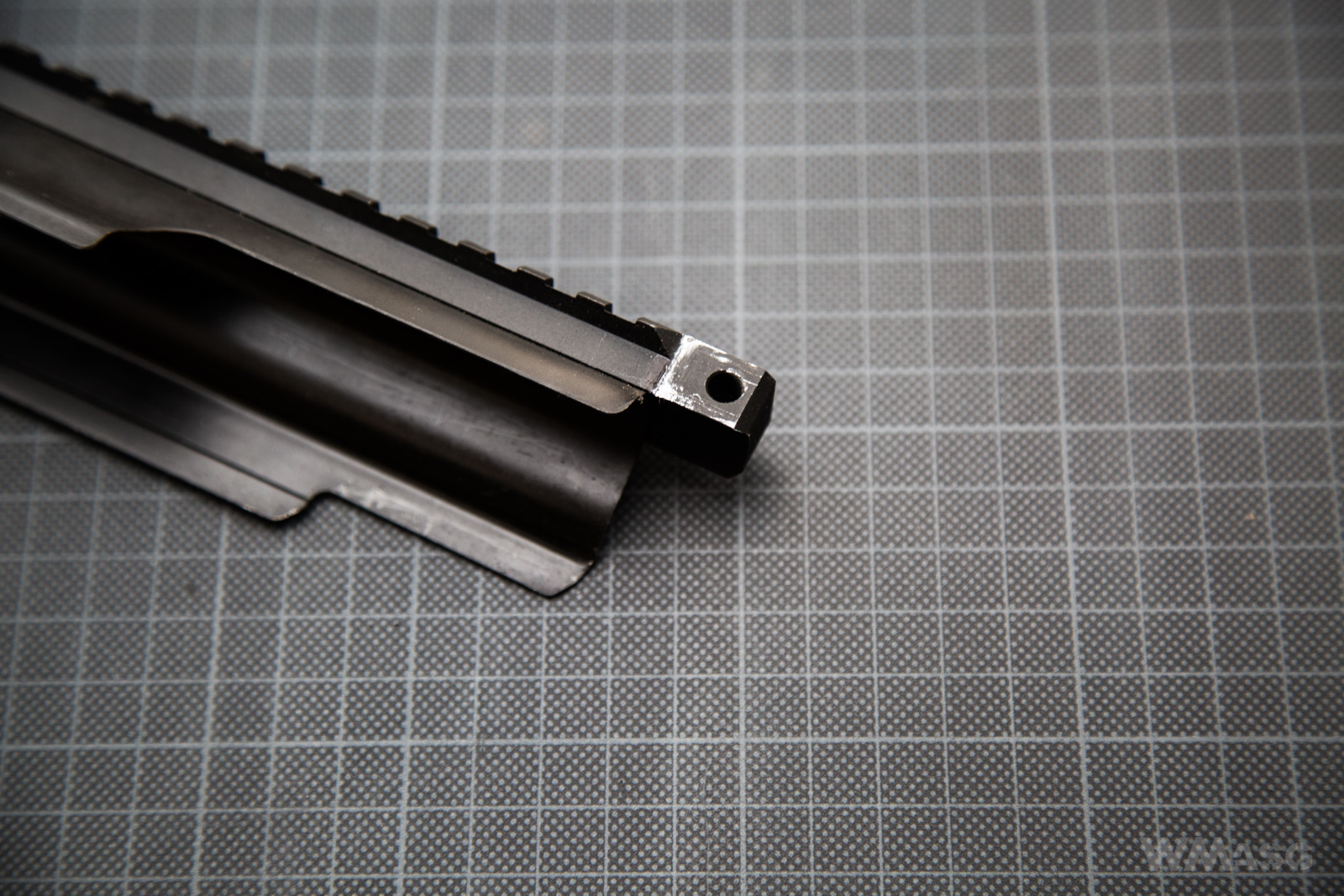
And the method of attaching the cover to the rear apart of the receiver. The upside-down cover is at the bottom.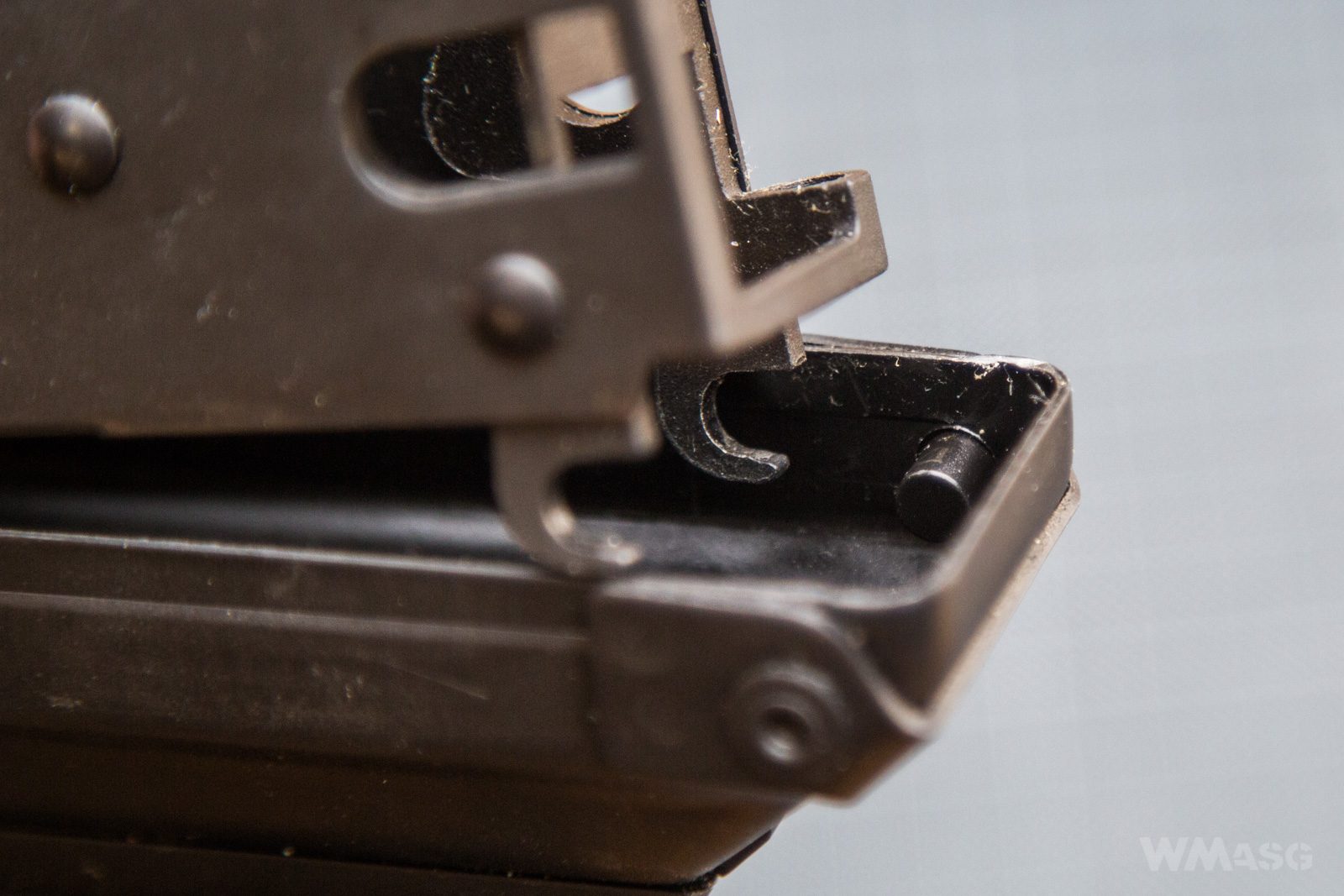
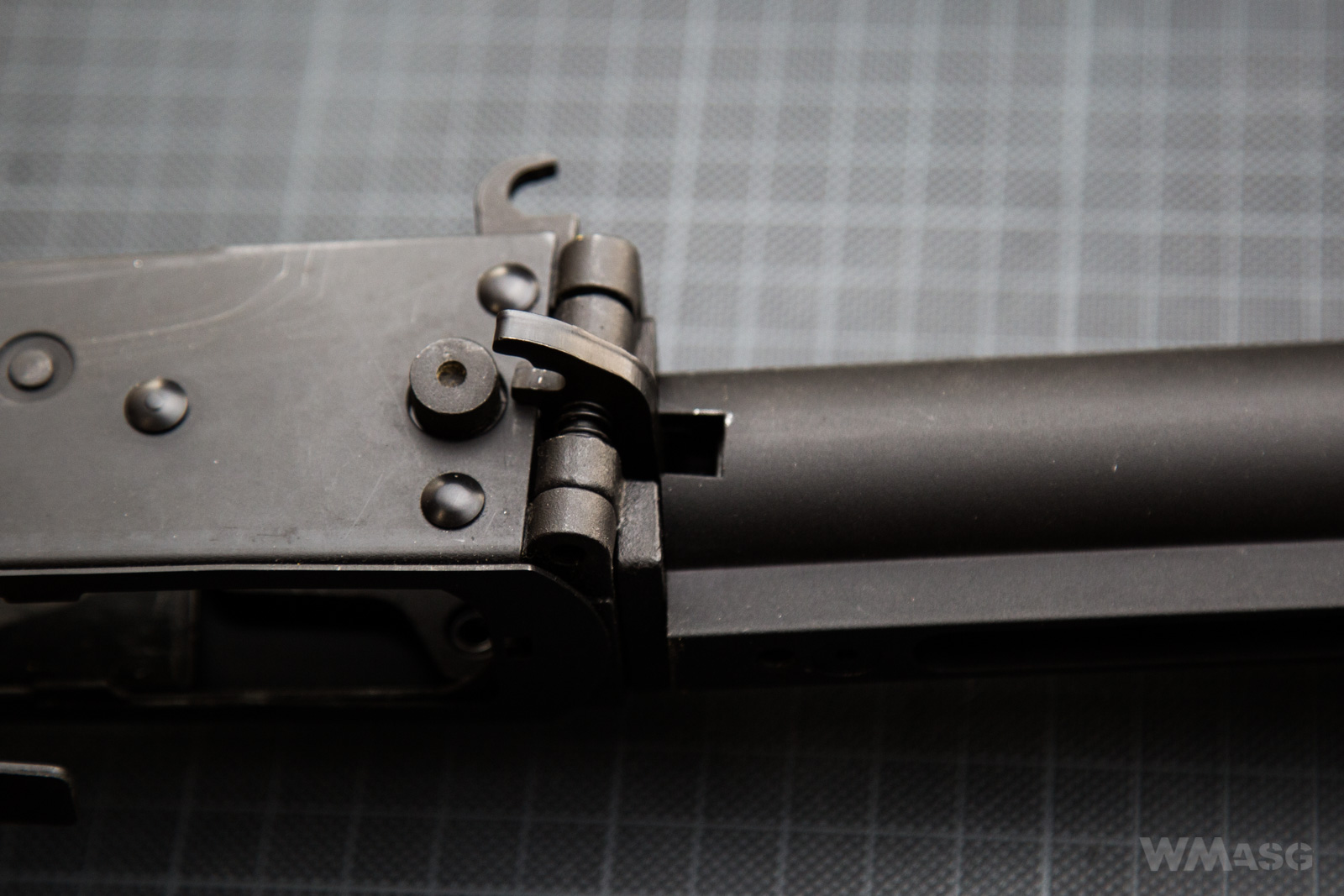
The buttstock![]()
The AK-12 has a side folded buttstock of adjustable length (with five settings). It folds to the left side. The buttstock is made of very hard plastic. Theoretically, there are no obstacles to using a replica with a buttstock folded to the side. However, the locking method leaves a lot to be desired. The buttstock does not stick to the receiver and moves slightly. This is the obvious the fault of the hook that does not keep it in one position.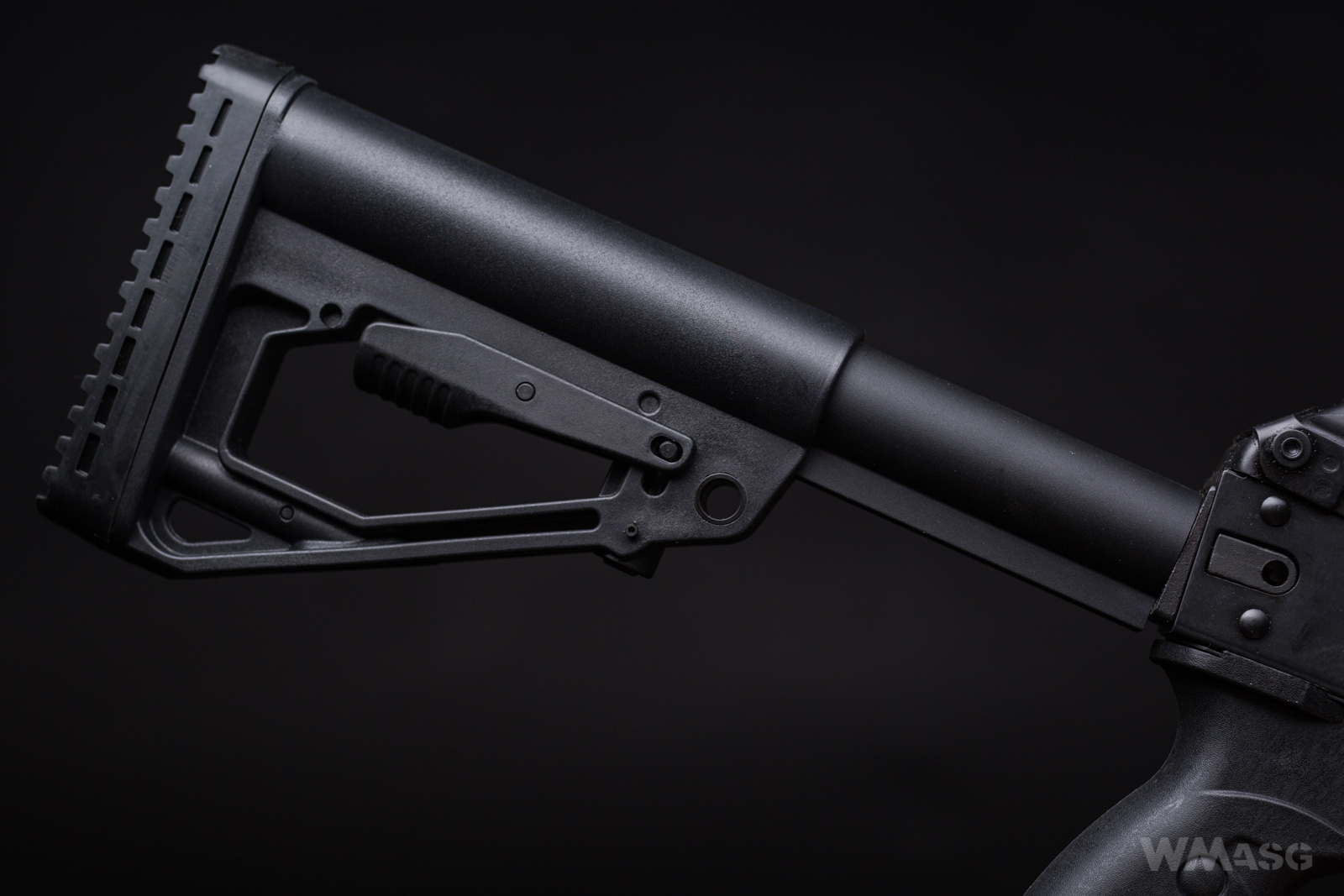
In the original, you can probably use aftermarket buttstocks complying with the AR-15 standard, because the stock guide looks very similar. Our efforts with the replica gave mixed results. That is, several AR-15 replicas' buttstocks fit right off the bat. In several other cases, it would be necessary to intervene with a file.
It is worth mentioning two things here. The first one is QD type carrying sling mounting point, which is clearly visible in the photo above. The second is the possibility of sliding the rubber back plate off.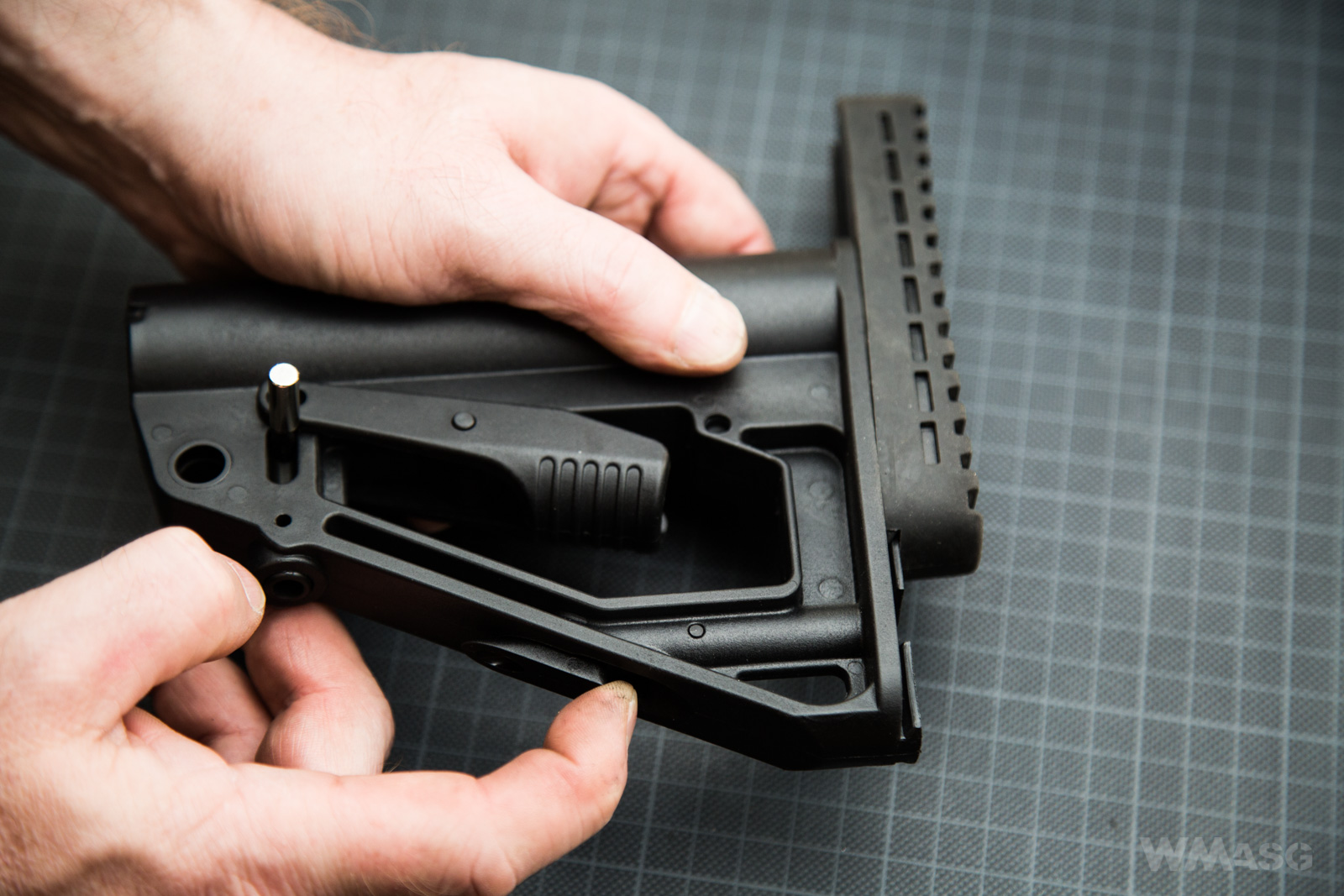
The original in the buttstock guide houses a toolbox with a multi part cleaning rod strut and a key for adjusting the front sight. There is no toolbox in the replica. Unfortunately, I can not say if the one from the real carbine would fit inside the guide.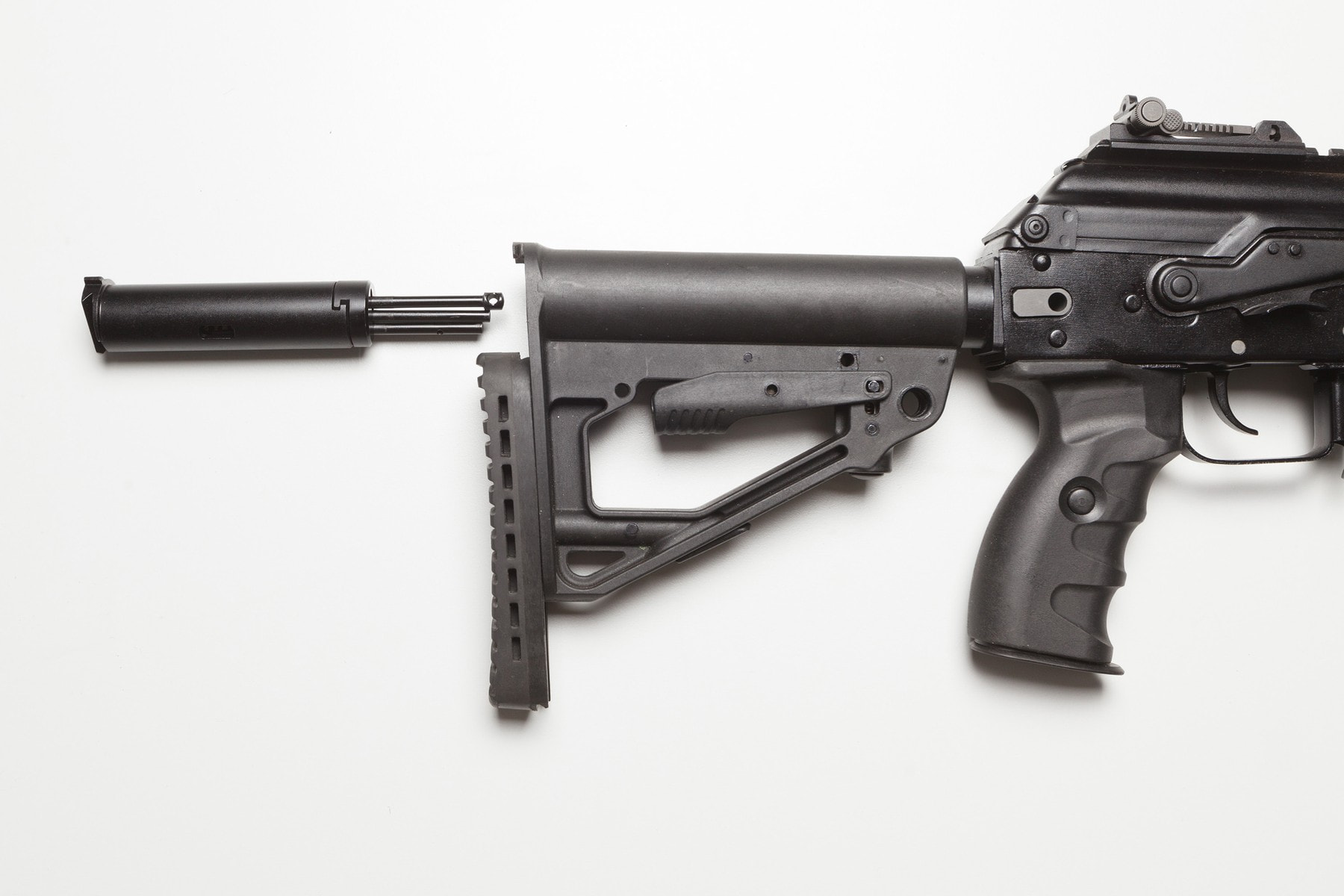
Folding and unfolding of the buttstock
View of the latch - stock folded.
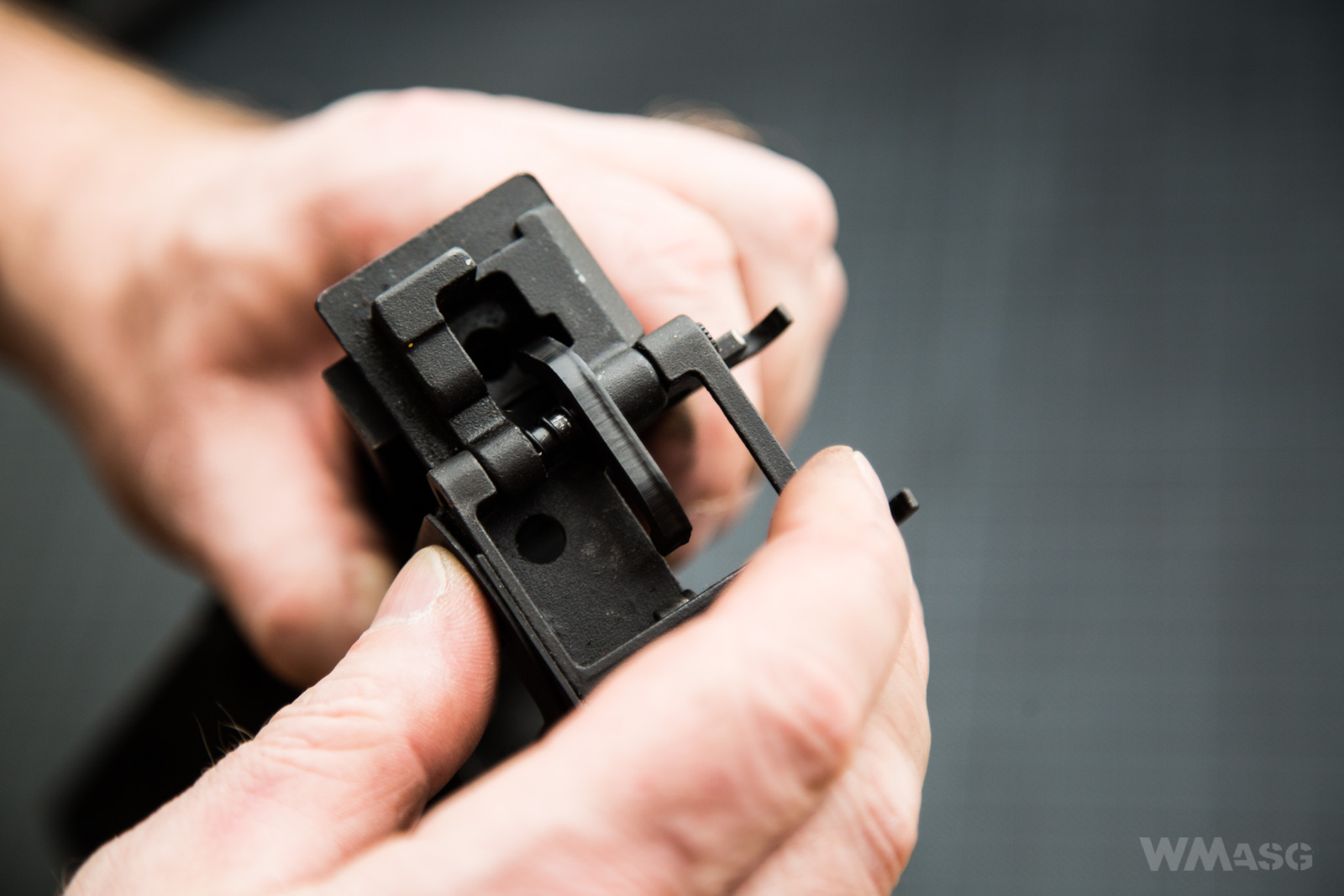
To unfold the buttstock, press and hold the latch and unfold the buttstock at the same time.
The pistol grip
The AK-12 has a small storage compartment in pistol grip.
The replica's grip looks very similar. For obvious reasons (the motor) round part, which in the real grip is a two-sided button used to open the storage compartment tray, in the airsoft version is just a deco.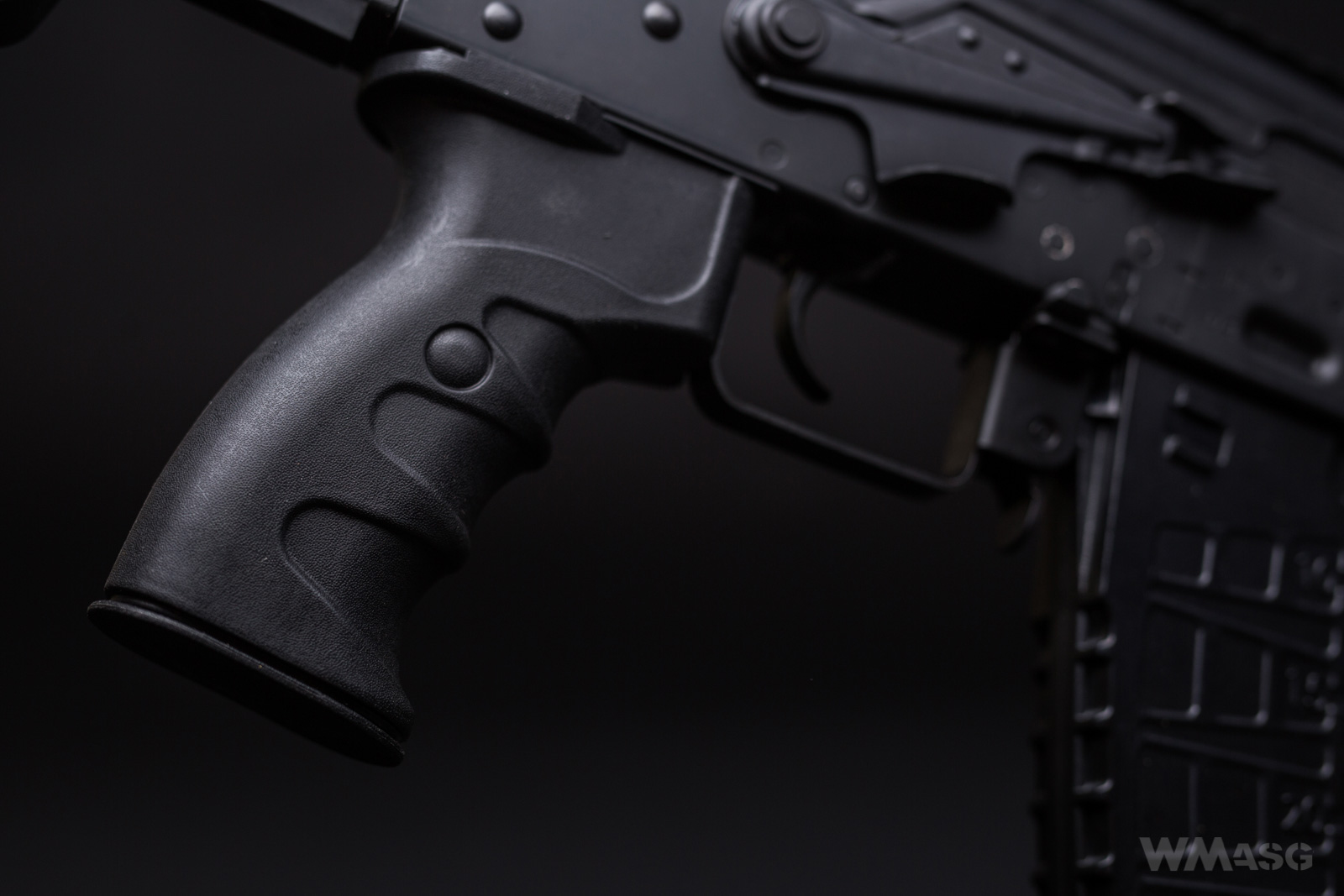
The mounting screw and motor adjustment screw are hidden under the bottom cap similar to the bottom of the storage compartment tray.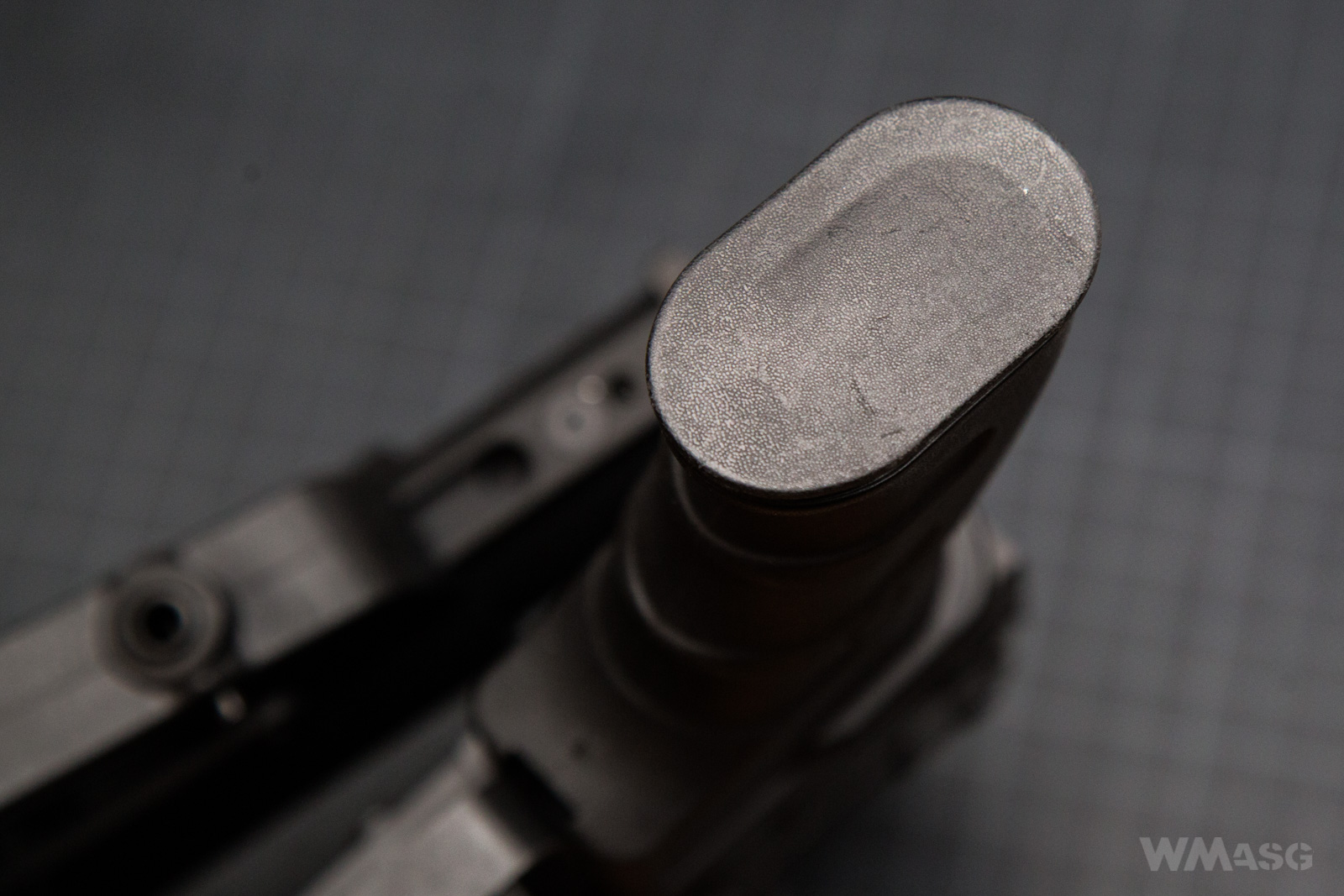
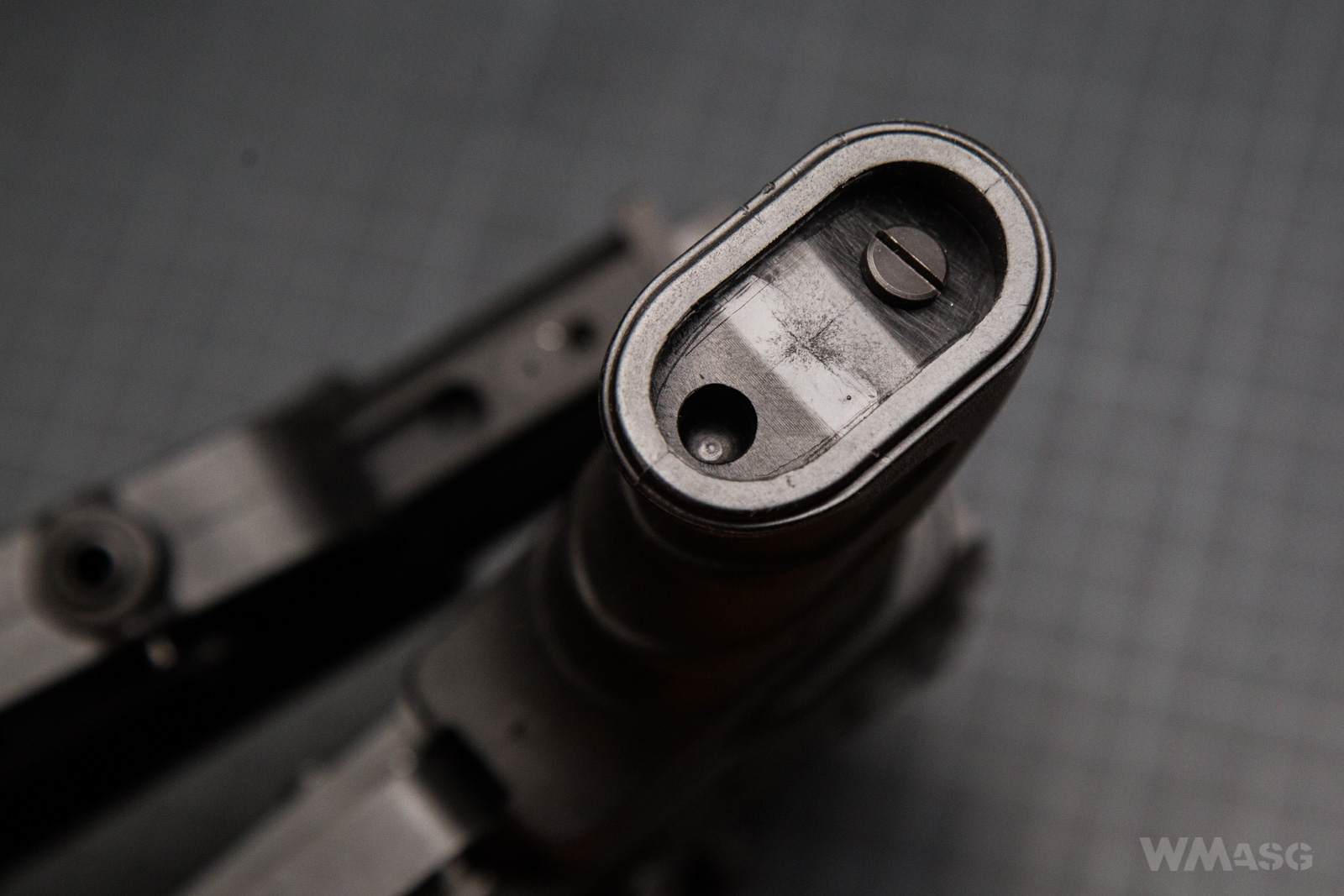
The sights
The front sight is adjusted vertically by screwing it into and from the base. The drum that allowed you to move right or left has been dropped.
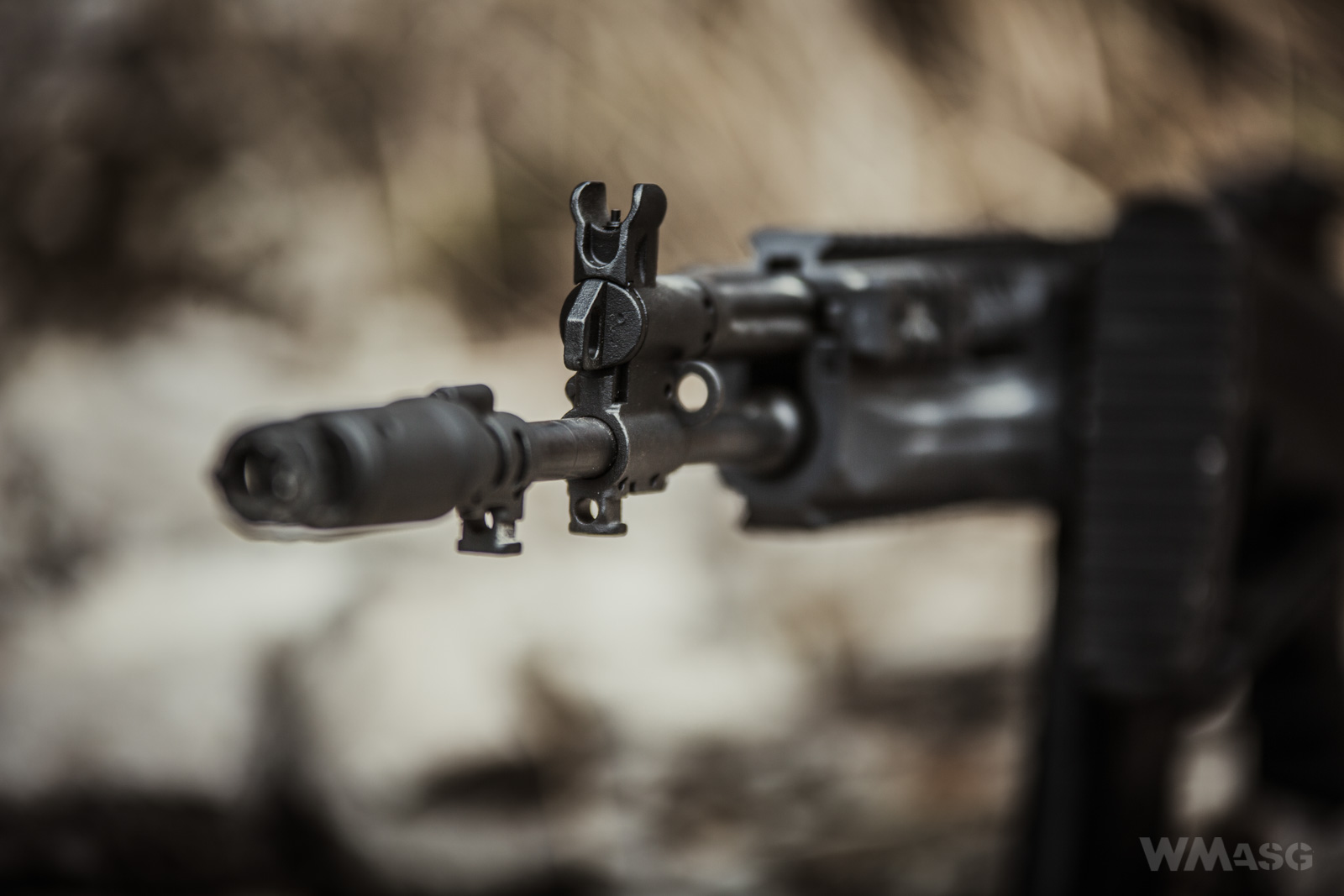
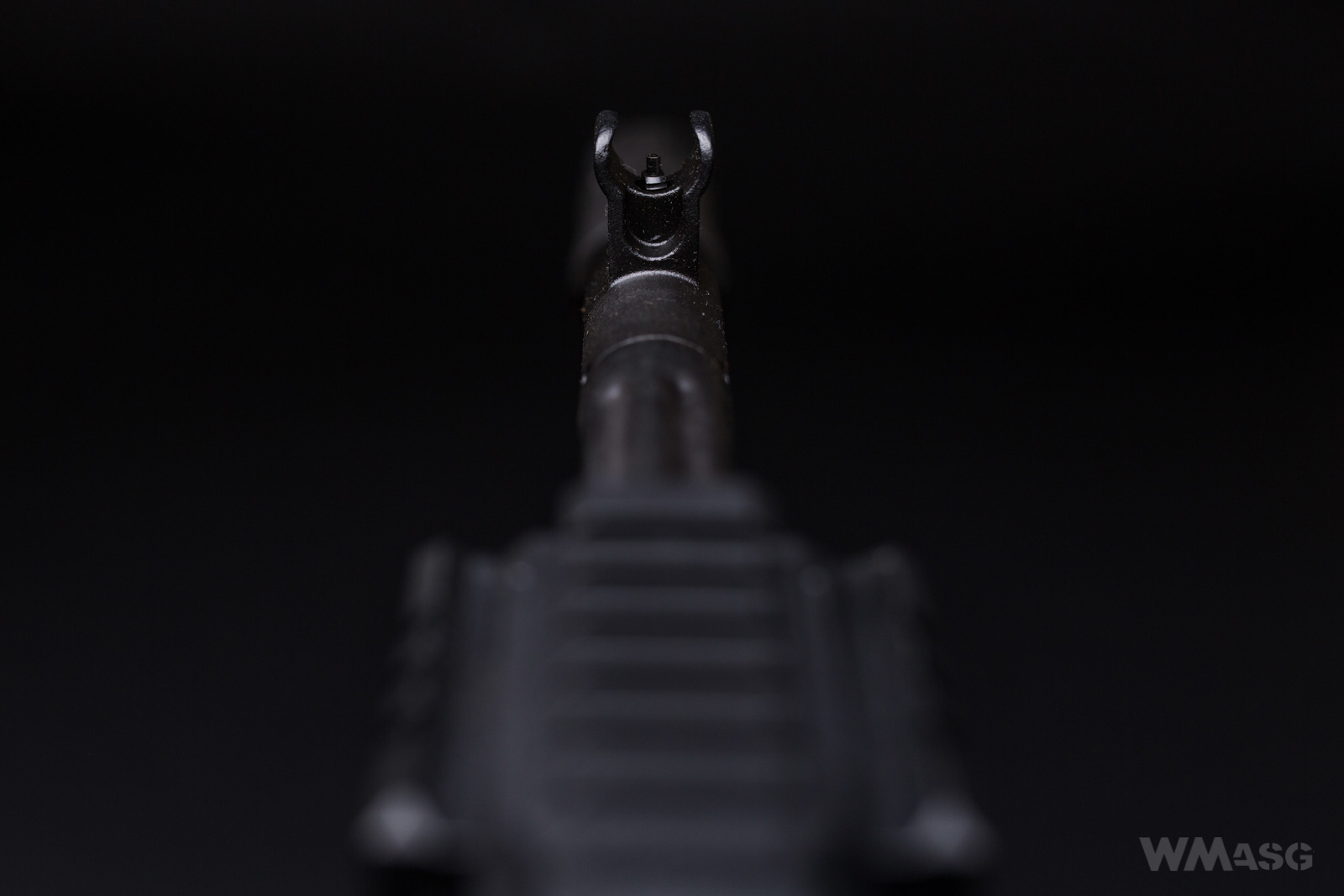
The rear sight used is a certain novelty.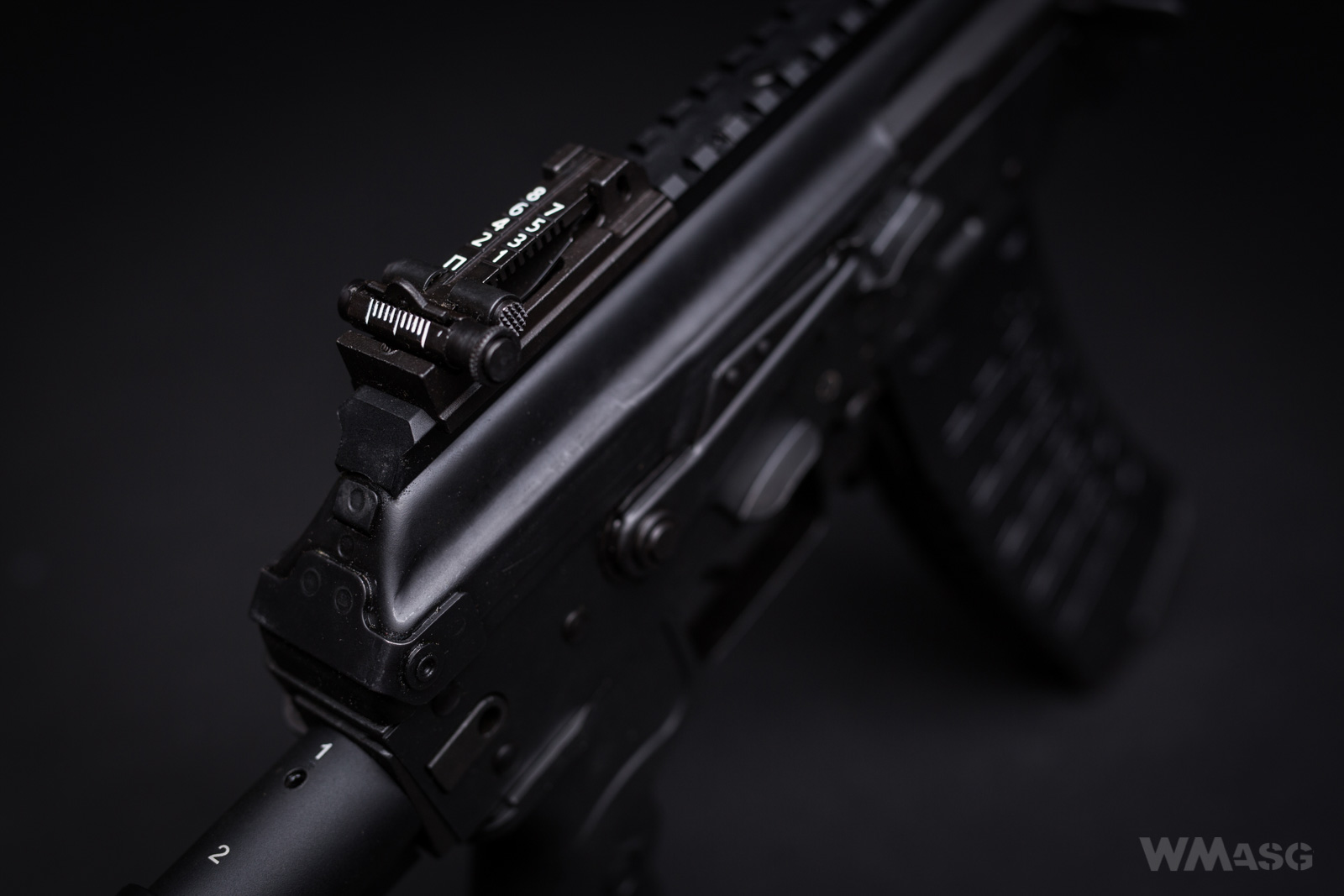 First off all, it was moved backwards to the edge of the receiver cover to extend the aiming line and thus improve the accuracy of the weapon. Secondly, an aperture has been used in place of the open sight which has been in used for many years now. Thirdly, apart from the standard adjustment (scaling according to the distance from the target) there is also a left/right adjustment that resembles sight found in support weapons.
First off all, it was moved backwards to the edge of the receiver cover to extend the aiming line and thus improve the accuracy of the weapon. Secondly, an aperture has been used in place of the open sight which has been in used for many years now. Thirdly, apart from the standard adjustment (scaling according to the distance from the target) there is also a left/right adjustment that resembles sight found in support weapons.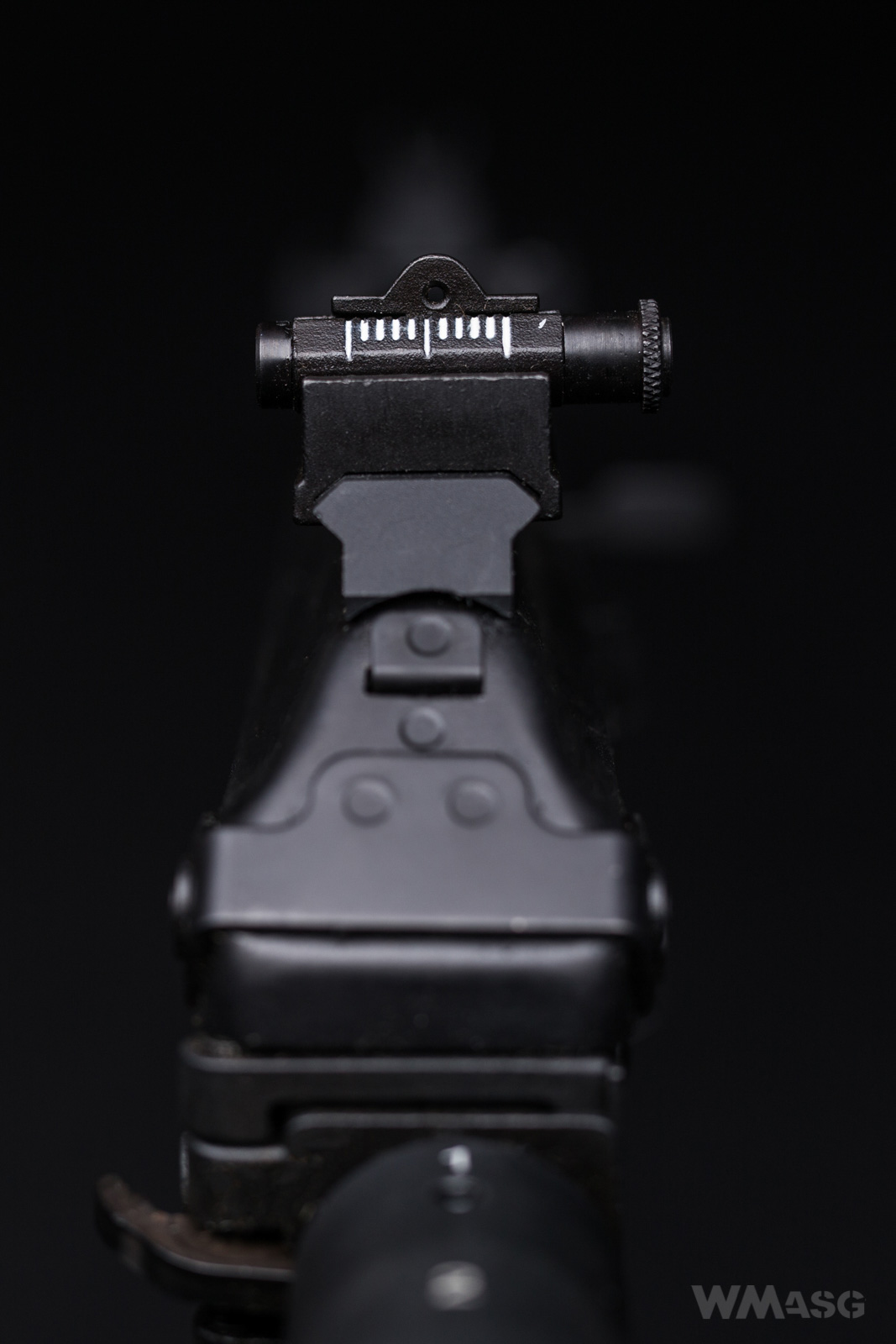
I'm being picky, but while discussing the sight's aperture, I will pay attention to two imperfections. First of all, the sight's base has a small clearance. When moving the sight with your fingers, we move the aperture hole by more than a millimeter.
Secondly, the aperture also moves backwards and forwards slightly.
Both things things definitely affect the accuracy of the replica. But on the other hand, we are shooting with plastic BBs which have close to none ballistics at a distance of 50-60 meters. And above all, the looseness can be deleted.
The inner barrel, the HopUp chamber and adjustment
In this respect, the replica is a standard AK carbine. Access to the chamber is obtained after pulling the dummy bolt carrier back.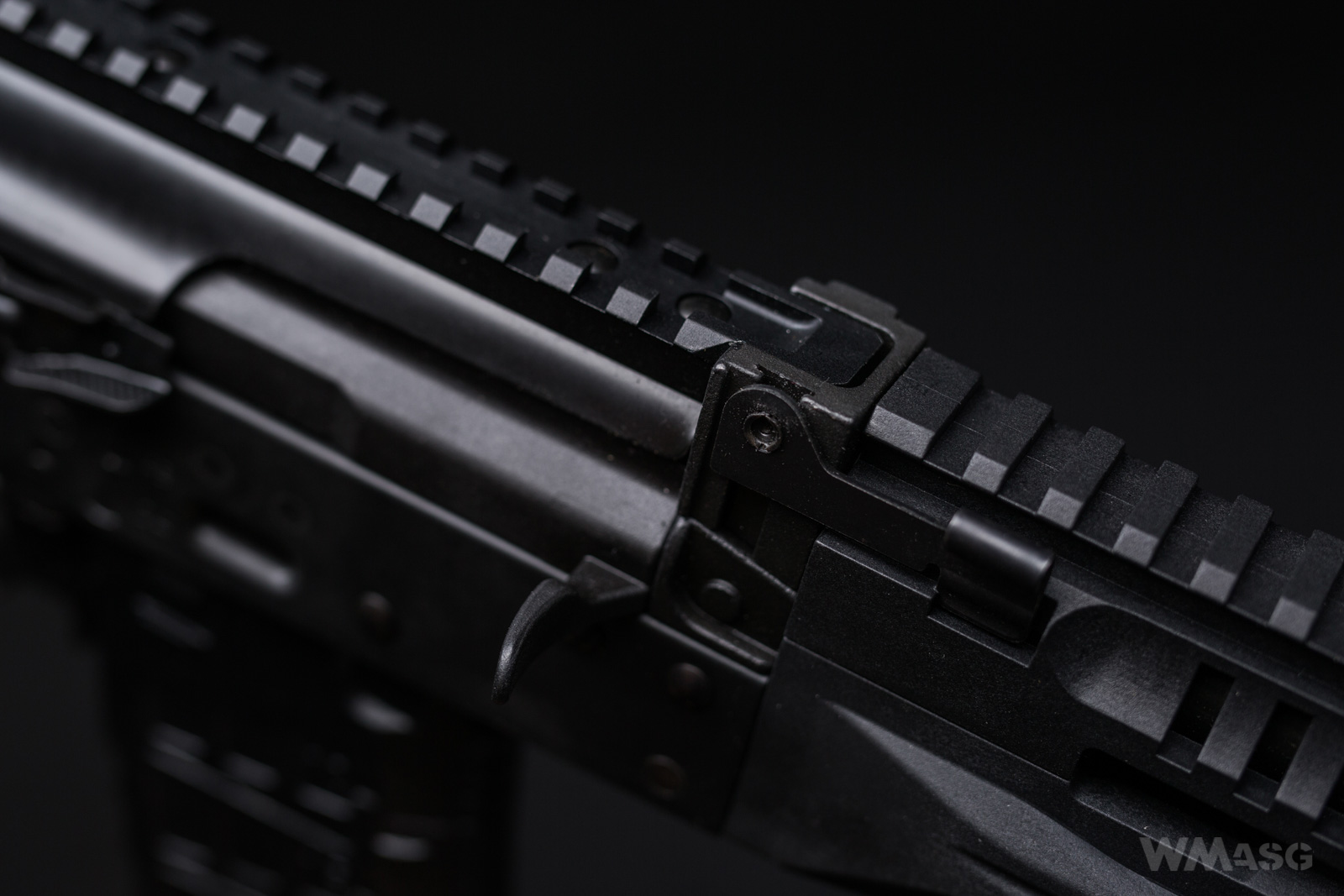
The manufacturer does not give the inner diameter of the barrel. Its length is 435 mm. It seems, however, that you can also use a barrel with a length of 455 mm. It will be a bit longer that the external barrel, but will not protrude from the flash hider. The HopUp chamber is a standard AK chamber.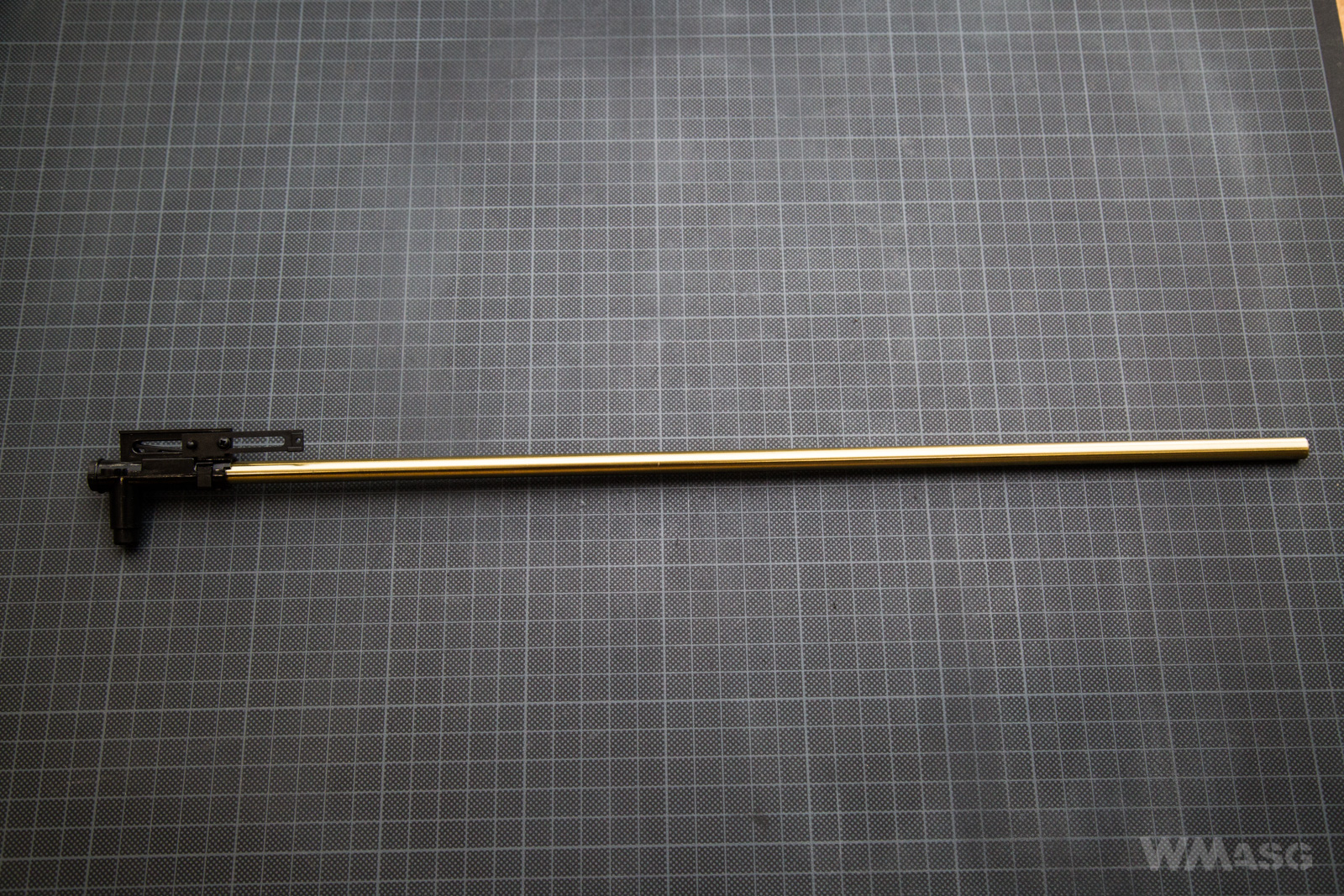
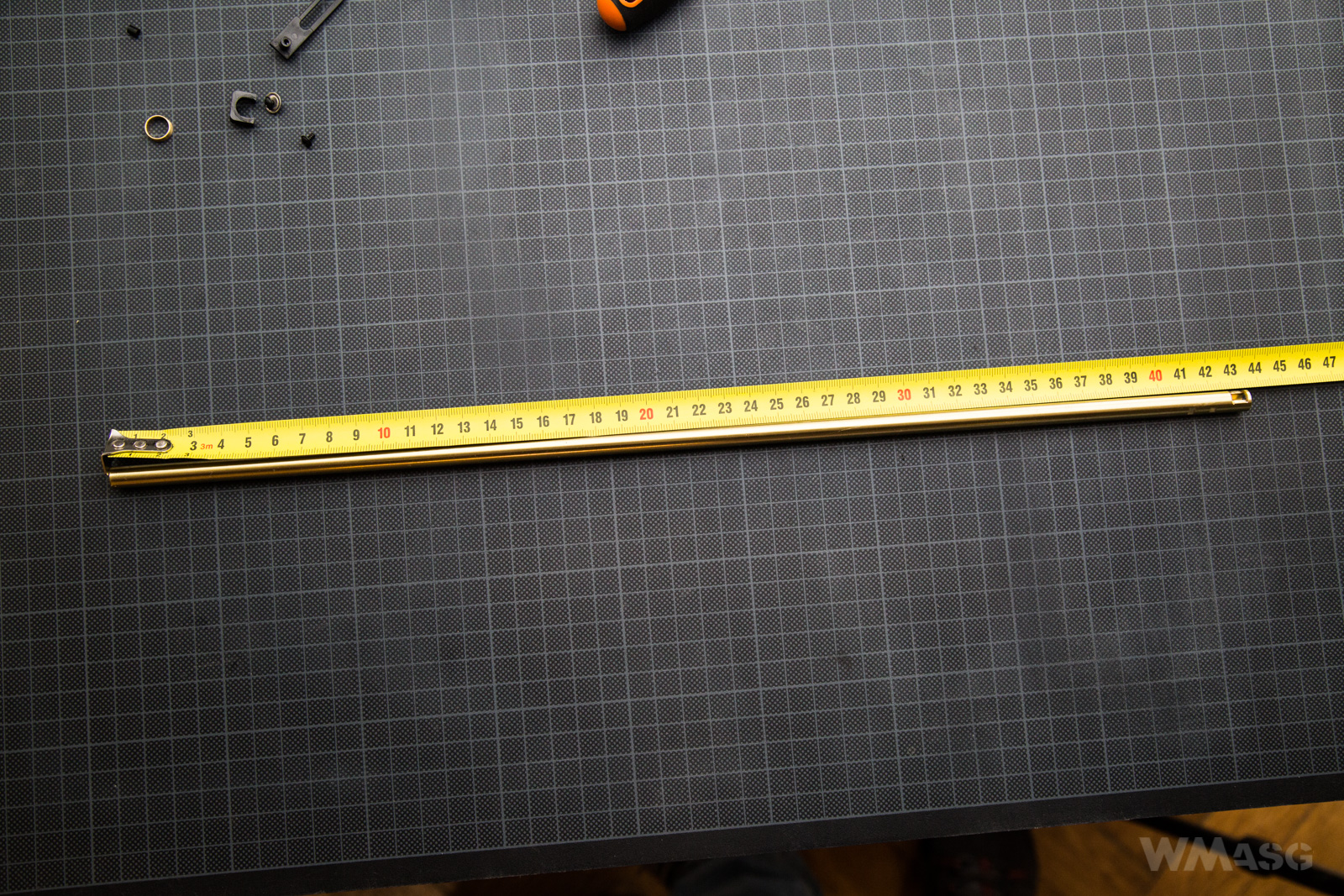
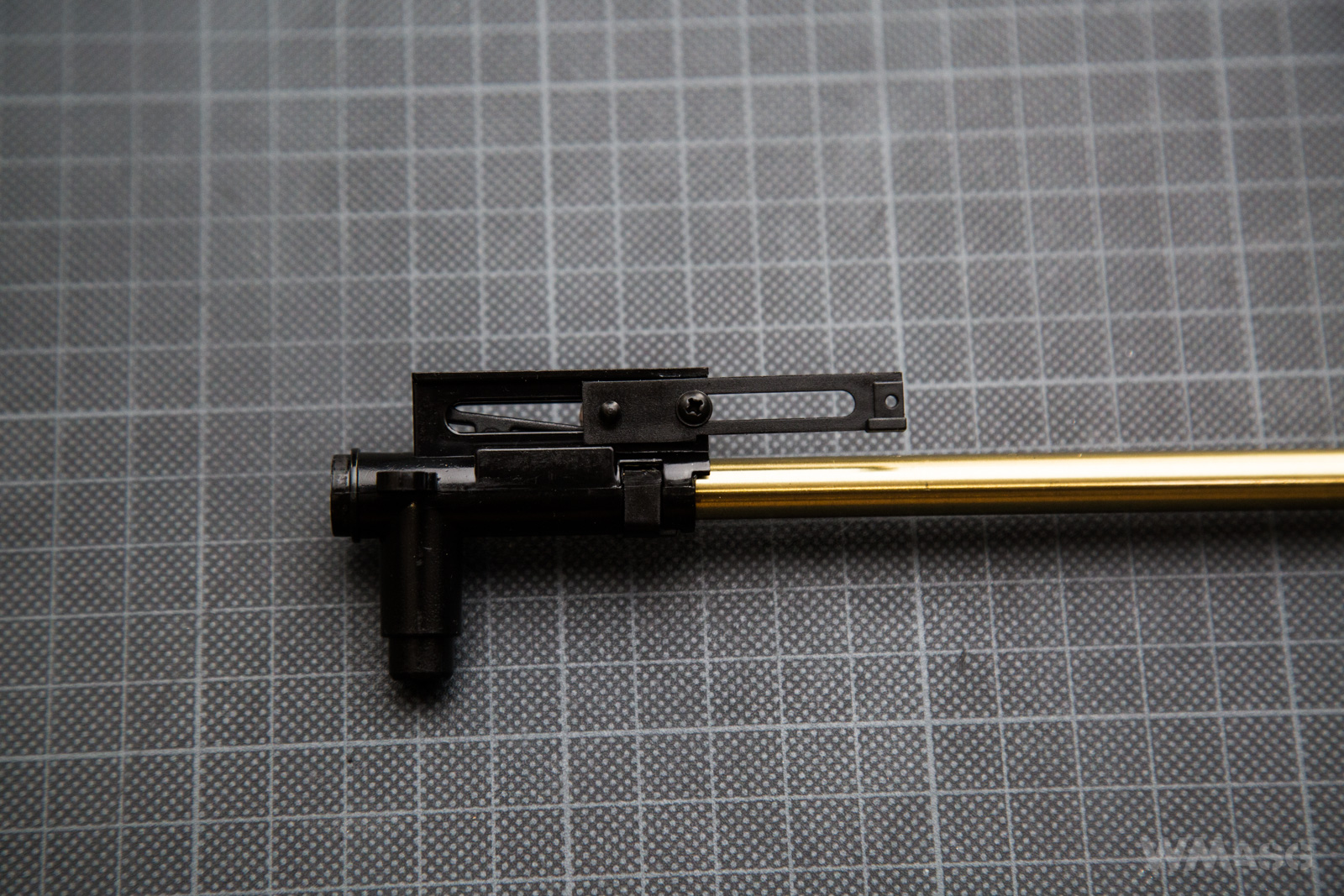
At the beginning I wrote about the ringing sounds that came out of the replica while shaking it. The first source of sound was the carrying sling swivel. The second one, which I promised to discuss later, was coming from the inner barrel, which is clearly loose in the external barrel. The effect, ringing sound and a drop in accuracy. However, once again solving this problem on my own, by stabilizing the barrel, was very easy to do.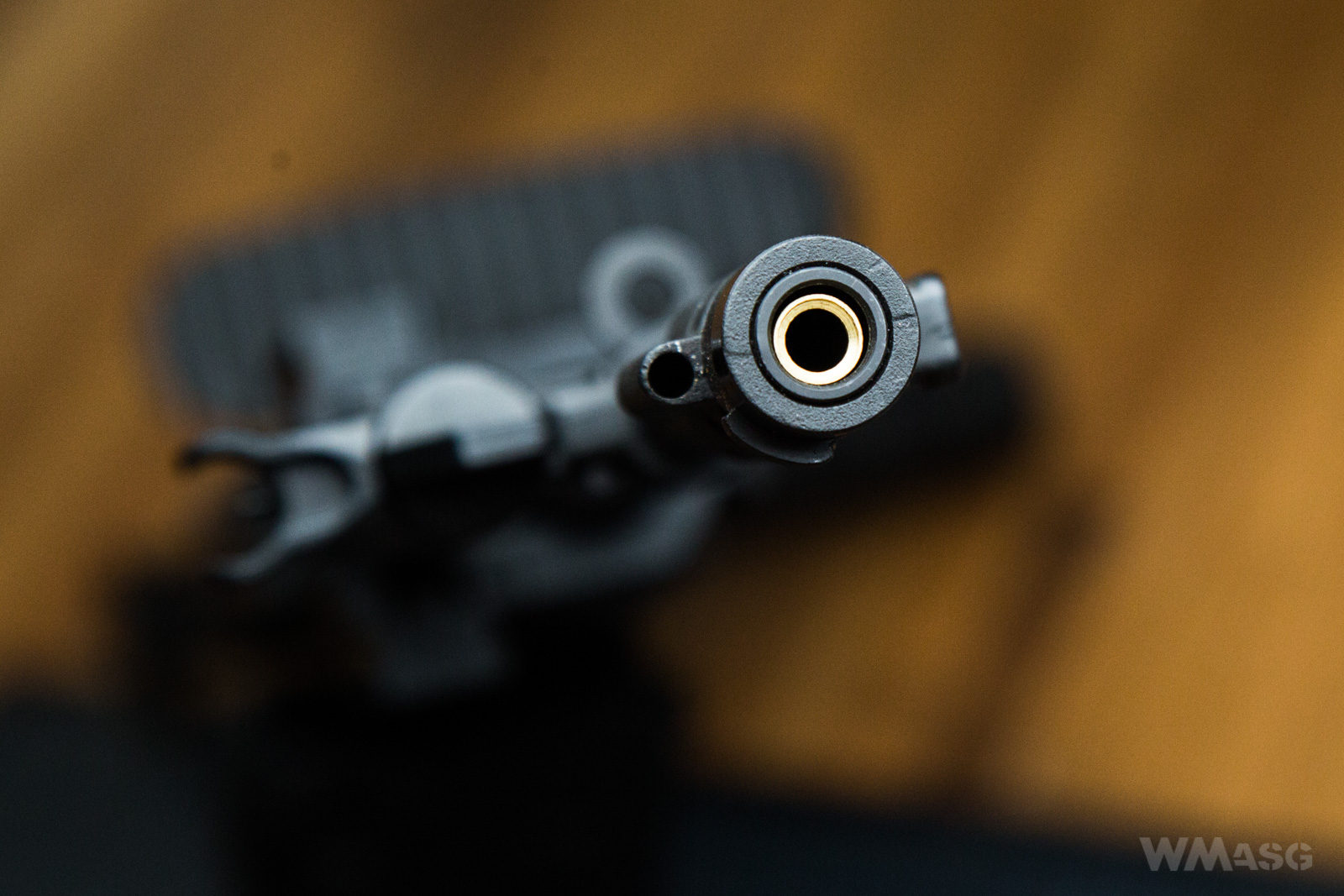
The magazine![]()
The tested replica is the AK-12, that's why in the set we received a replica of a magazine for the 5.45x39 mm round. It's a mid-cap holding 130 BBs.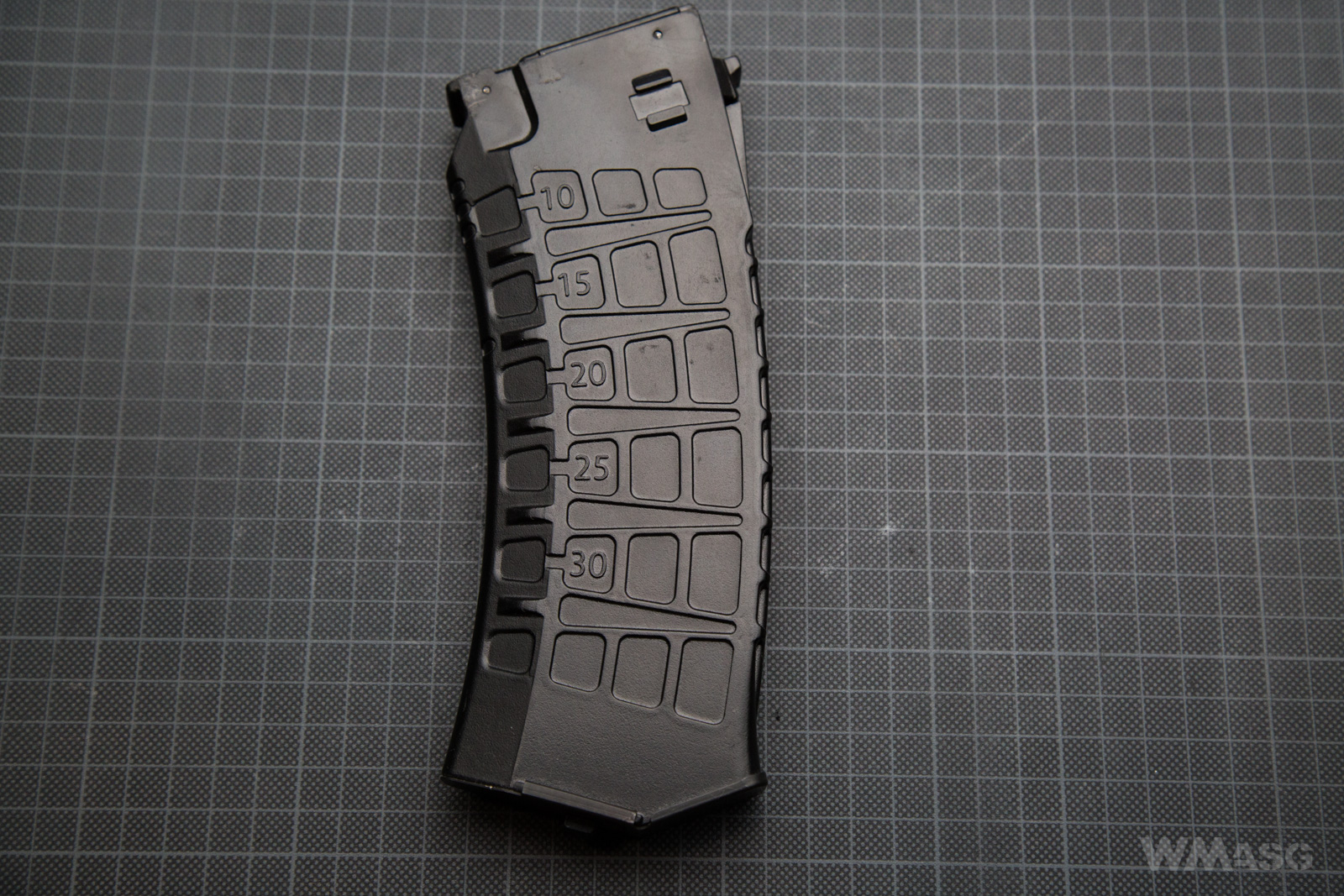
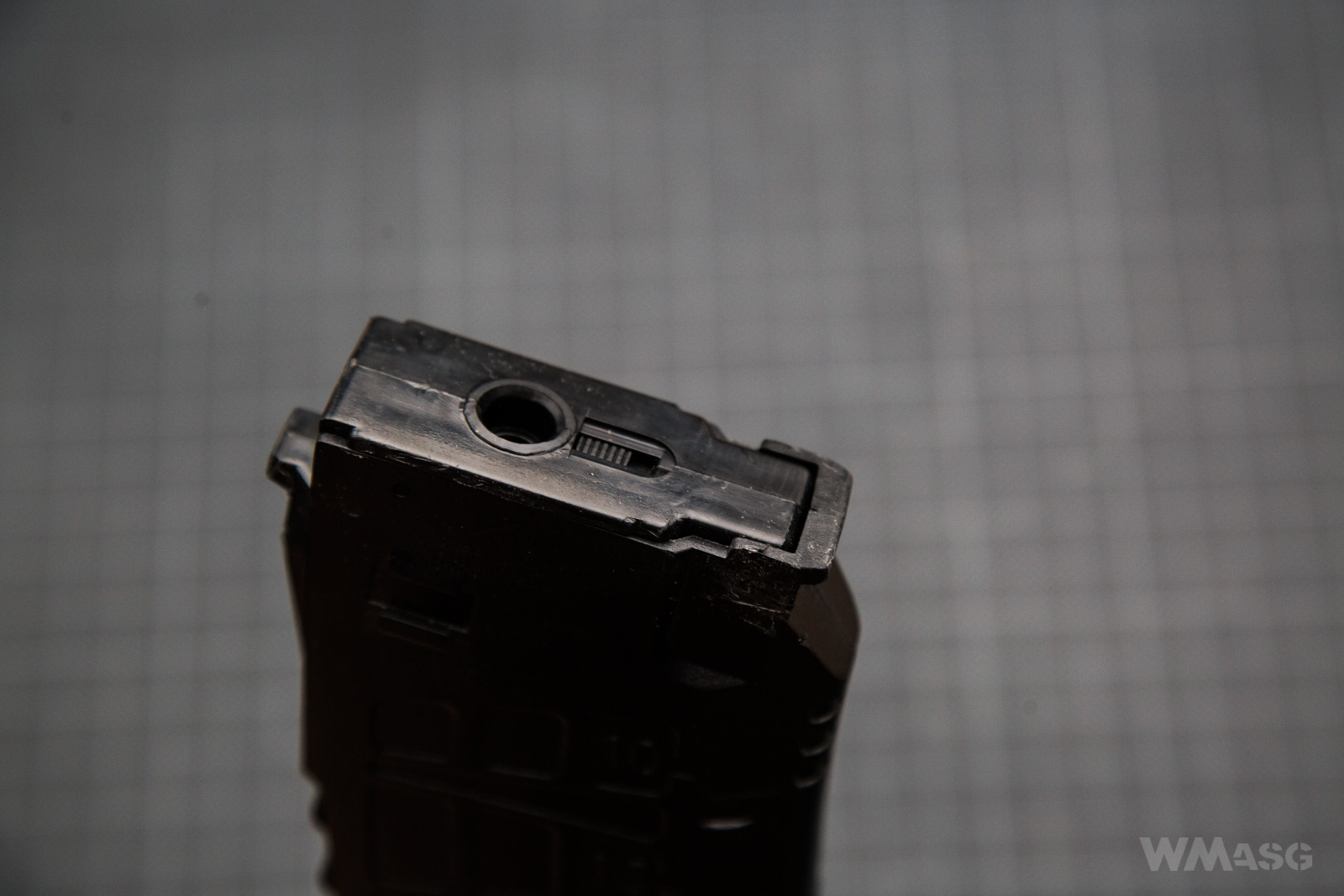
The LCT's offer will soon also include an identically-looking hi-cap magazine holding 450 BBs: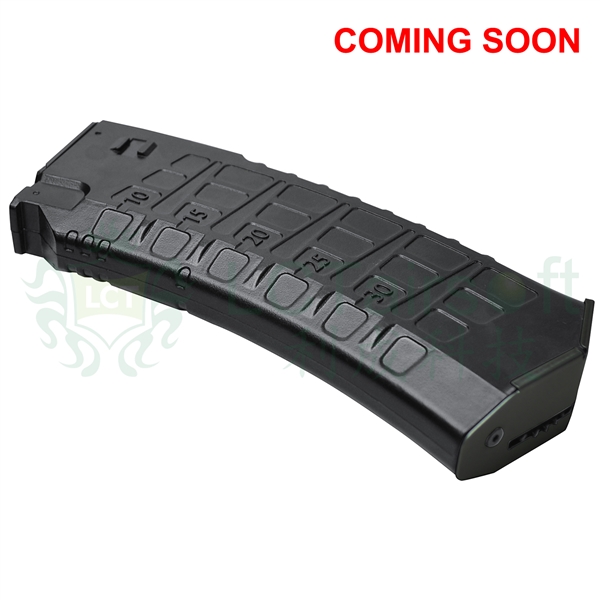
Source: LCT
If we got to the AK-15 for our tests, it would be an identical replica, but with such a magazine holding 130 BBs: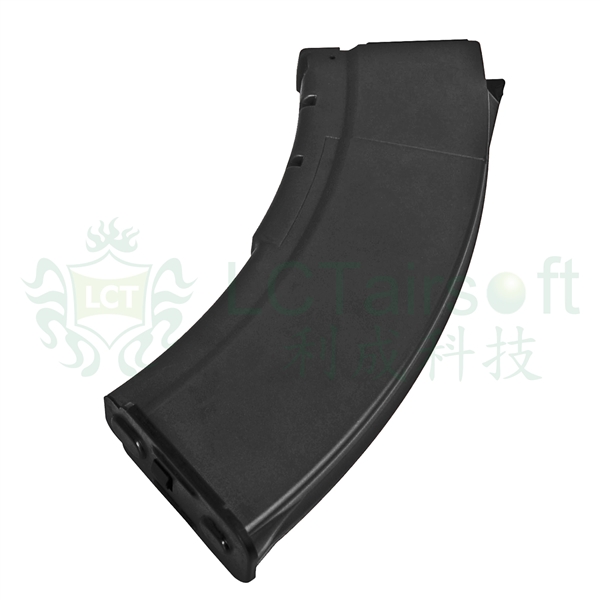
Source: LCT
Of course there will also be identical-looking hi-caps: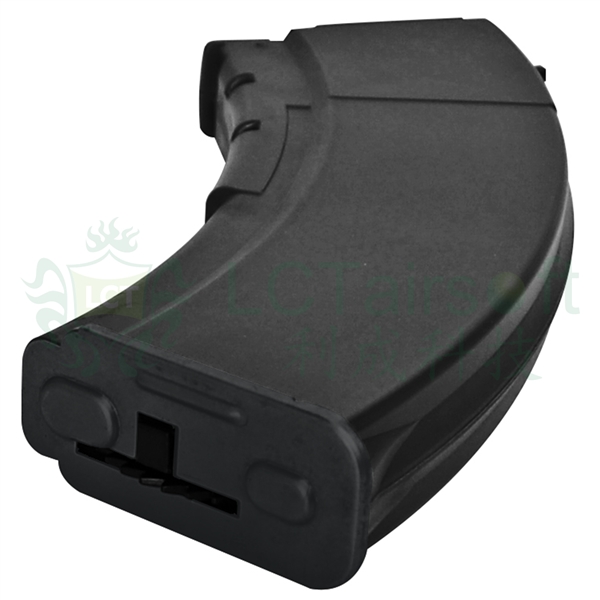
Source: LCT
The internals
Like all AK replicas, the AK-12/AK-15 are built using the V3 gearbox.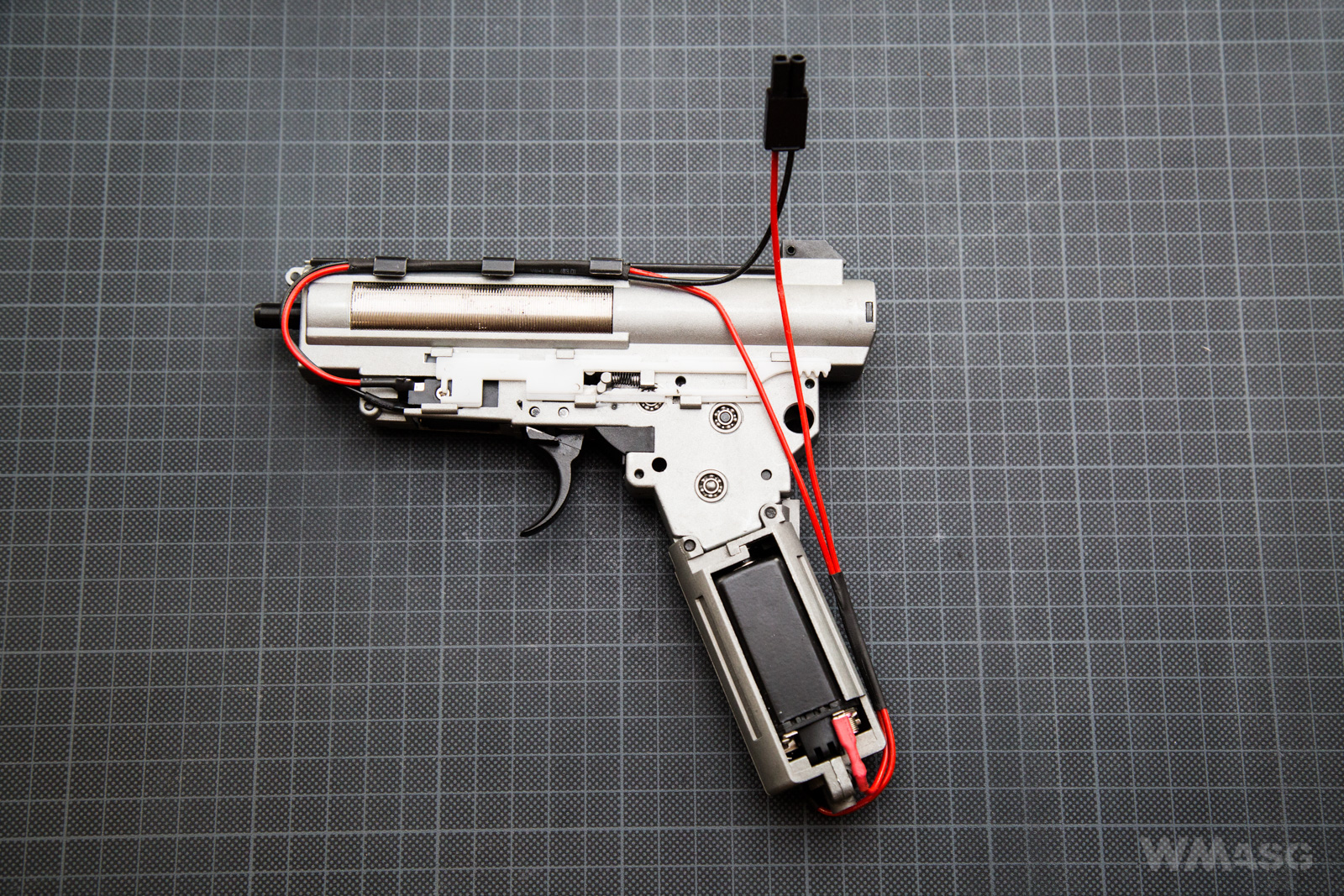 The frame made by LCT looks very robust. The choice of internal parts is standard for this manufacturer. Those include 9 mm ball bearings, steel gears, a piston with full metal teeth, an aluminum bearing piston head, an aluminum cylinder head in a prominent bumper and a spring guide with a ball bearing. It also includes a 19.49 mm long nozzle with an o-ring. All those parts are of very high quality. In my opinion is is safe to say that they can handle at least an M130 spring without any problems.
The frame made by LCT looks very robust. The choice of internal parts is standard for this manufacturer. Those include 9 mm ball bearings, steel gears, a piston with full metal teeth, an aluminum bearing piston head, an aluminum cylinder head in a prominent bumper and a spring guide with a ball bearing. It also includes a 19.49 mm long nozzle with an o-ring. All those parts are of very high quality. In my opinion is is safe to say that they can handle at least an M130 spring without any problems.
Details and photos of internal parts will be described on the next page.
Target shooting test and muzzle velocity measurement
I wrote about my very positive impressions when holding the replica for the first time. Also, shooting with it, despite the slack on the rear sight and the vibrating inner barrel, as you will see in a moment, turned out just fine (that is, as with most stock replicas). However, during the shooting tests I did not like the sound the gearbox made. After closer examination, it turned out that one of the gears was fitted too tightly. A minimum correction of the shimming and motor adjustment has done the trick.
Muzzle velocity measurement test (Open Blaster 0.2 g BBs):
1. 390.0
2. 389.8
3. 389.0
4. 390.4
5. 390.5
6. 390.2
7. 389.4
8. 391.1
9. 393.0
10. 388.5
Average: 390.19 fps
Spread: 4.5 fps
Our measurements coincide with the data contained on the card that came with the replica.
Initial rate of fire (11.1 V 1200 mAh LiPo stick type battery): 17.4 BBs/s.
Rate of fire after correction of the shimming and motor adjustment: 18.6 BBs/s.
Target shooting test
The test was carried out on our own enclosed shooting range, at an ambient temperature of 19oC, the Hop-Up was set to zero. The target shooting test was done using Open Blaster 0.2 g BBs. Distance from the target was 25 m.
Single fire mode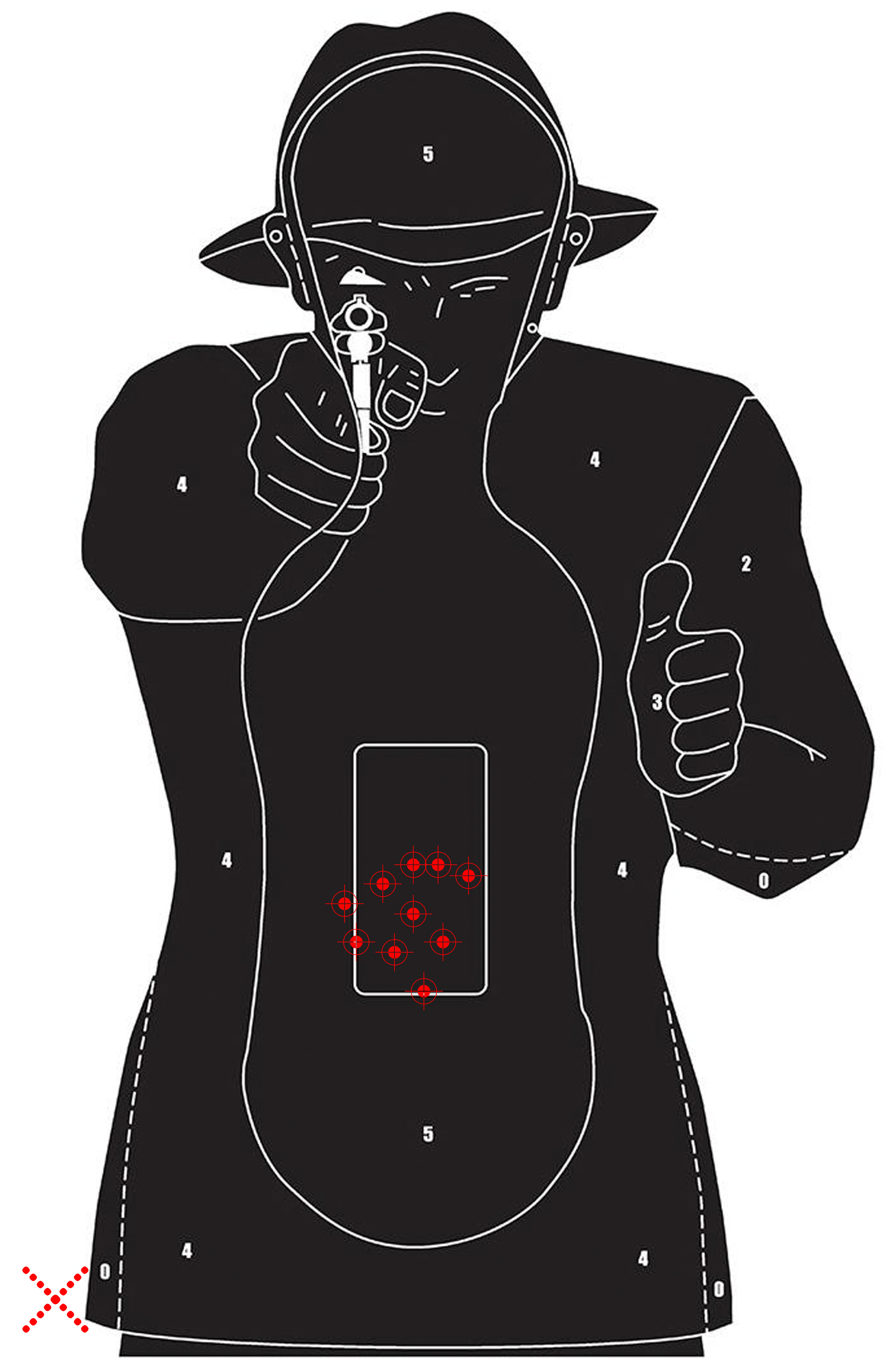
Full-auto mode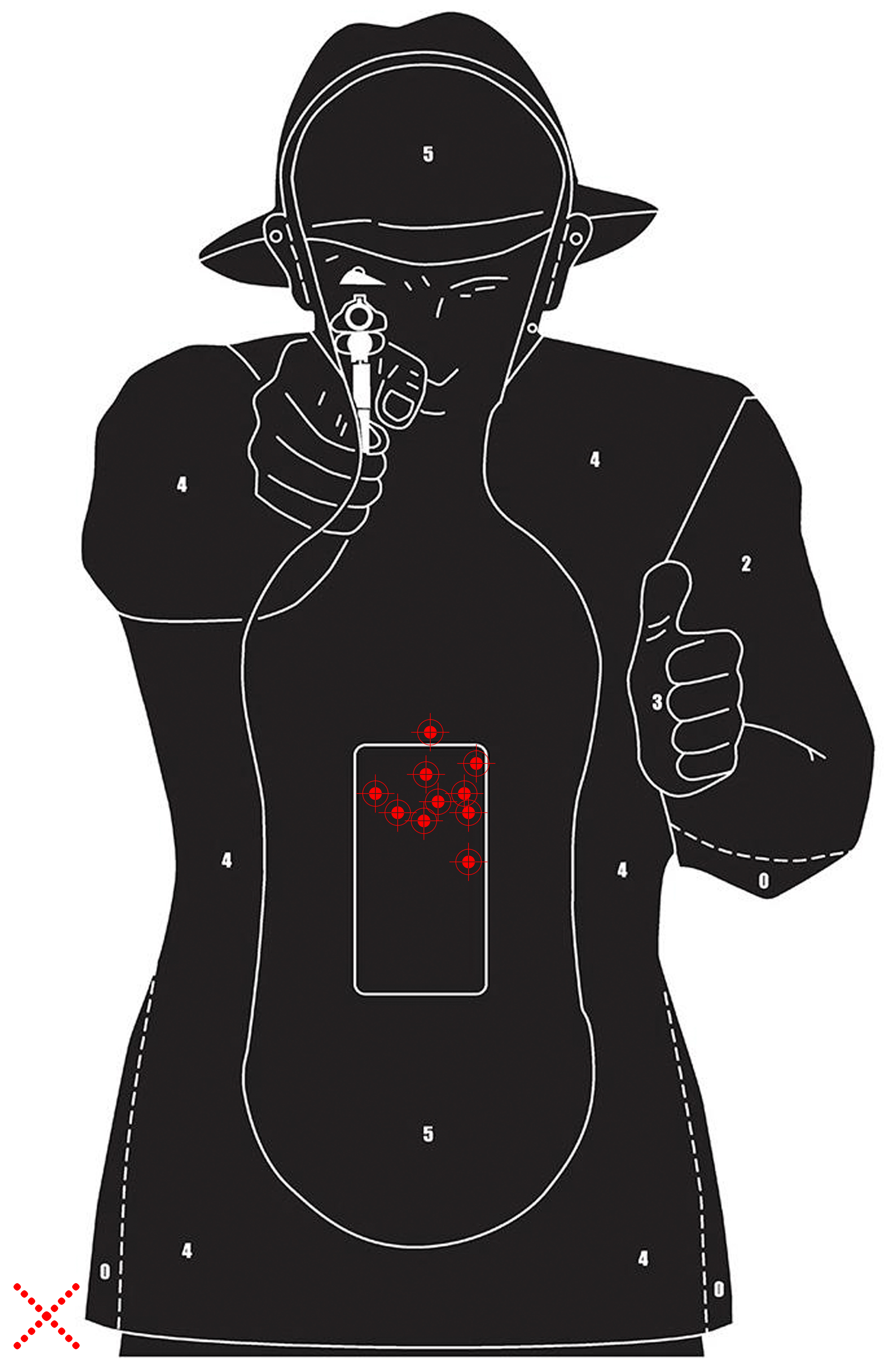
We shot the replica straight "out of the box", without prior shooting at adjustment of the sights. The initial shots did not hit the target. After establishing the proper aiming point (the red X), we managed to fire the right series of shots. In both cases, the spread did not exceed 7 cm.
Summary
The AK-12 is by no means a revolutionary replica. It shoots like other replicas do. Mechanically, it uses solutions that have been known for many years. The internal parts are of very high quality, but this is done by more and more companies. From the outside, the level of workmanship presented by LCT is still out of the reach of most AK replicas manufacturers. As I wrote at the beginning of the text, steel and oxidation are impressive. It is a replica that simply looks great, but it's also exceptionally durable. Fortunately, all the shortcomings that I was able to discover during the tests can be removed by oneself at no additional cost.
So if any of you thinks that it will be possible to by this replica from the test team at a a bargain price - forget about it :)
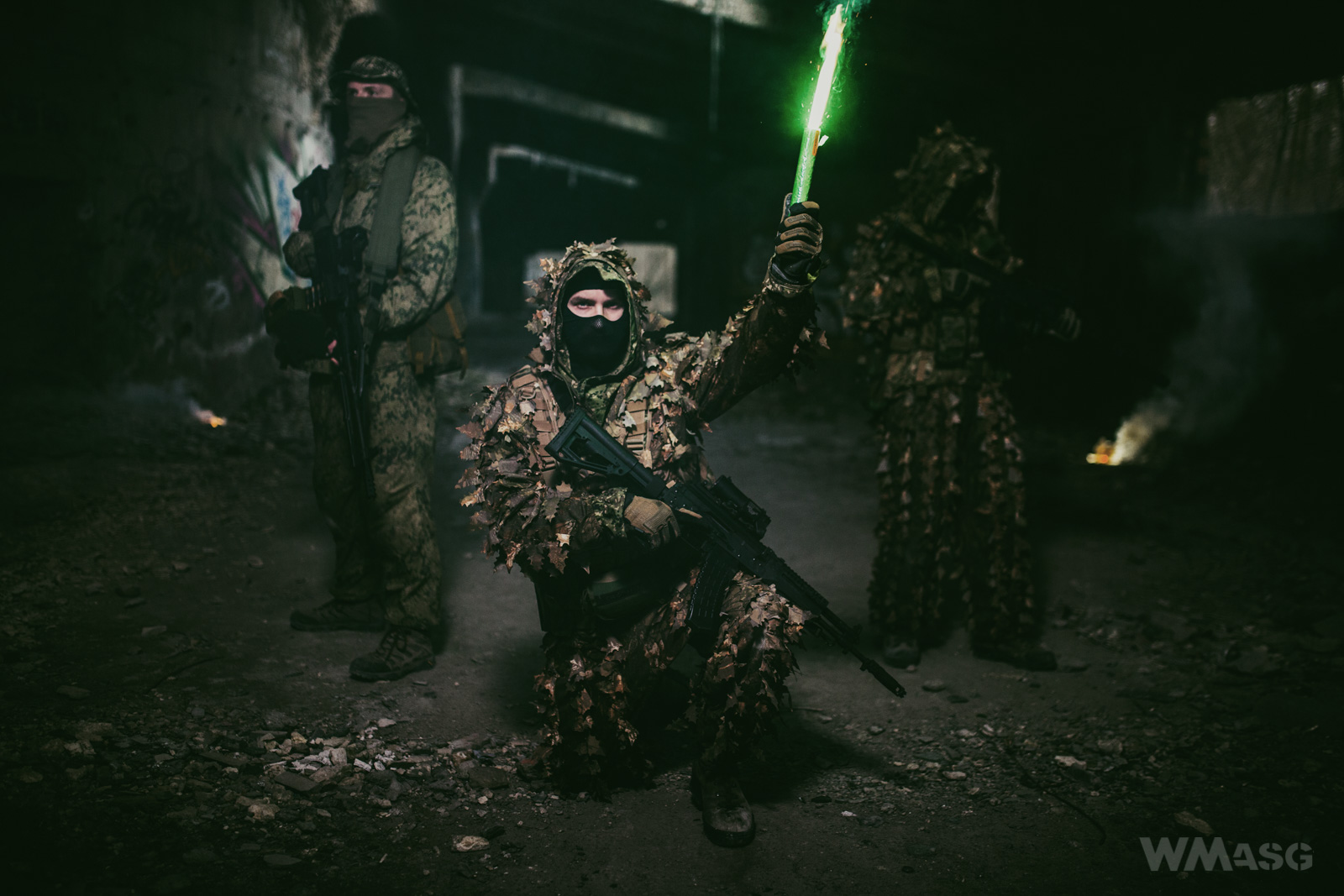
All photos on a white background not signed as LCT Airsoft come from resources of the Kalashnikov group.
On the next page - technical details.

